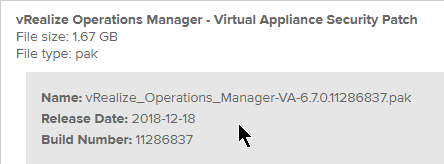Navigation
💡 = Recently Updated
Change Log
Planning
vRealize Operations for Horizon is composed of several components:
- vRealize Operations Manager appliance – this is the same vROps appliance deployed for monitoring of vSphere infrastructures, and hence it can monitor the vSphere clusters that are hosting the Horizon Agents.
- Horizon Adapter for vRealize Operations – this is a .pak file installed on a vROps appliance. The Horizon Adapter receives data from one or more Broker Agents.
- Broker Agent is installed on top of a Horizon Collection Server in each Horizon pod. The Broker Agent collects information from Horizon Connection Servers (e.g. events database), and feeds the data to the Horizon Adapter running on a vRealize Operations Manager appliance. The Broker Agent can also collect data from Unified Access Gateway, and App Volumes.
- vROps Dashboards, Reports, and Alerts for Horizon – these display the information collected by the Horizon Adapter. Installation of the Horizon Adapter .pak file automatically imports the Dashboards, Reports, and Alerts.
The Horizon Adapter and Broker Agent should be the same version.
The vROps Horizon monitoring solution components have different versions:
- vRealize Operations for Horizon Adapter 6.7.0 – Horizon Adapter 6.7.0 is supported to monitor all Horizon versions 7.7.0 and newer. See VMware’s Product Interoperability Matrix for other supported combinations.
- VMware vRealize Operations for Horizon 6.7.0 supports vRealize Operations Manager 8.0.
- vRealize Operations for Horizon Adapter 6.6.0 – Horizon Adapter 6.6.0 is supported to monitor all Horizon versions 7.3.2 and newer. See VMware’s Product Interoperability Matrix for other supported combinations.
- VMware vRealize Operations for Horizon 6.6.0 supports vRealize Operations Manager 7.5, 7.0, and 6.7.
- vRealize Operations Manager 8.0, 7.5, 7.0 or 6.7.0 – See VMware’s Product Interoperability Matrix for other versions of vROPs that are also supported by Horizon Adapter.
vRealize Operations Manager 6.6 and newer has a new HTML5 user interface that looks quite different from vRealize Operations Manager 6.5 and older, thus necessitating a new post. See the post vRealize Operations for Horizon 6.4 for the older vROps user interface, and older Horizon Adapters.
vRealize Operations for Horizon comes with two licenses:
- vRealize Operations Manager Enterprise license – enables vSphere monitoring for Horizon workloads. The license does not entitle vSphere monitoring of non-Horizon workloads.
- vRealize Operations for Horizon Adapter license – enables the Horizon Adapter to collect data from the Horizon Broker Agent for a specific number of Horizon Agent machines. The Horizon 7 Enterprise License can also be used to license the Adapter.
VMware Blog Post Introducing the vRealize Operations Sizing Tool and https://vropssizer.vmware.com/sizing-wizard/choose-installation.
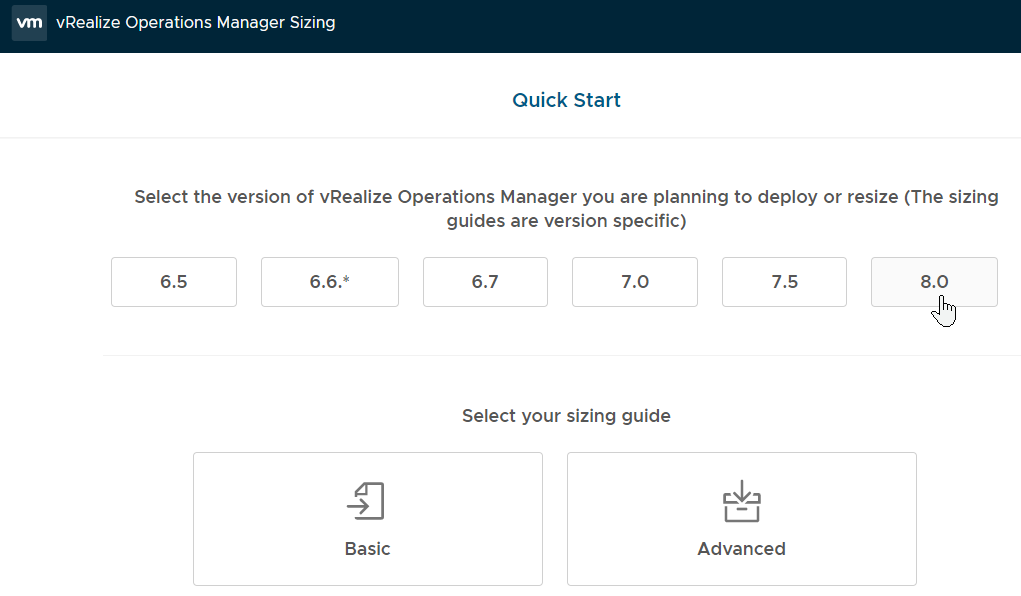
VMware 2093783 vRealize Operations Manager Sizing Guidelines:
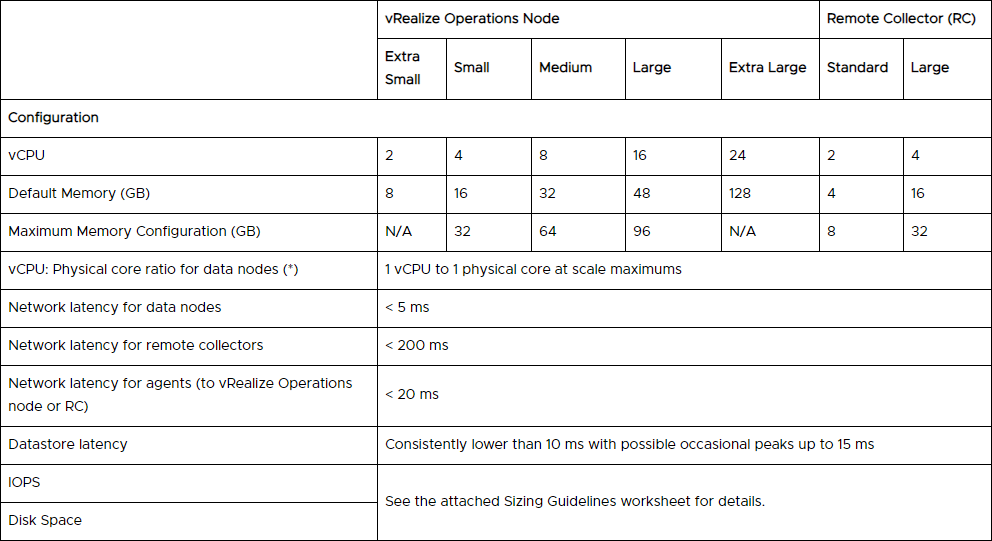
Links to descriptions of new features in vRealize Operations Manager 6.6 and newerfupgra:
If you have Log Insight, there’s also a Content Pack for Horizon View. See VMware Blog Post Horizon View Content pack for vRealize Log Insight
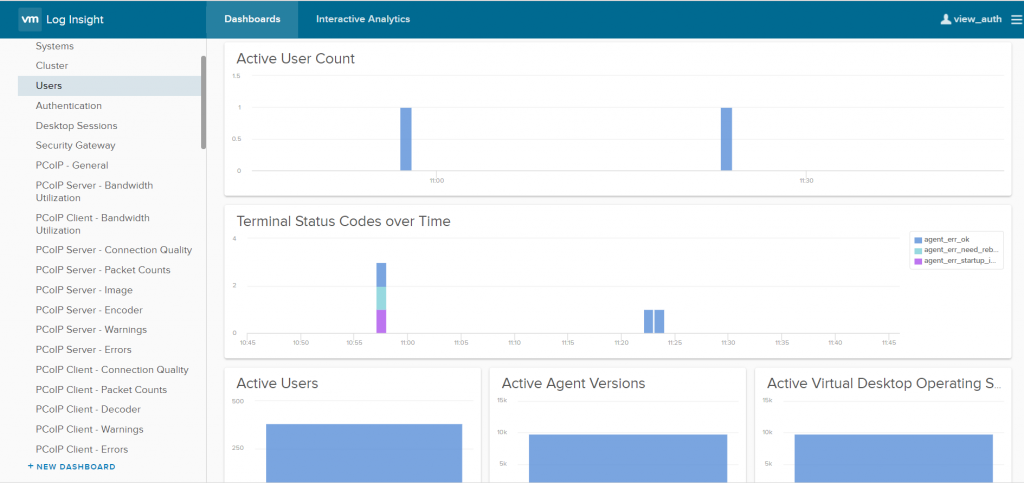
Deploy New vROps Appliance
If you are upgrading an existing vROps appliance, skip ahead to the Patch/Upgrade Appliance section.
For new installations of vROps, download the following:
- See VMware’s Product Interoperability Matrix to determine which combinations of vROPs and Horizon Adapter are compatible with your version of Horizon. Also see the 6.7.1 Adapter Release Notes.
- 6.7.1 Adapter supports VMware Horizon 7.7 or later
- 6.7.1 Adapter requires vRealize Operations Manager 8.0 or later
- 6.7.1 Adapter supports VMware App Volumes 2.14.8 to 2.18
- 6.7.1 Adapter supports VMware Unified Access Gateway 3.6 and later
- If vRealize Operations Manager for Horizon 6.7.1, then download vRealize Operations Manager 8.0 from the vRealize Operations Manager for Horizon 6.7.0 download page.
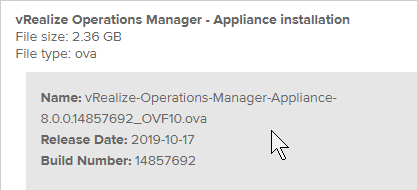
- If vRealize Operations Manager for Horizon 6.6.0, download vRealize Operations Manager 7.5 – Appliance installation.
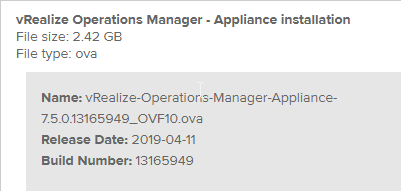
- If vROps 7.0, go to the VMware vRealize Operations Manager 7.0.0 download page and download the security patch. It’s the top entry named vRealize Operations Manager – Virtual Appliance Security Patch and dated 2018-12-18.
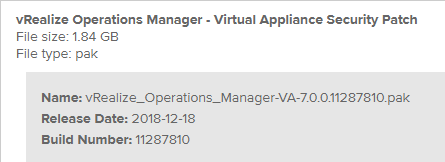
To deploy a new vROps appliance:
- In vSphere Web Client, navigate to a Cluster, right-click it, and click Deploy OVF Template.
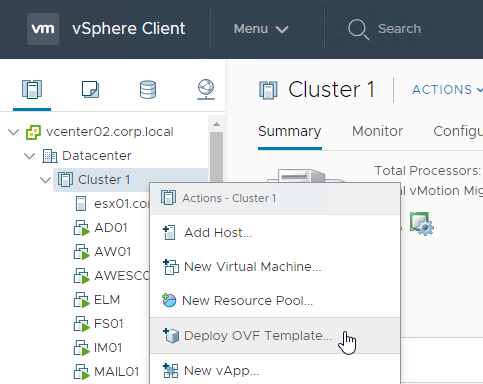
- In the Select an OVF template page, select Local file, browse to the vRealize Operations Manager .ova file, and click Next.
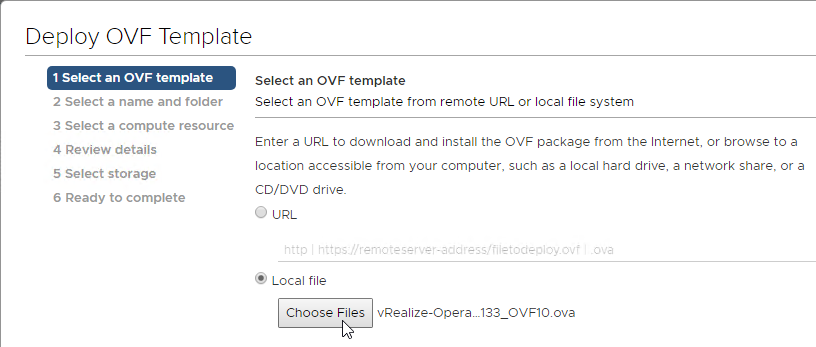
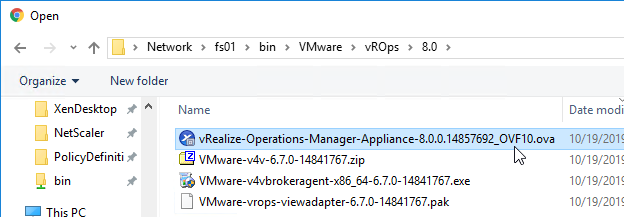
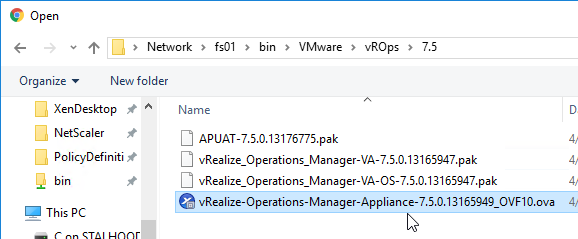
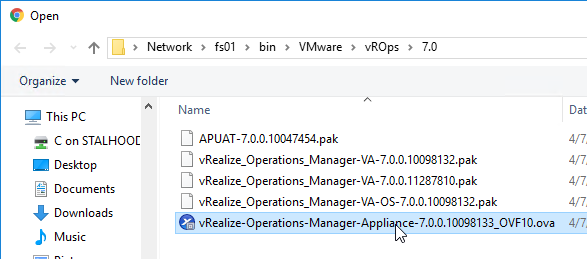
- In the Select a name and folder page, give the VM a name, and click Next.
- In the Select a compute resource page, select a cluster, and click Next.
- In the Review details page, click Next.
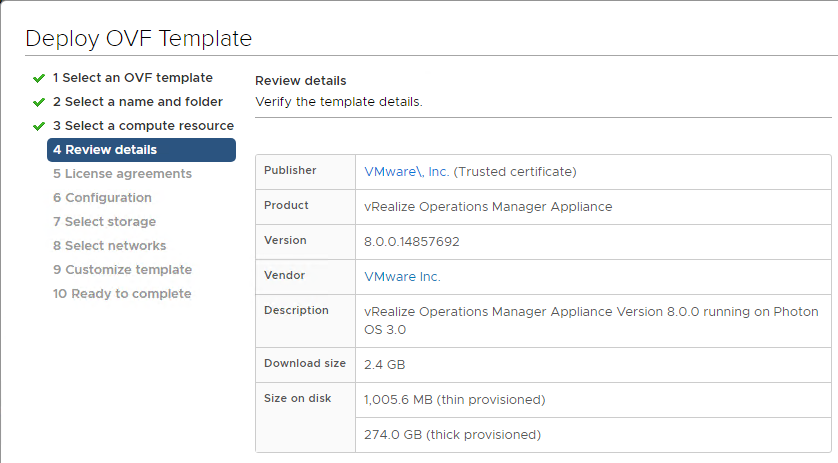
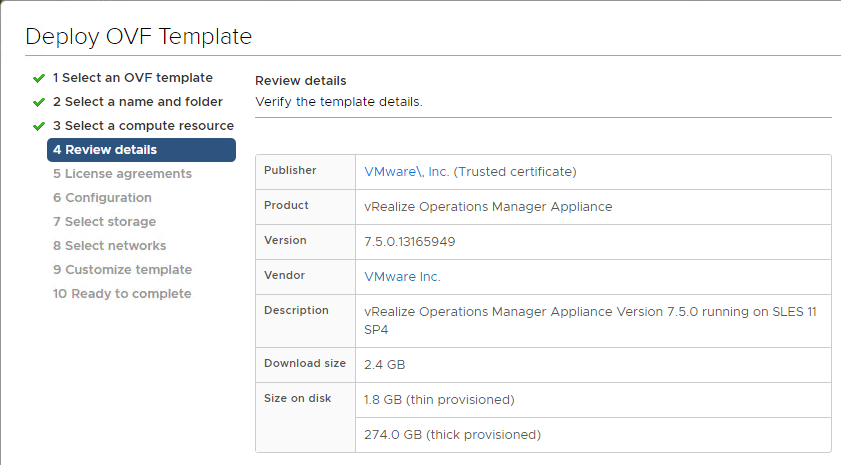
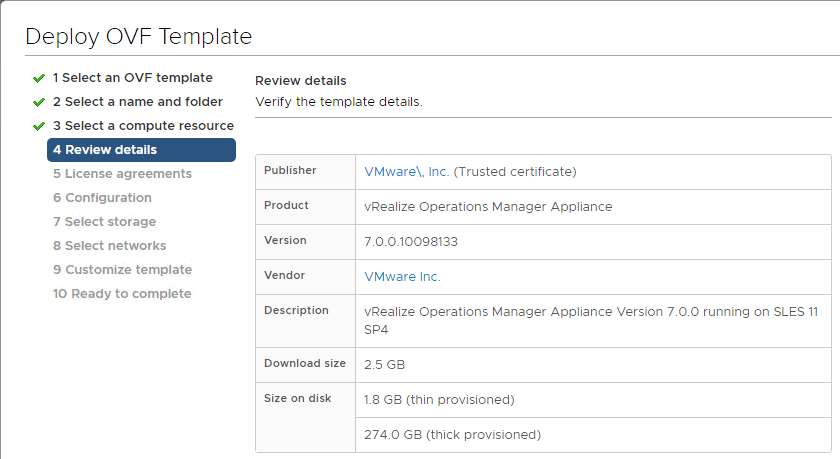
- In the License Agreements page, check the box next to I accept all license agreements, and then click Next.
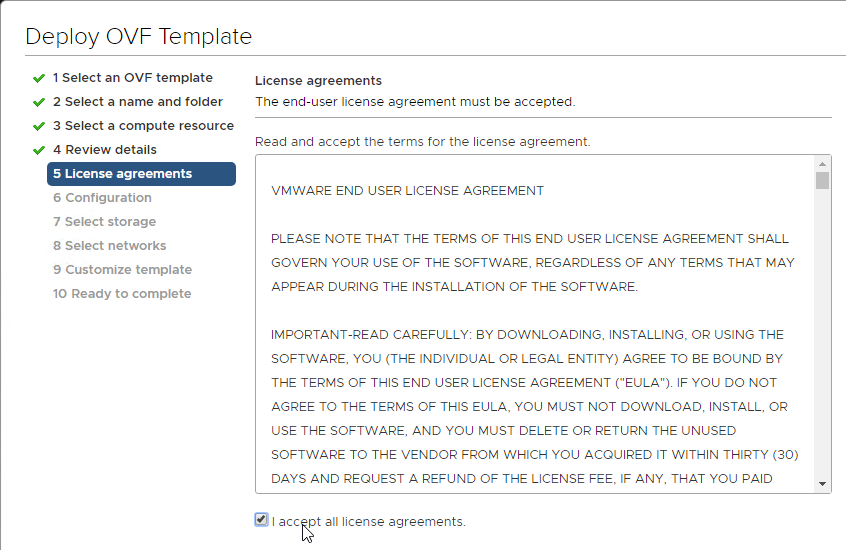
- In the Configuration page, select a size, and then click Next.
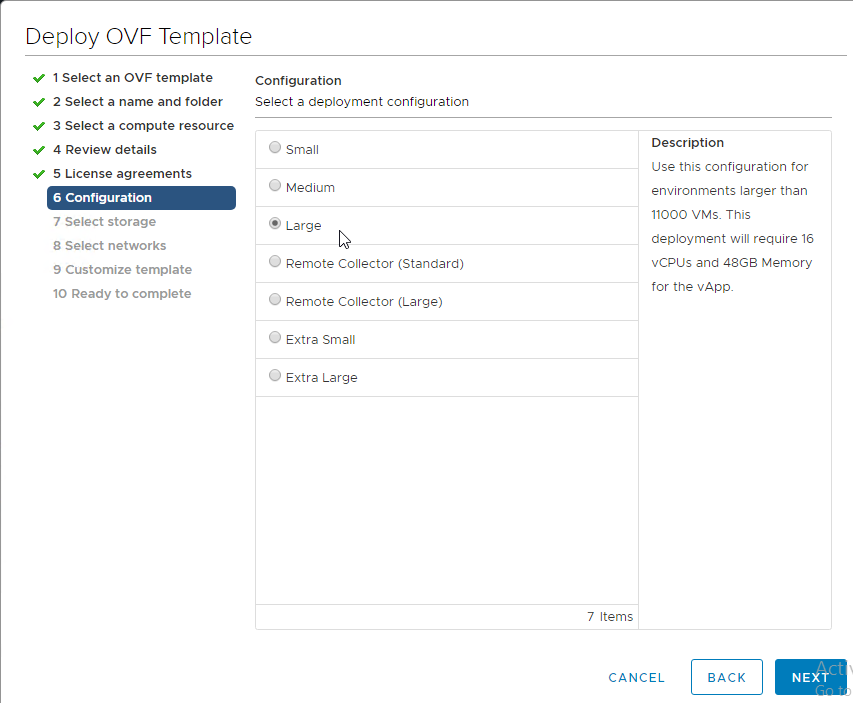
- In the Select Storage page, select Thin Provision, select a datastore, and then click Next.
- In the Select networks page, select a port group, and click Next.
- In the Customize template page:
- Select a time zone.
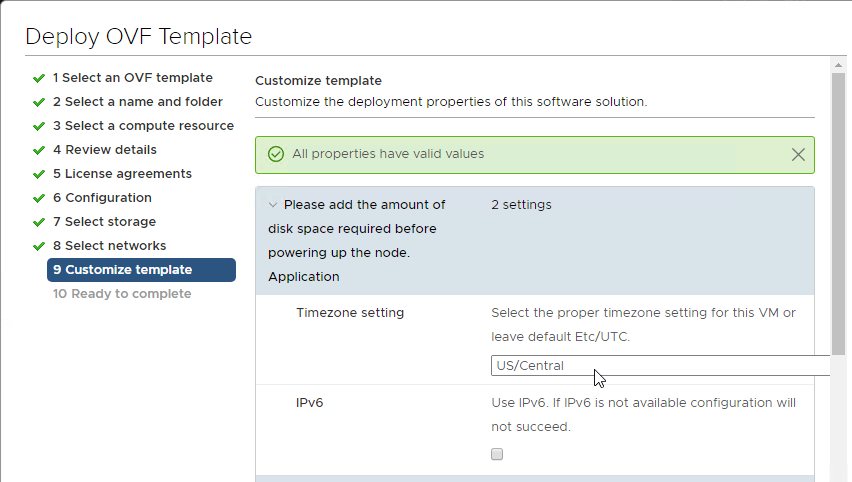
- Enter the IP address information for the appliance.
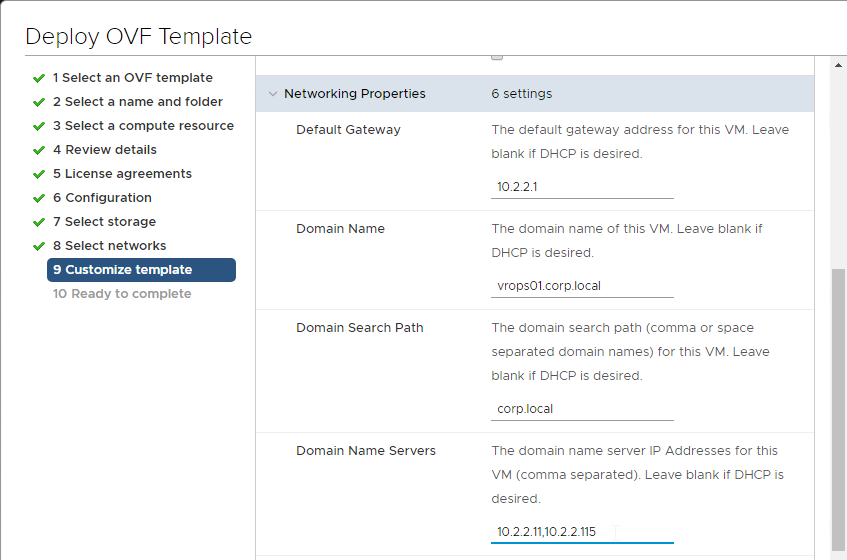
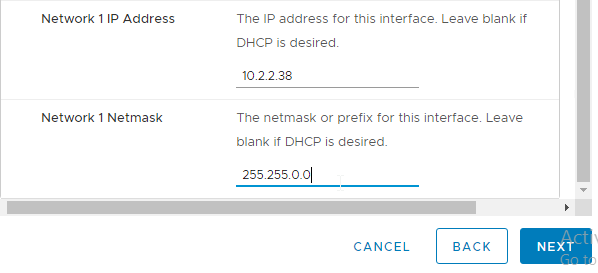
- Then click Next.
- In the Ready to Complete page, click Finish.
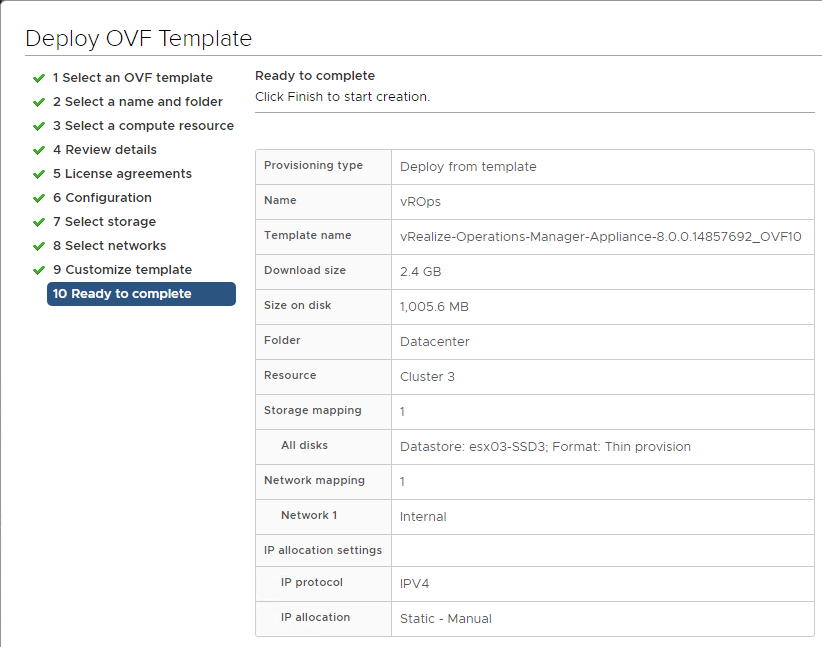
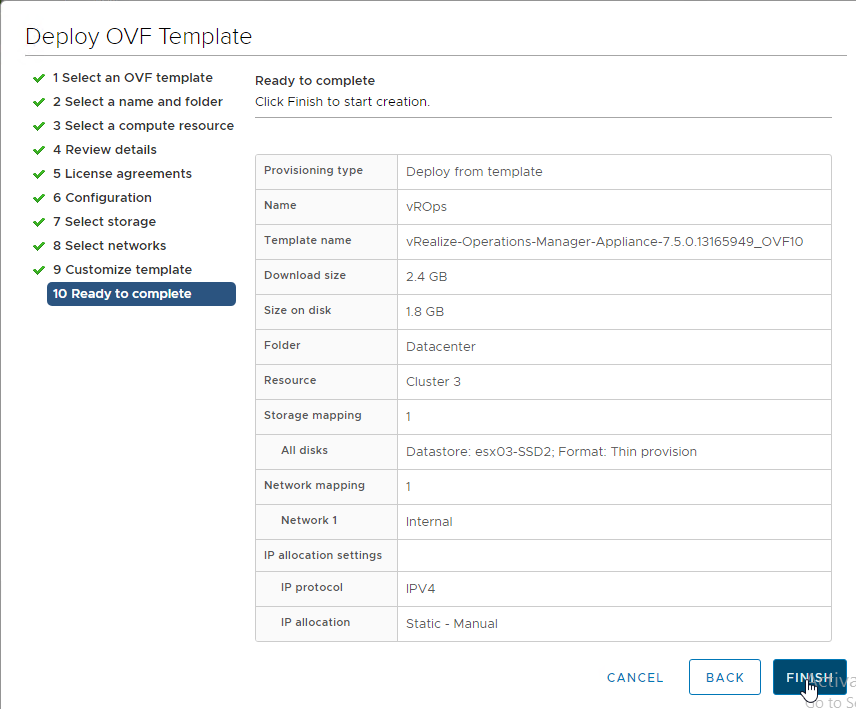
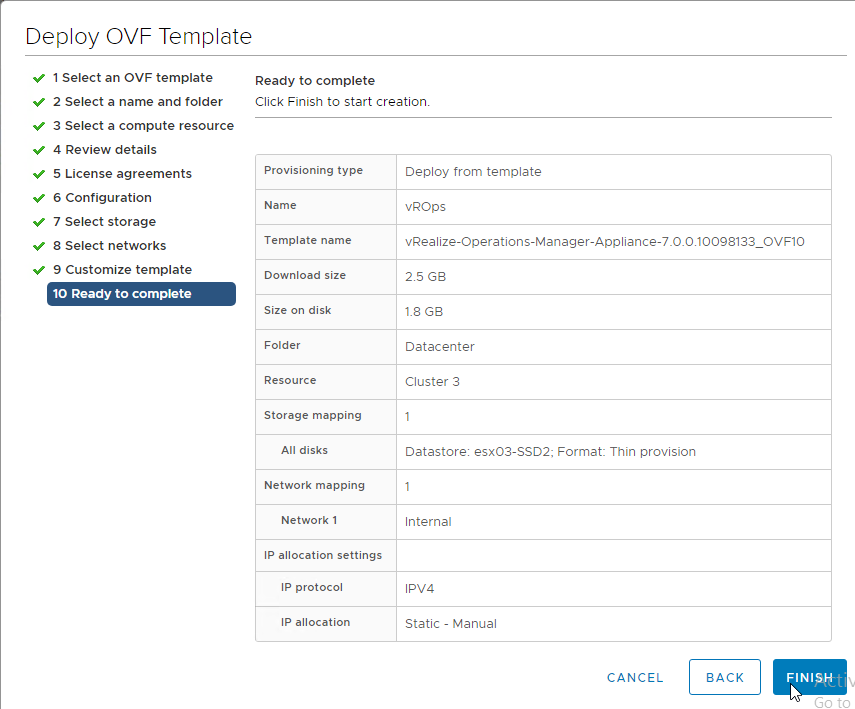
Create vROps Cluster
If you are upgrading an existing vROps appliance, skip ahead to the Patch/Upgrade Appliance section.
- Power on the new vROps virtual appliance.
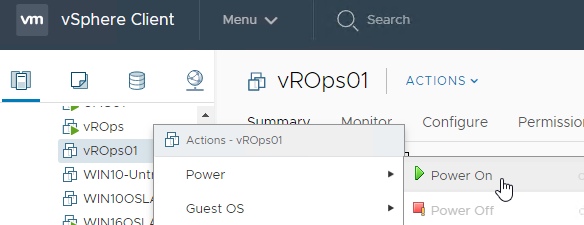
- Wait for the appliance to start.
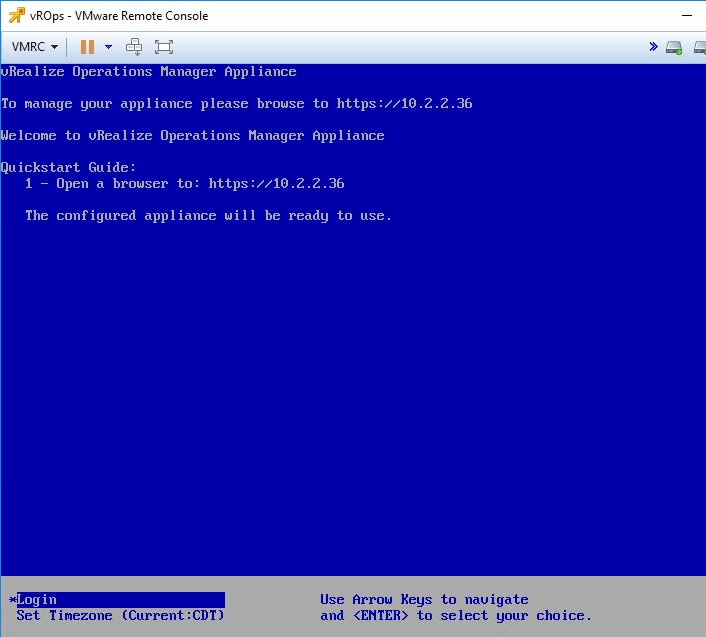
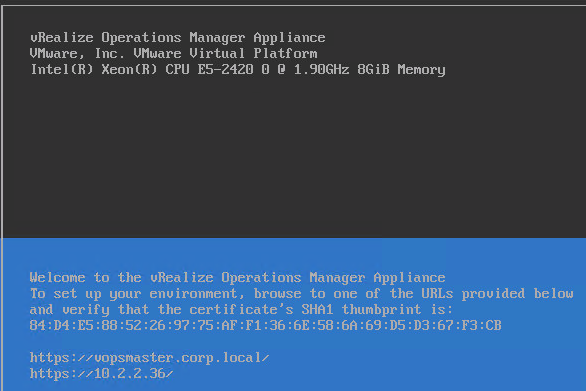
- Use a browser to go to https://IPAddress/admin. If you see a Service unavailable message, wait a couple minutes and try again.

- On the bottom of the page, click New Installation.
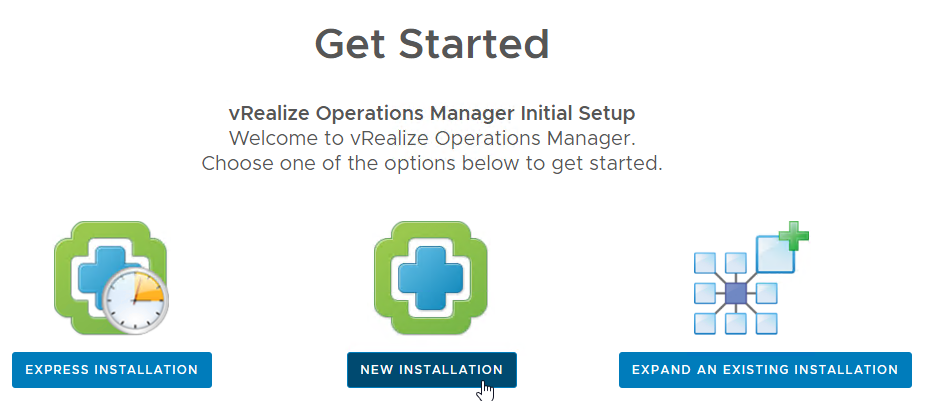
- In the Getting Started page, click Next.
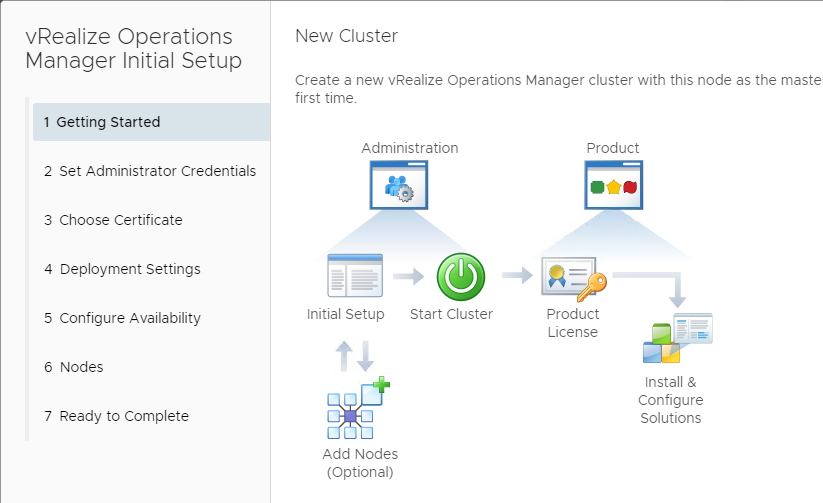
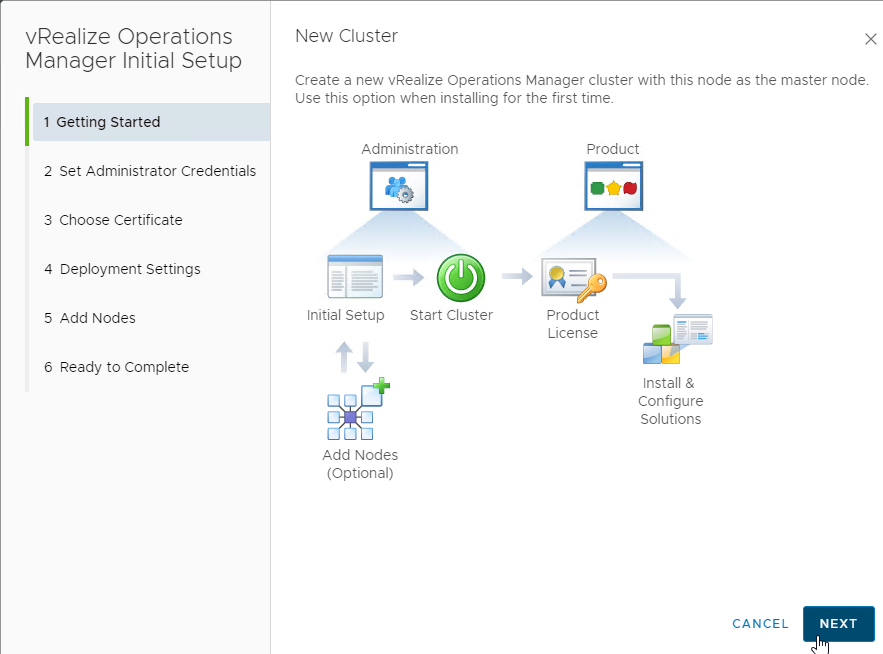
- In the Set Administrator Password page, enter a password based on the listed requirements. Click Next.
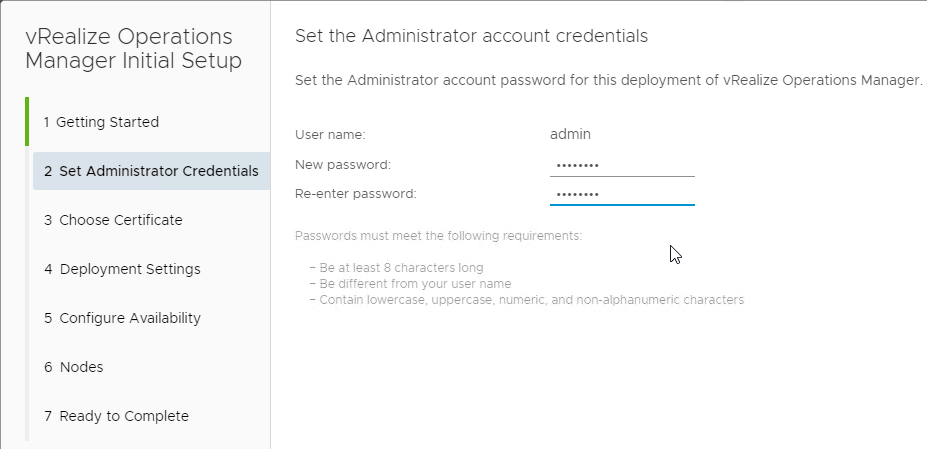
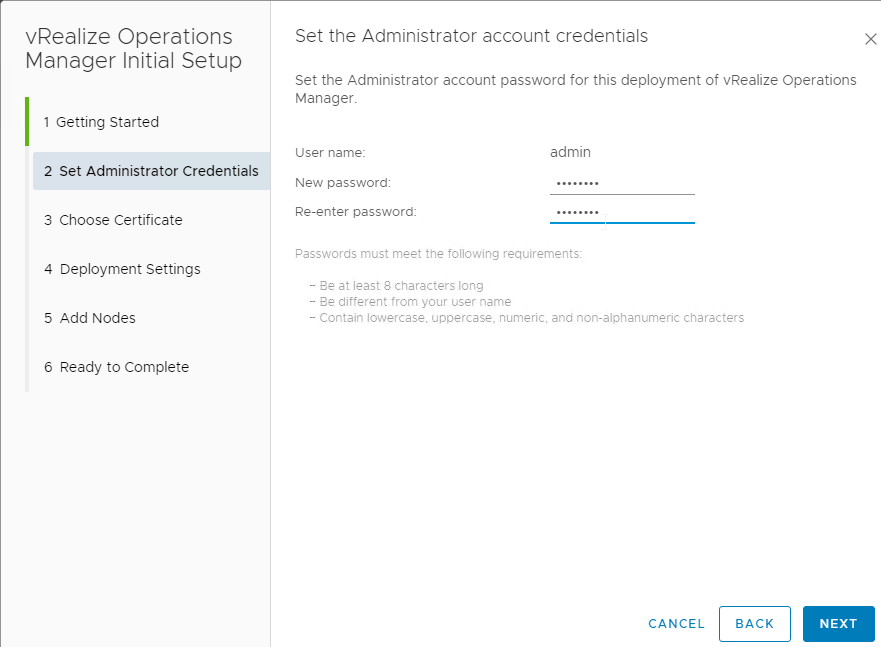
- In the Choose Certificate page, you can upload a PEM certificate.
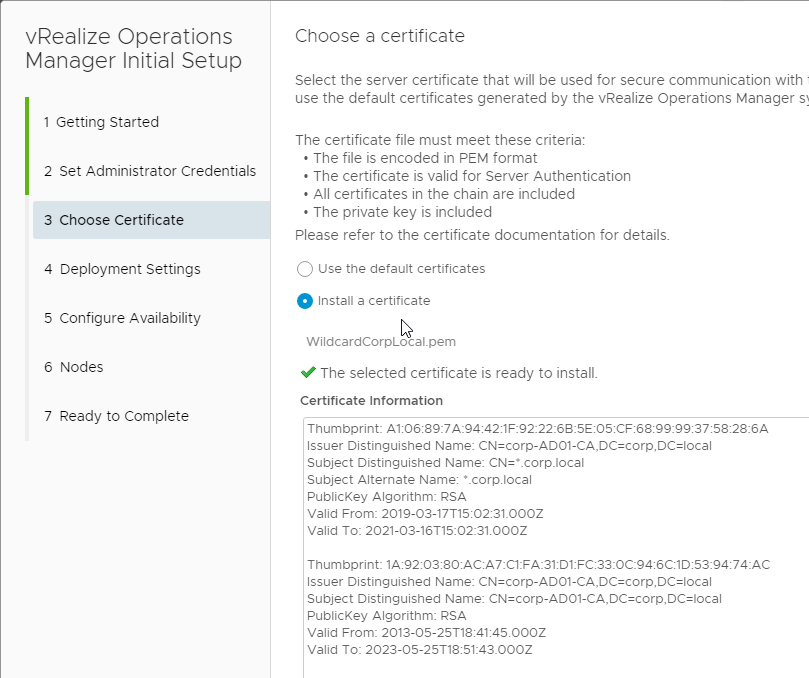
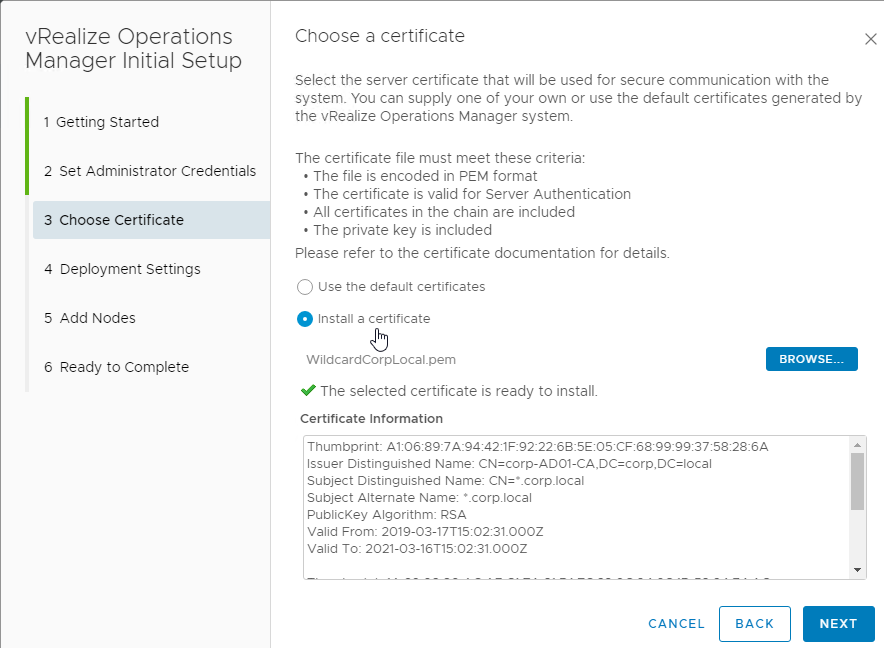
- The Certificate file must have .pem extension. It will not accept any other extension.
- Make sure the certificate file has both the certificate and keyfile combined into a single file.
- If there are intermediate Certificate Authorities, add them to the PEM file. CA certificates go below the server certificate.
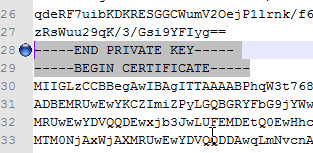
- Click Next when done.
- In the Deployment Settings page:
- Enter a name for the master node.
- Enter a NTP Server Address, and click Add.
- Then click Next.
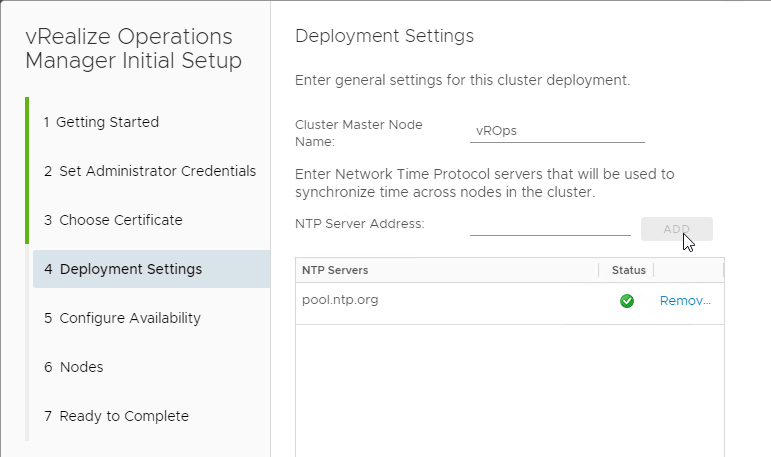
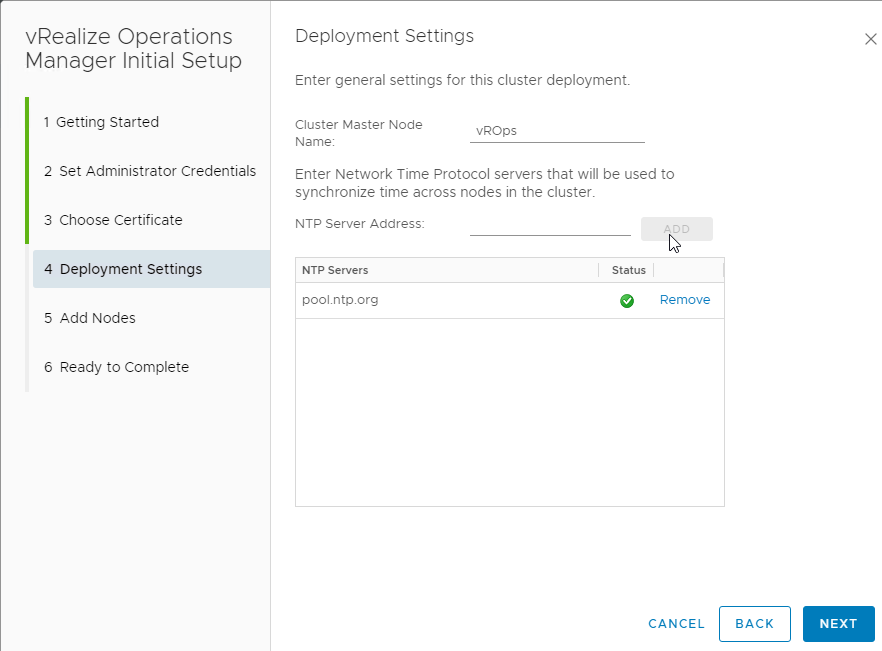
- In vRealize Operations Manager 8.0 and newer, you can optionally select an Availability Mode. Click Next.
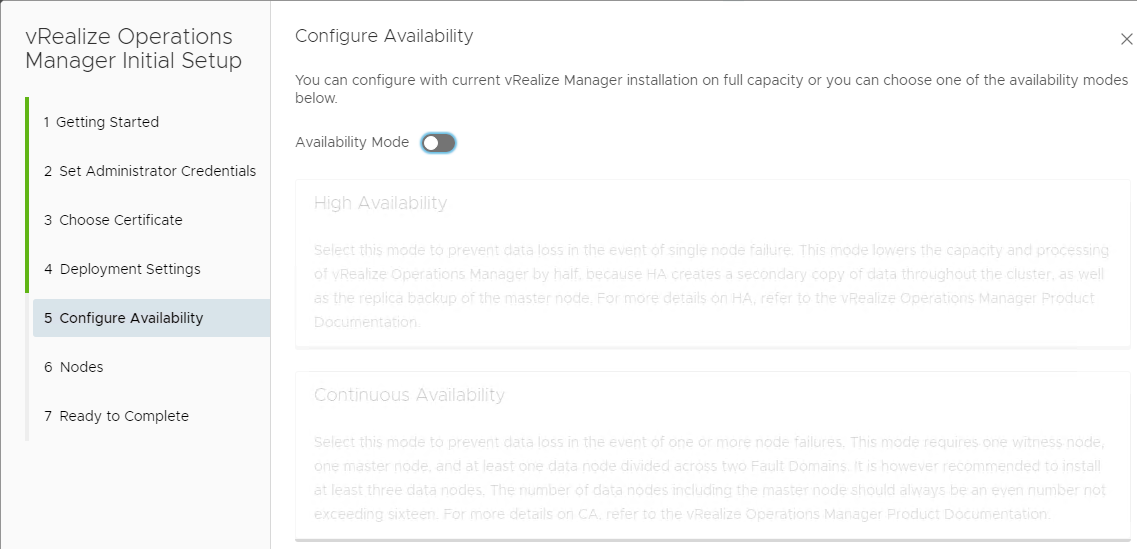
- In the Add Nodes page, you can optionally add Remote Collector nodes. Click Next when done.
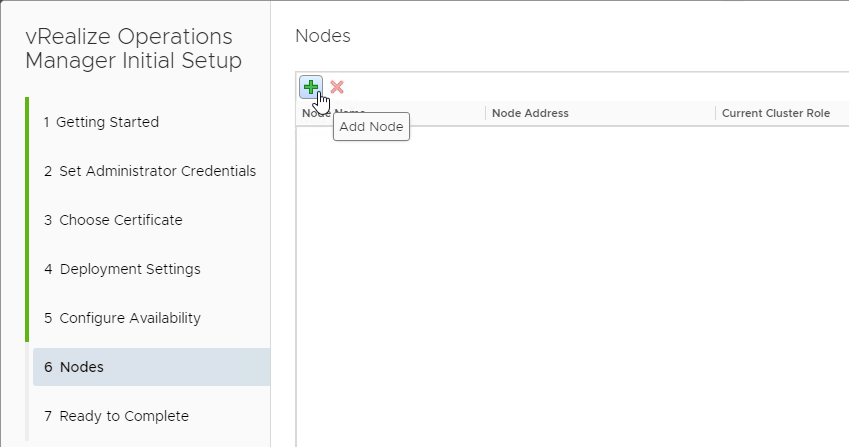
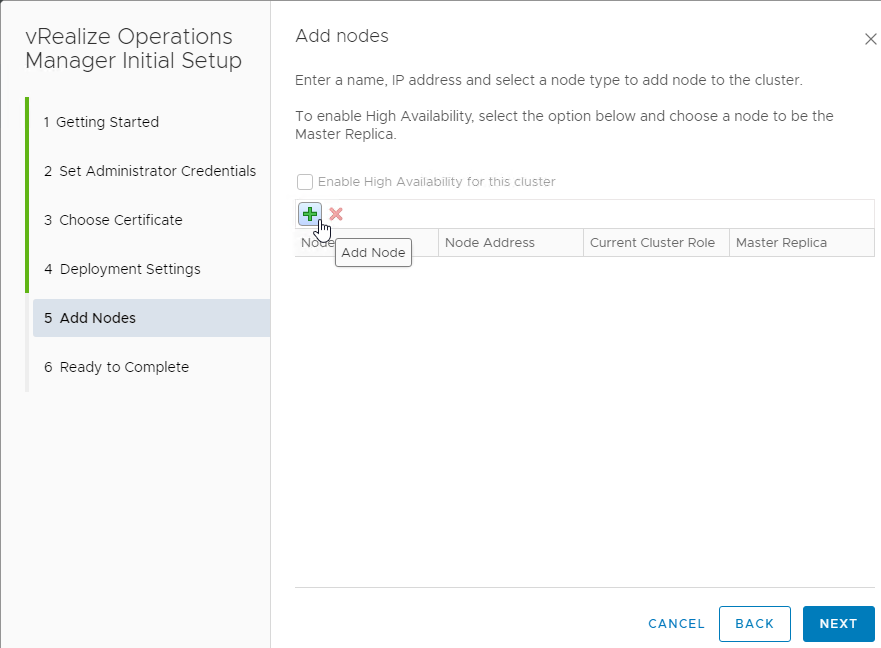
- In the Ready to Complete page, click Finish.
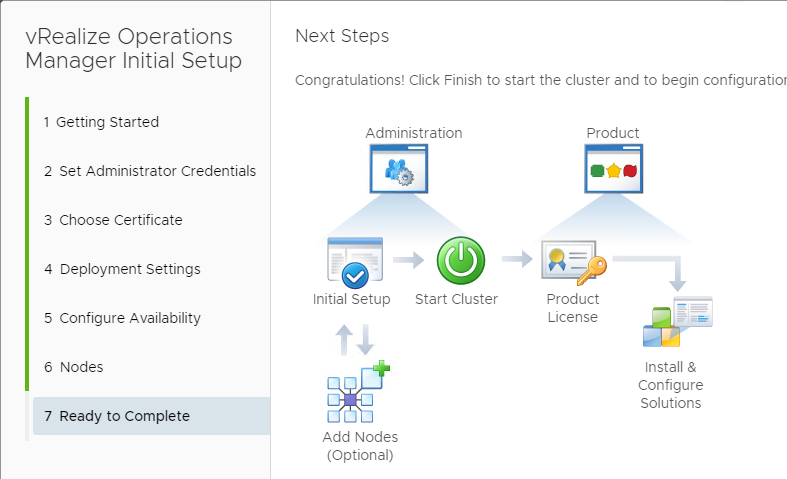
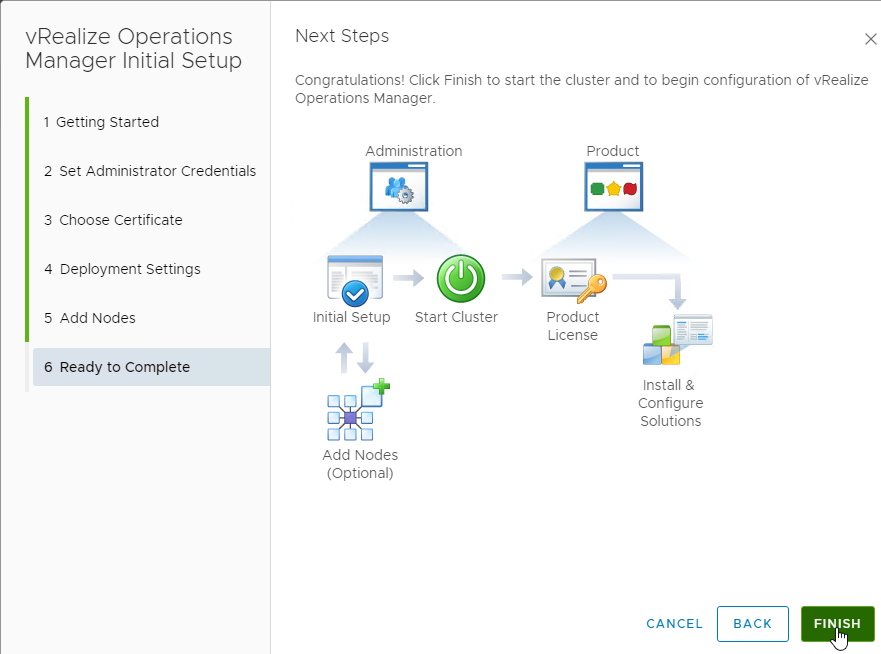
Start Cluster
- From the https://IPAddress/admin page, click the button labelled Start vRealize Operations Manager.
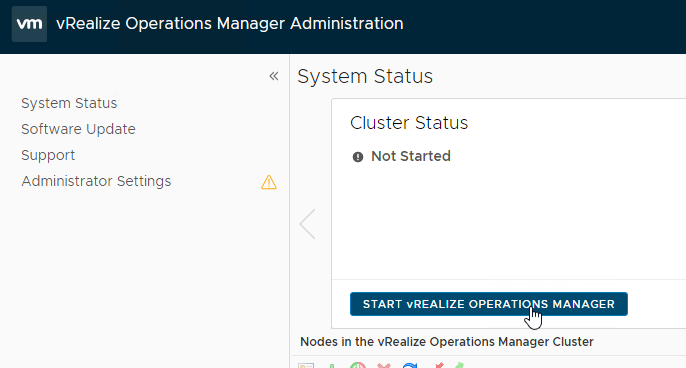

- Click Yes. This will take several minutes.
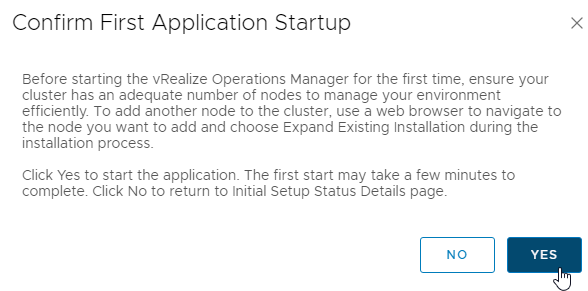
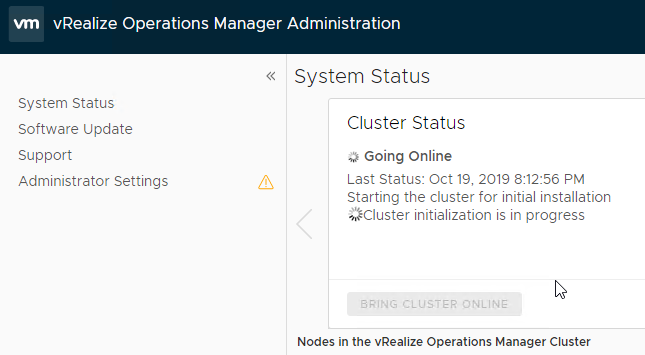
- Log into the appliance using the admin account.
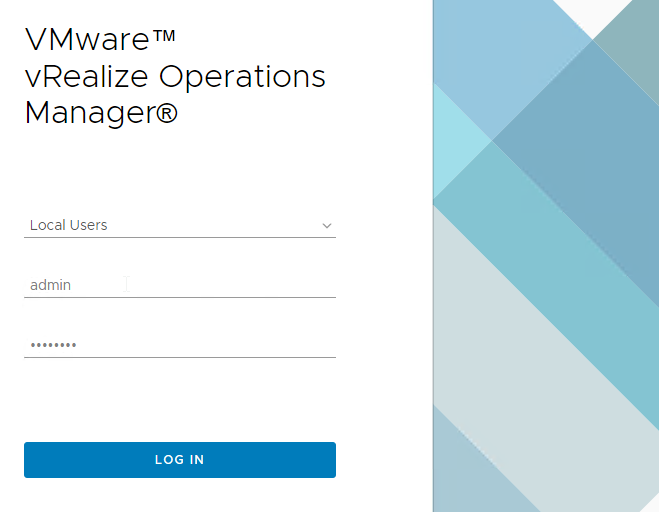
- On the Welcome page, click Next.
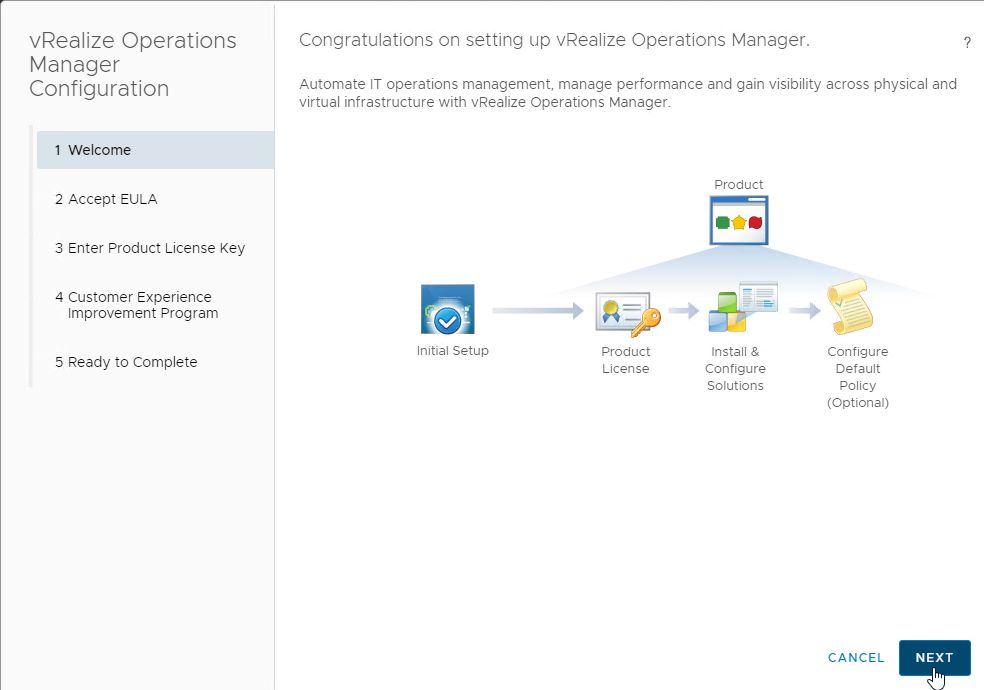
- In the Accept EULA page, check the box next to I accept the terms, and click Next.
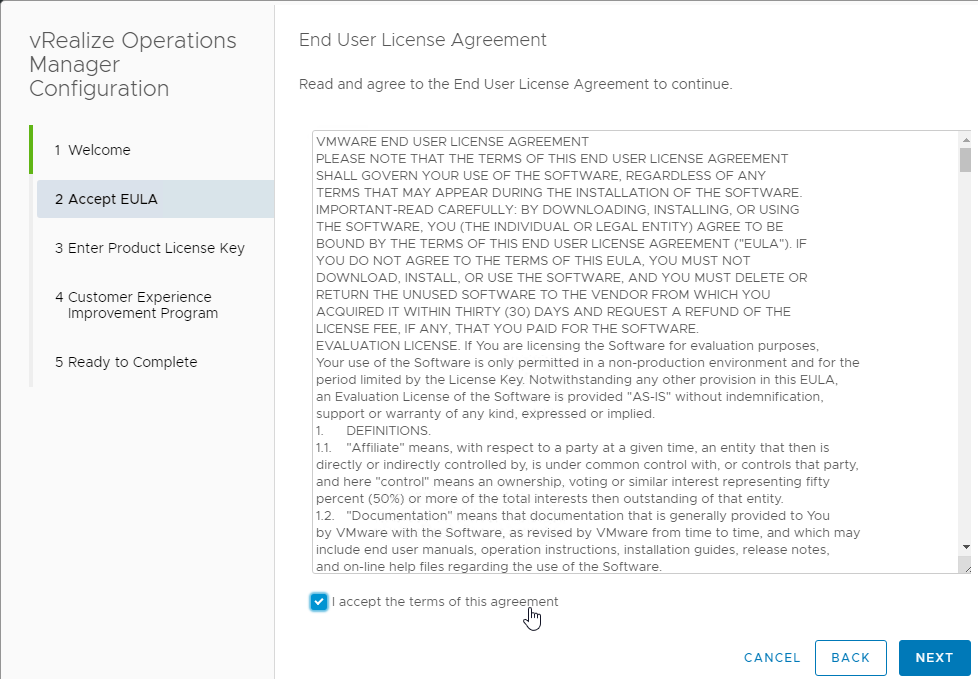
- In the Enter Product License Key page, enter the vRealize Operations Manager for Horizon license key, click Validate License Key, and click Next. Note: there is a separate license for the Horizon Adapter that will be entered later.
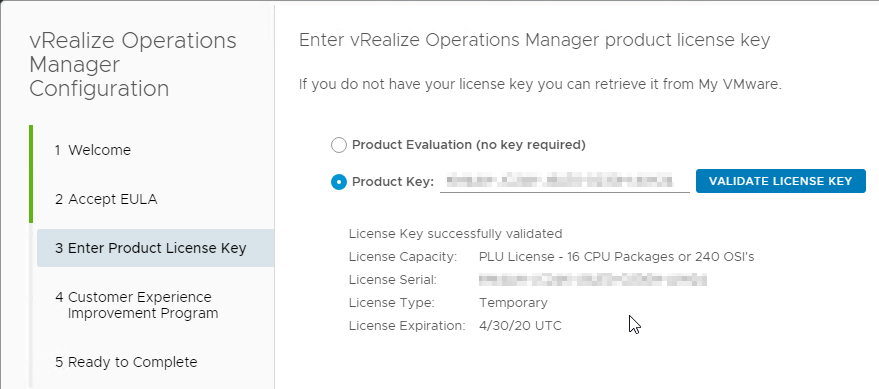
- In the Customer Experience Improvement Program page, make a choice, and click Next.
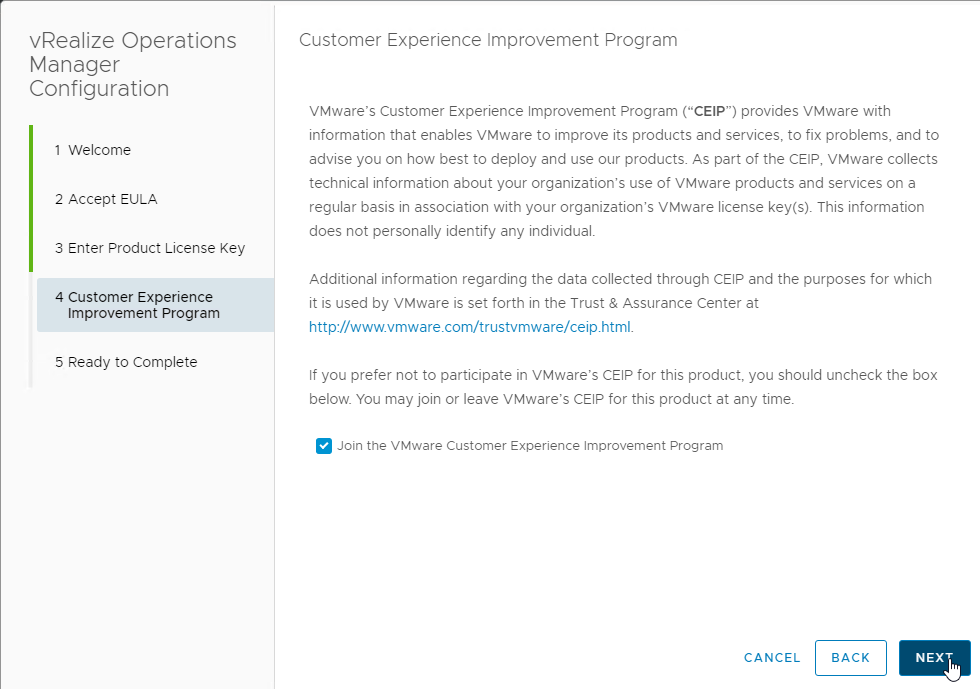
- In the Ready to Complete page, click Finish.
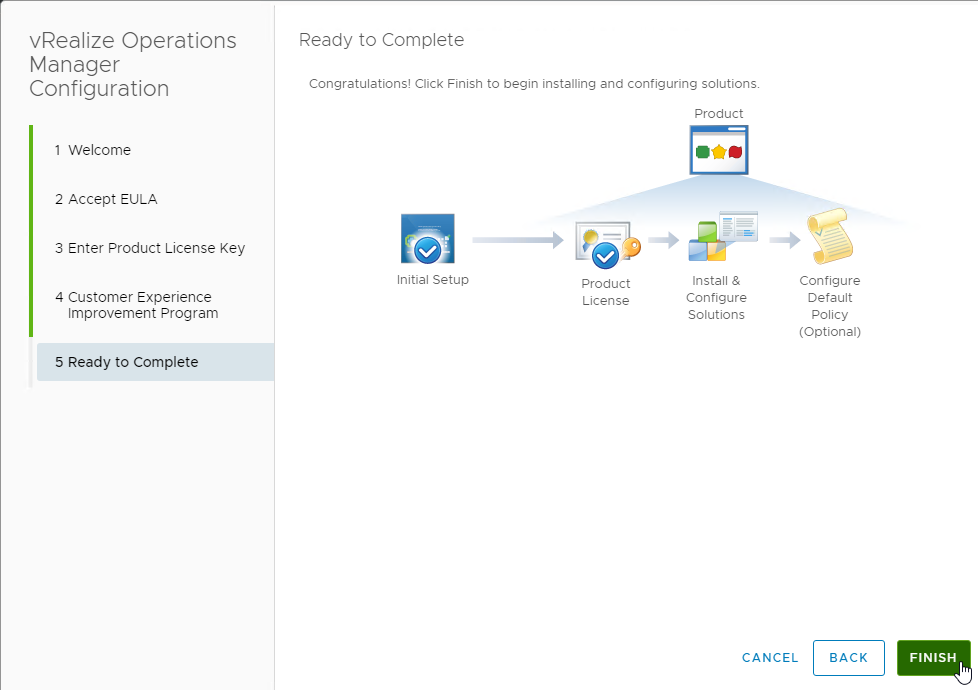
Patch/Upgrade vROps Appliance
Download Patch
To patch a vROps appliance, download the latest patch from the vROps download page.
The vROps security patch for vROps Manager 6.7 or vROps Manager 7.0 is required for Horizon Adapter 6.6.0. There is no security patch for vROps 7.5.
- Go to the VMware vRealize Operations Manager 7.0.0 download page or VMware vRealize Operations Manager 6.7.0 download page.
- Download the security patch. It’s the top entry named vRealize Operations Manager – Virtual Appliance Security Patch and dated 2018-12-18. You’ll install this after vROps is upgraded.

Download Version Upgrade
If you are upgrading vROps from an older version, download the following:
- Go to the VMware vRealize Operations 8.0 download page, VMware vRealize Operations Manager 7.5 download page, VMware vRealize Operations Manager 7.0.0 download page, or VMware vRealize Operations Manager 6.7.0 download page.
- Download the Upgrade Assessment Tool.
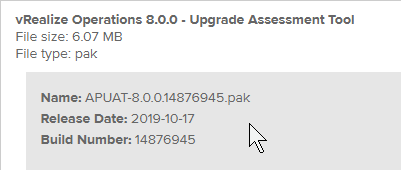
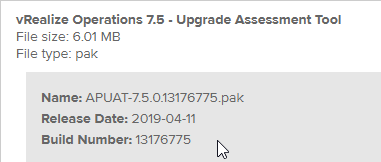
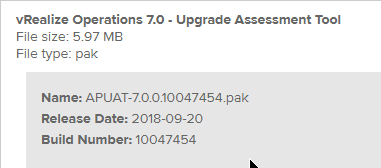
- For vRealize Operations Manager 7.5 and older, download the Virtual Application Operating System upgrade. You’ll install this patch first. vRealize Operations Manager 8.0 no longer has a separate download for Operating System upgrade.


- Download the Virtual Appliance upgrade. You’ll install this after you upgrade the operating system.
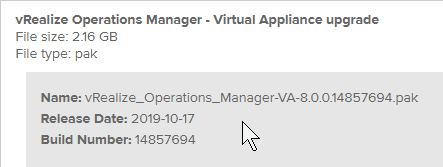
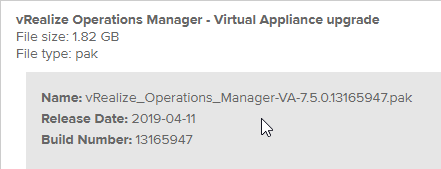
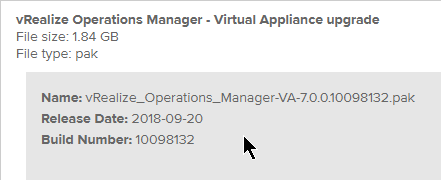
- For vROps 7.0, download the security patch. It’s the top entry named vRealize Operations Manager – Virtual Appliance Security Patch and dated 2018-12-18. You’ll install this patch after vROps is upgraded.

Install Patch or Upgrade vROps
Do the following to upgrade the vROps appliance or install a patch. You might have to perform this procedure several times to complete the upgrade. Also see Brandon Lee Upgrade to VMware vRealize Operations Manager 7.5.
- Use a browser to go to https://vROpsIP/admin, and login as admin.
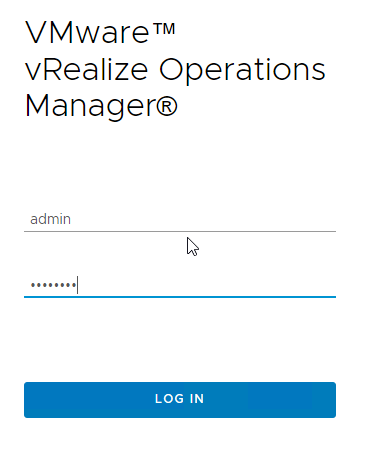
- On the left, switch to the Software Update page.
- On the right, click Install a Software Update.
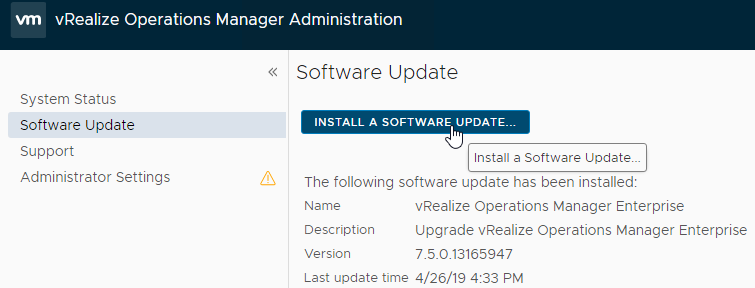
- Click Browse and browse to an upgrade or Security Patch .pak file downloaded from vmware.com.

- If you are upgrading from an older version of vROps, then you must upgrade install several .pak files in a specific order:
- Start with the Upgrade Assessment Tool, which is the file named APUAT.
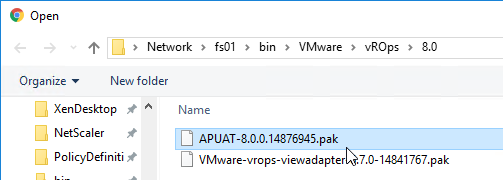
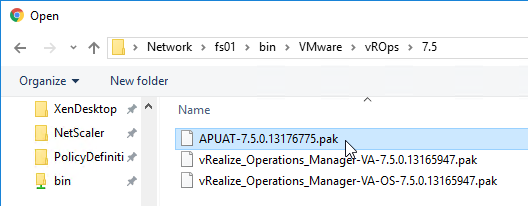
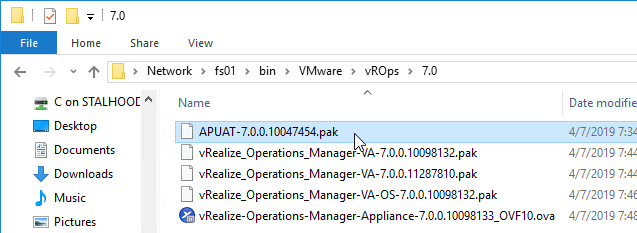
- For vRealize Operations Manager 7.5 and older, upgrade the operating system, which is the file with VA-OS in the name. This step is not needed in vRealize Operations Manager 8.0 and newer.
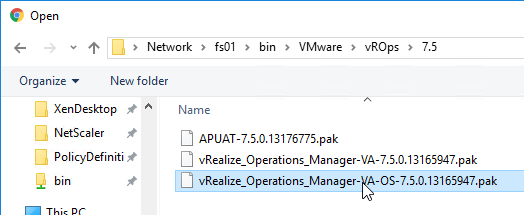

- Then upgrade the vROps virtual appliance by installing the .pak file with VA in the name but without OS in the name.
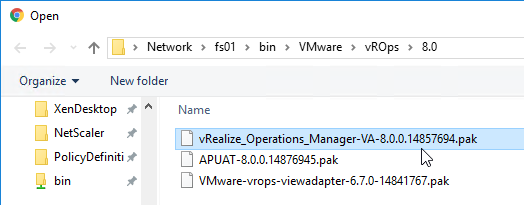
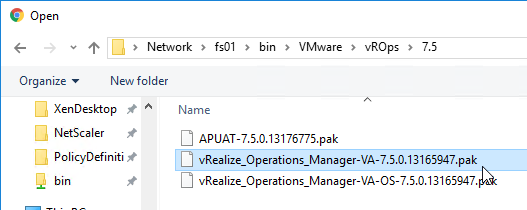
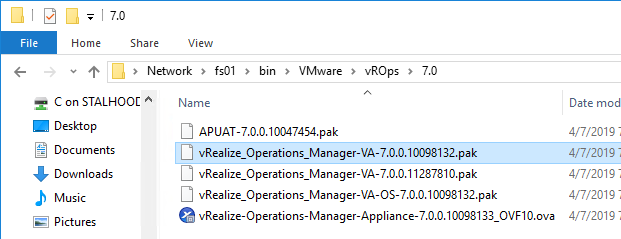
- Finally, for vROps 7.0, install the security patch.
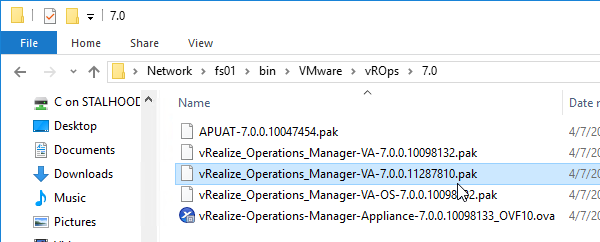
- If you are not upgrading the vROps version, and if vROps Manager 6.7 or 7.0, then simply install the Security Patch.
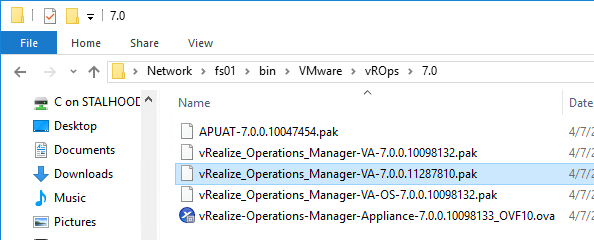

- Click Upload. Uploading and staging will take a bit of time.
- Upgrading to 8.0 – separate OS upgrade is no longer needed:
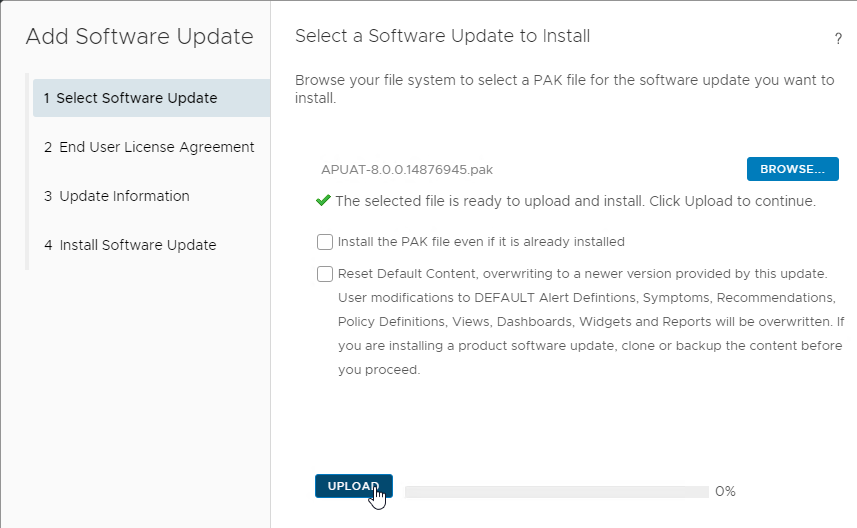
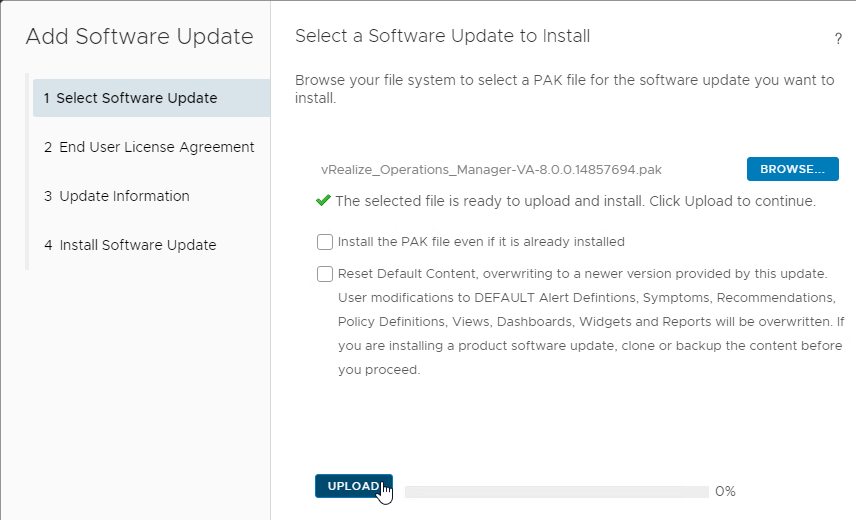
- Upgrading to 7.5:
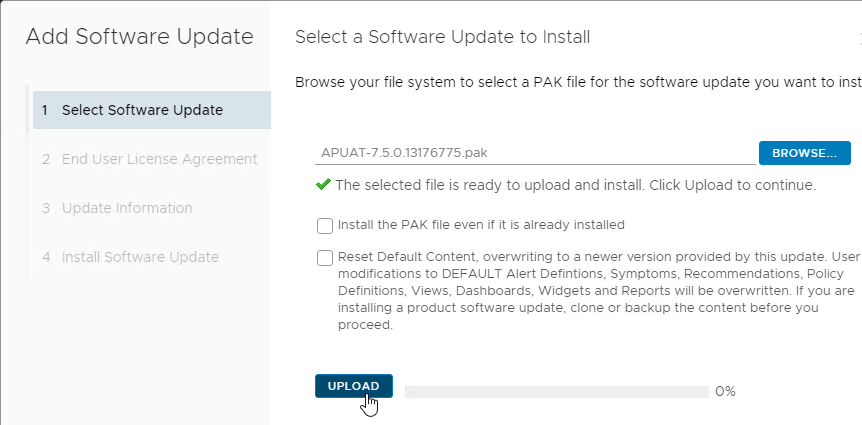
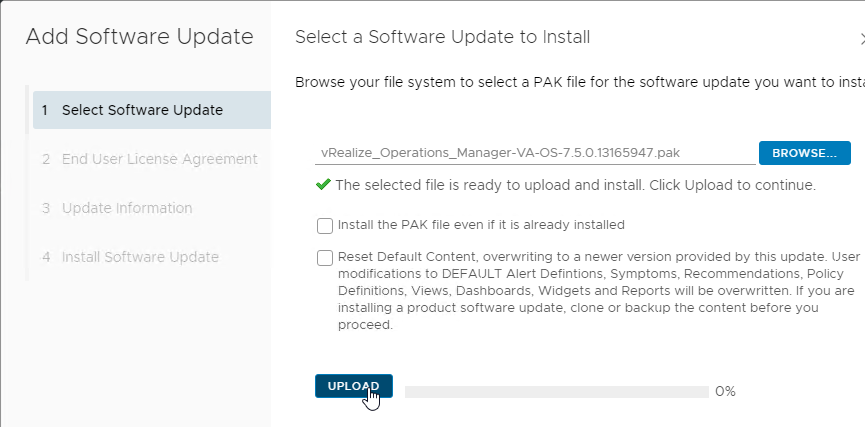
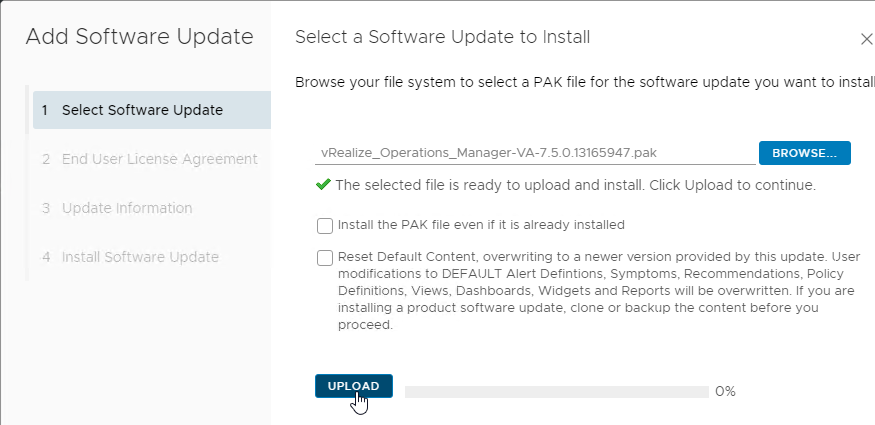
- Upgrading to 7.0:
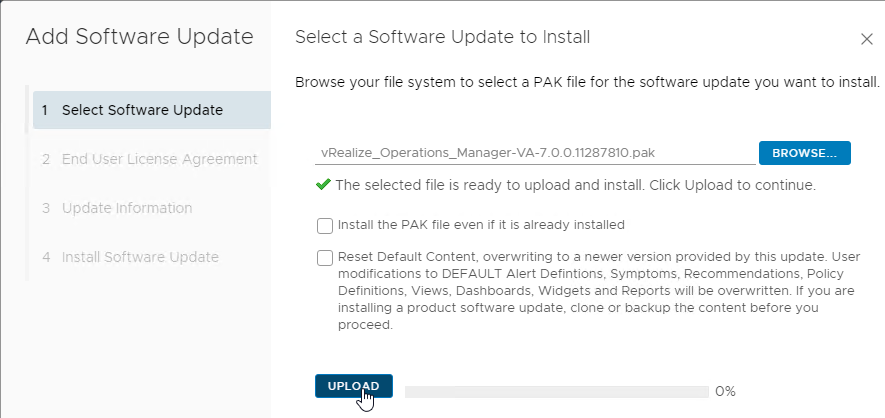
- Click Next.
- Upgrading to 8.0 – separate OS upgrade is no longer needed:
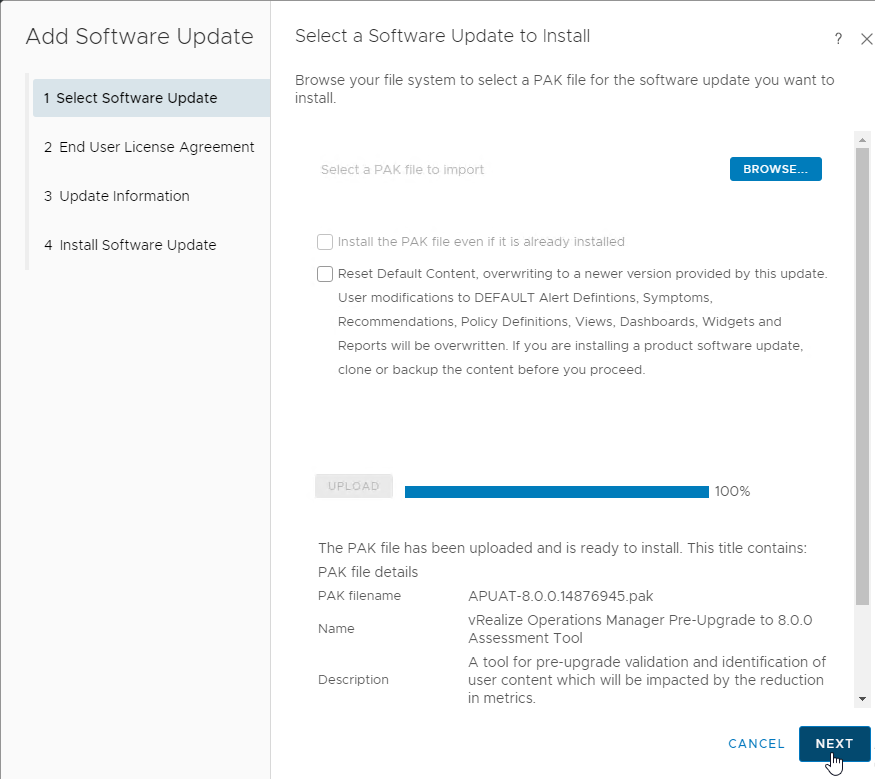
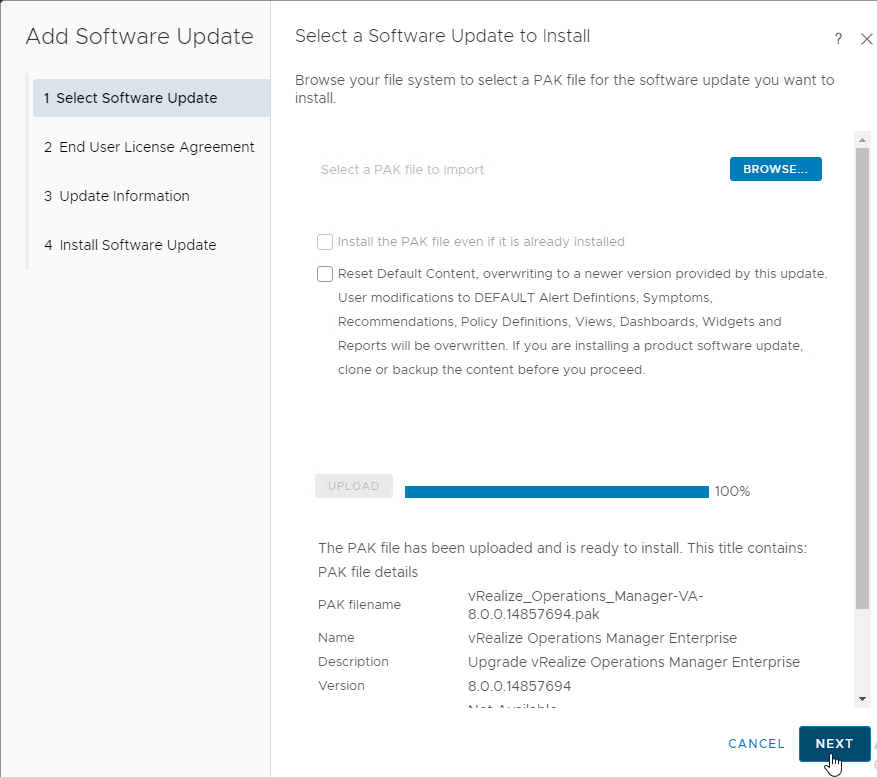
- Upgrading to 7.5:
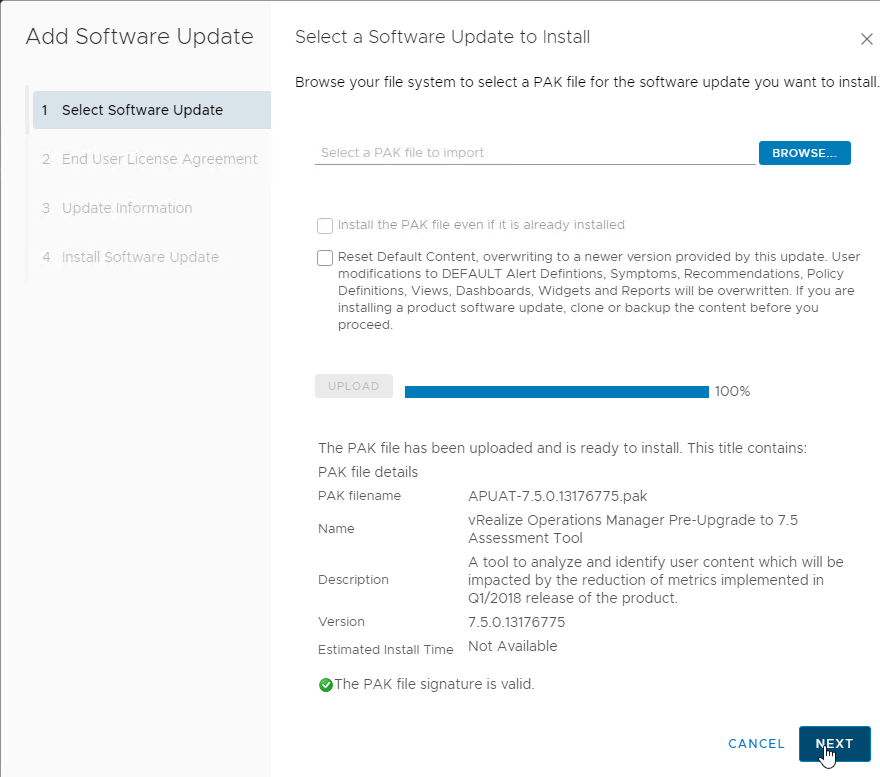
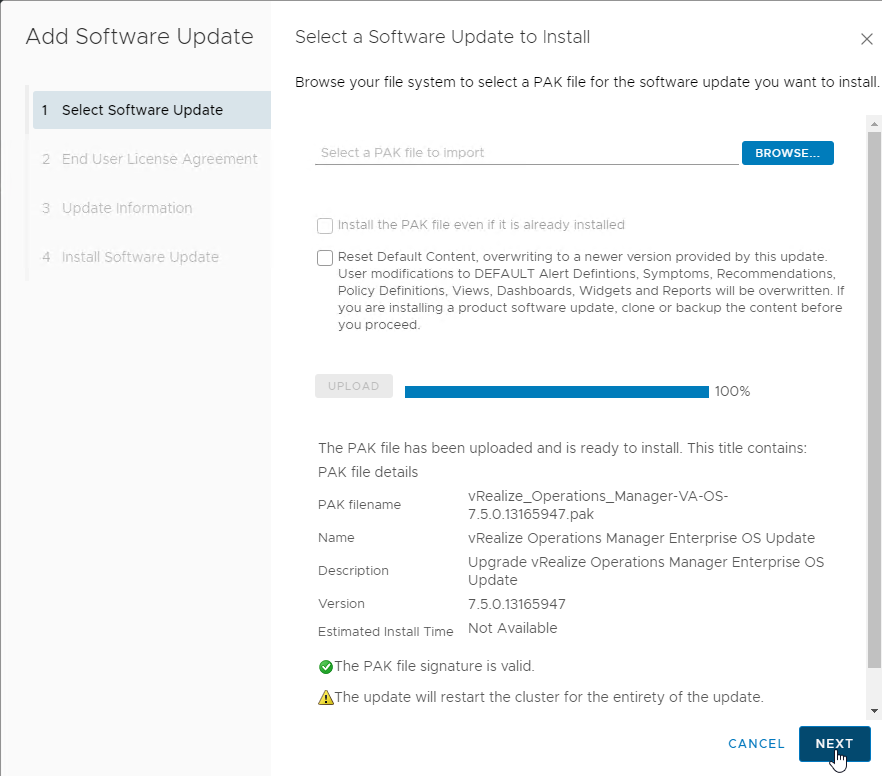
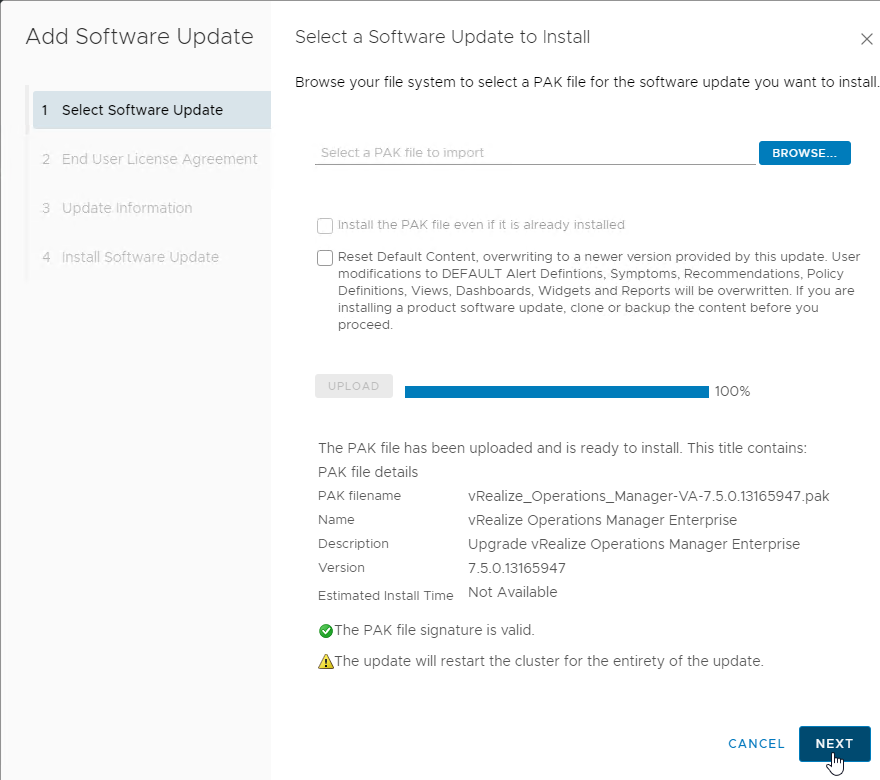
- Upgrading to 7.0:
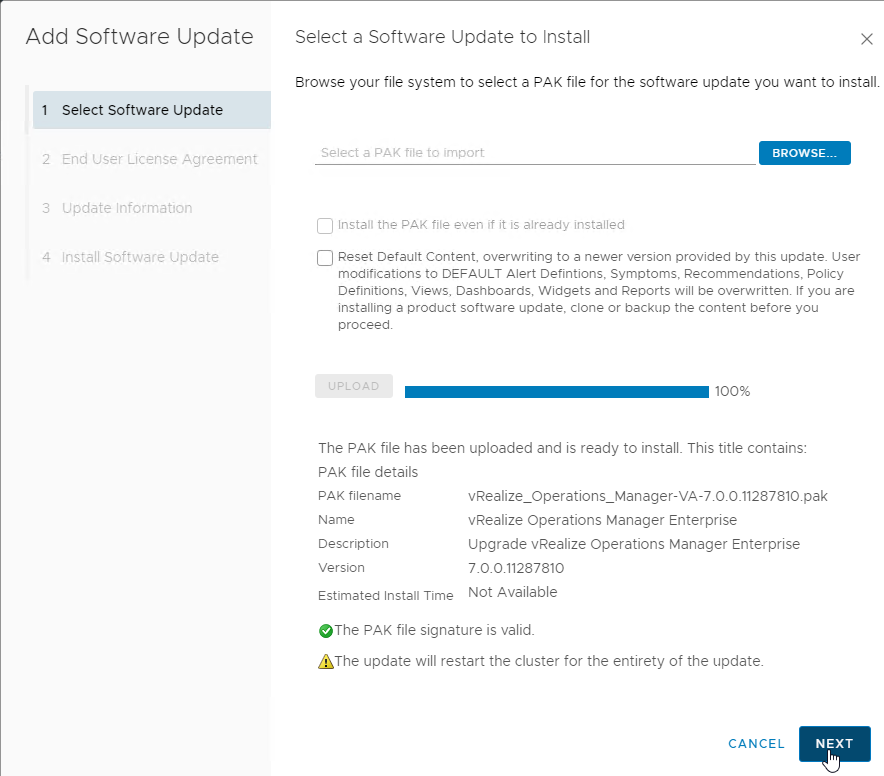
- In the End User License Agreement page, check the box next to I accept the terms, and click Next.
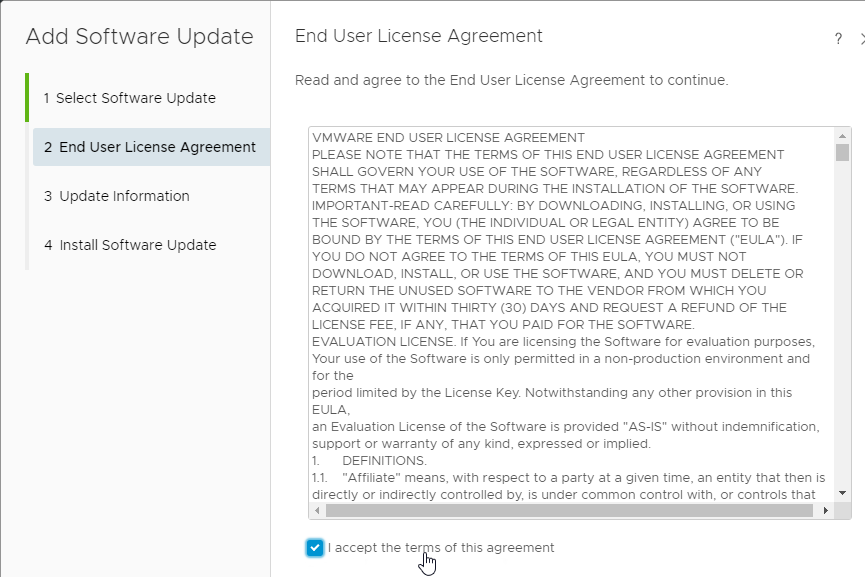
- In the Update Information page, click Next.
- Upgrading to 8.0:
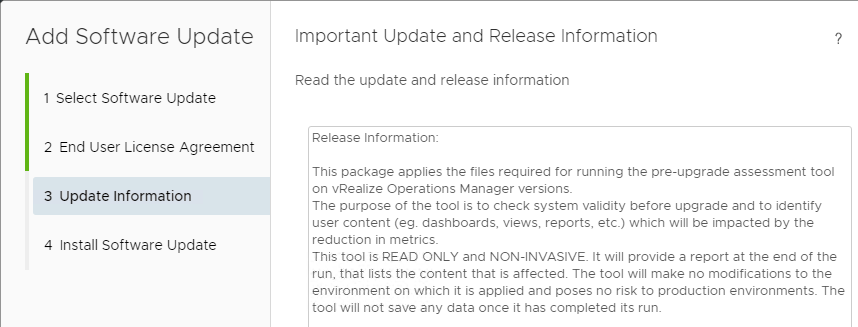
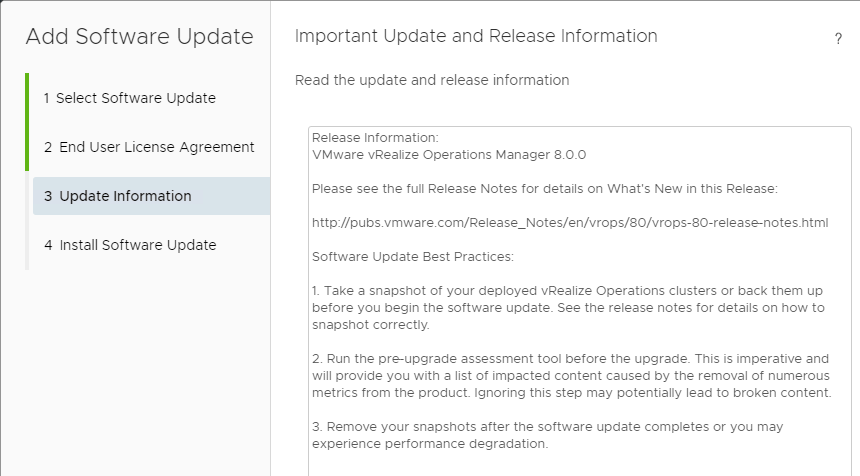
- Upgrading to 7.5:
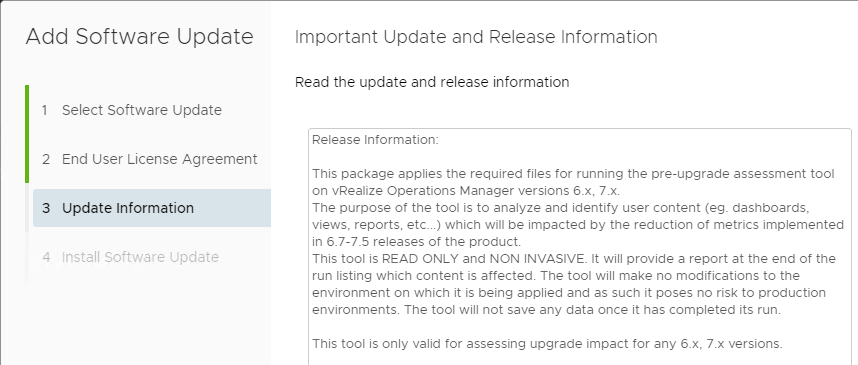
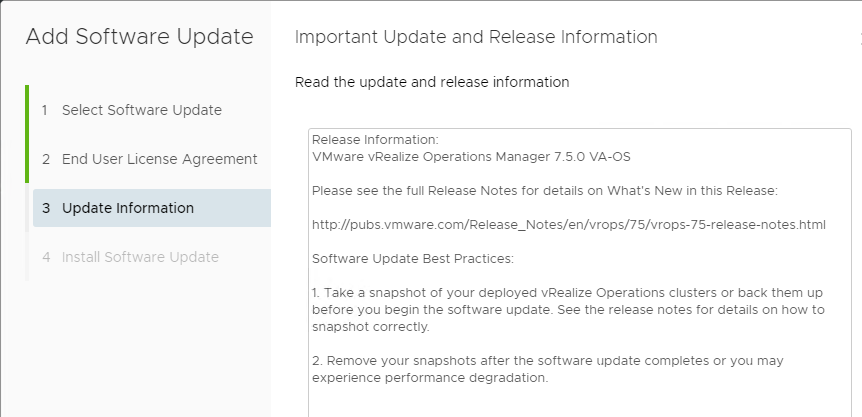
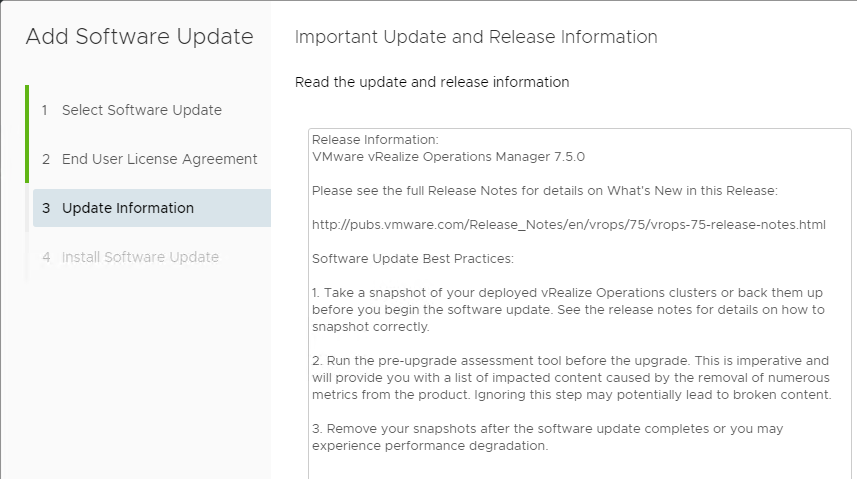
- In the Install Software Update page, click Install.
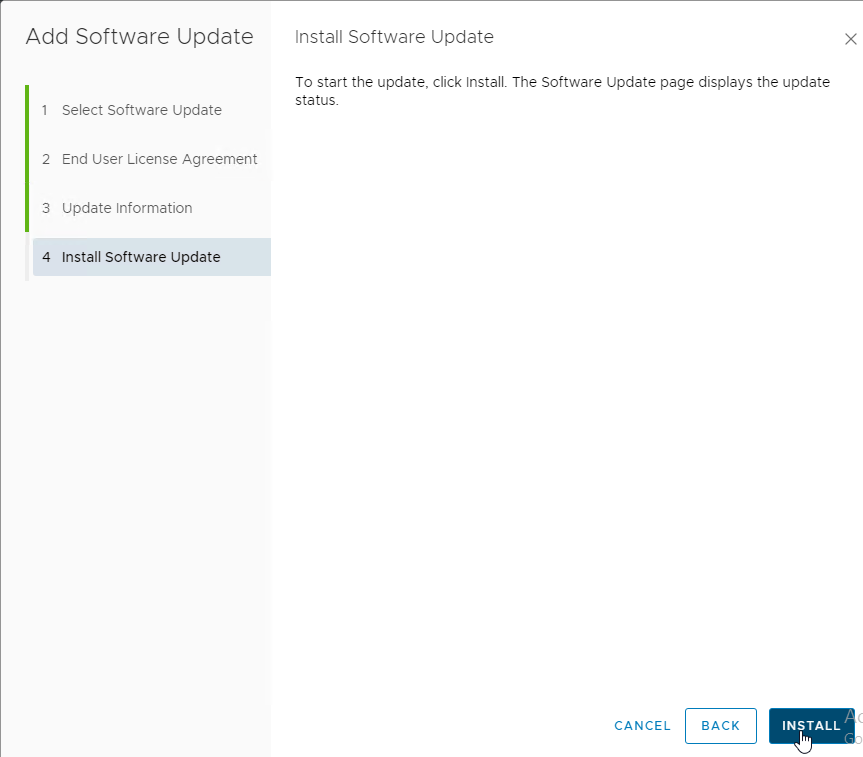
- The installation will take a while.
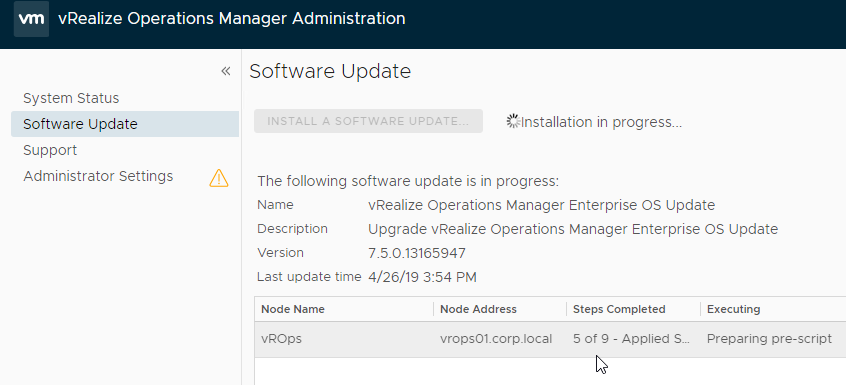
- If you installed the Upgrade Assessment Tool:
- On the left, click Support.
- On the right, switch to the tab named Support Bundles.
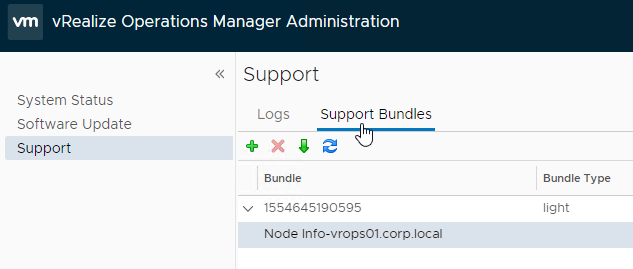
- Click the Download button for the bundle.
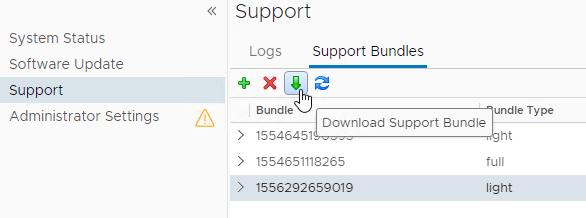
- Extract the downloaded .zip file.
- Go to apuat-data\report and double-click index.html.
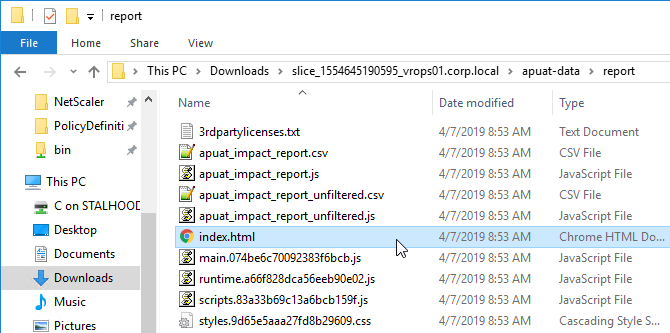
- For more info, see VMware 57283 Using the Upgrade Assessment Tool for vRealize Operations Manager 7.5.
- Some upgrades or patches require a reboot.

- After rebooting and logging in again, the Software Update page shows that the update has been completed.
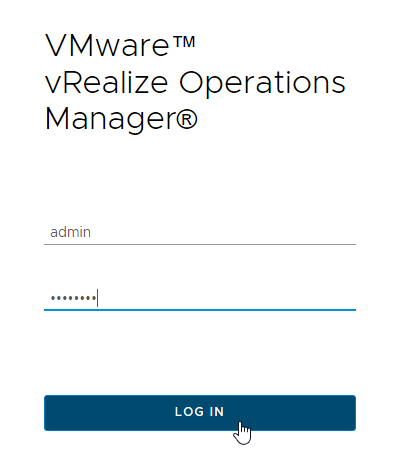
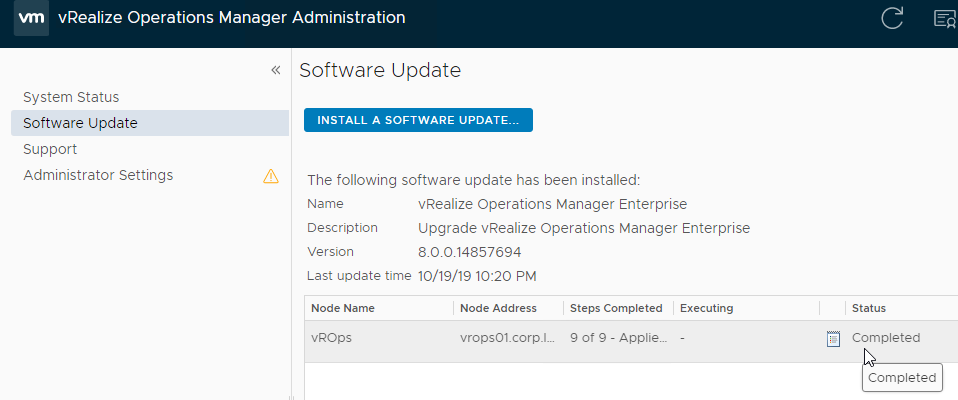
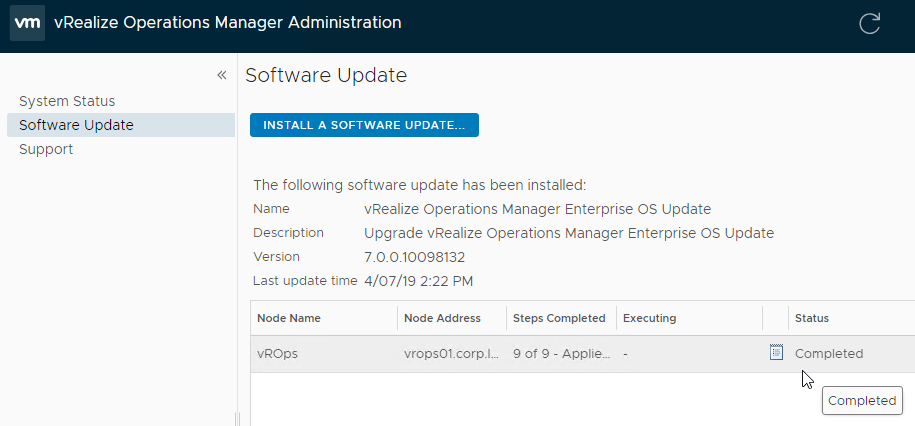
- vROps 7.0 and newer might warn you to set Password Recovery Settings on the Administrator Settings page.
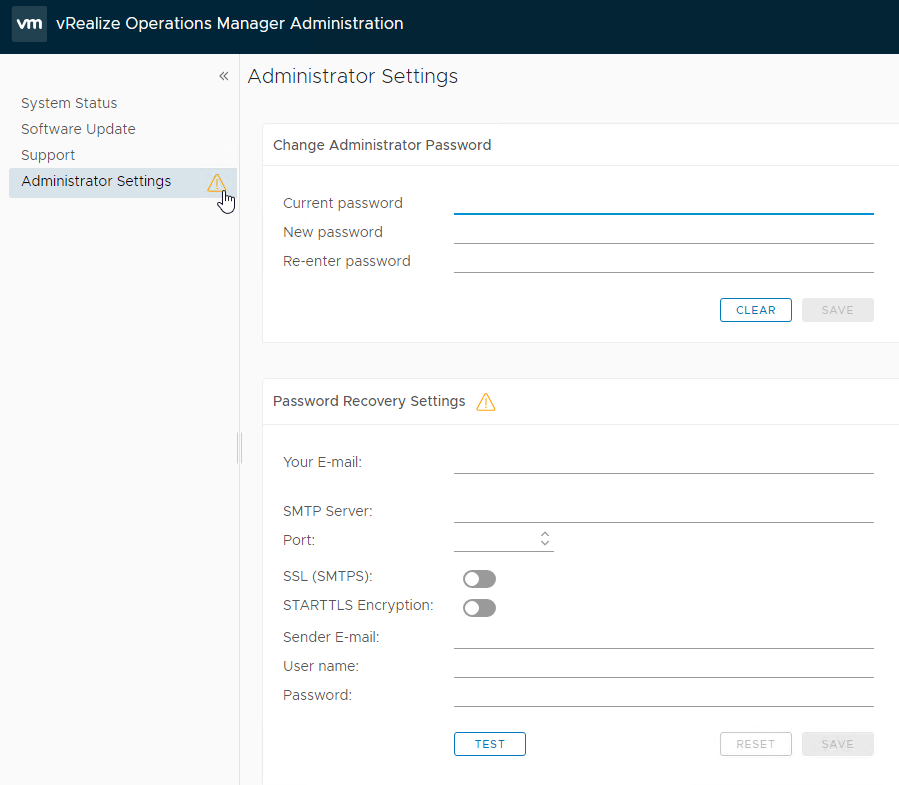
- Click Install a Software Update again to install more .pak files as described earlier in this section.
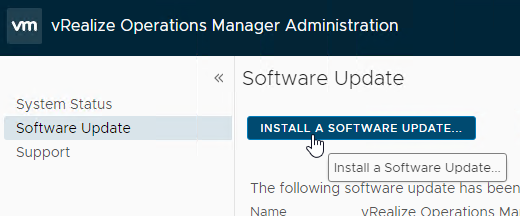
- After upgrading vROps, install the security patch.
Configure vSphere Adapter
vRealize Operations Manager 8.0 and newer
- Login to the appliance at https://vROps_IP/ui. This is the ui path instead of the admin path.
- After logging in, at the top, click Administration.
- On the left, expand Solutions and click Cloud Accounts.
- On the right, click Add Account.

- In the Account Types page, click vCenter.
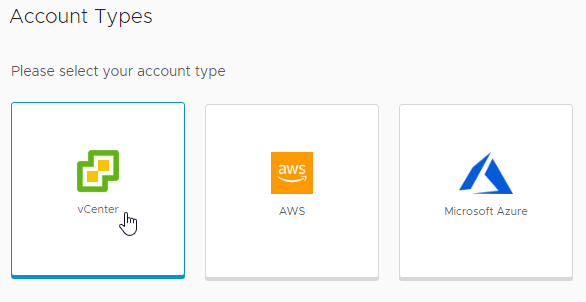
- Give the Cloud Account a name.
- In the Connect Information section, enter the address of the vCenter Server.
- Next to the Credential field, click the plus icon.
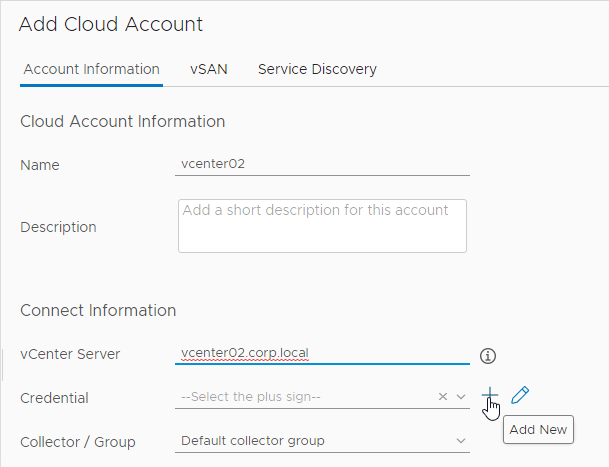
- Enter vCenter credentials and click OK.
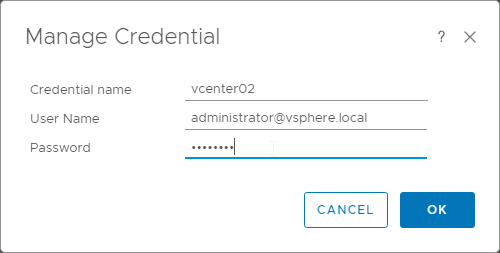
- Click Test Connection.
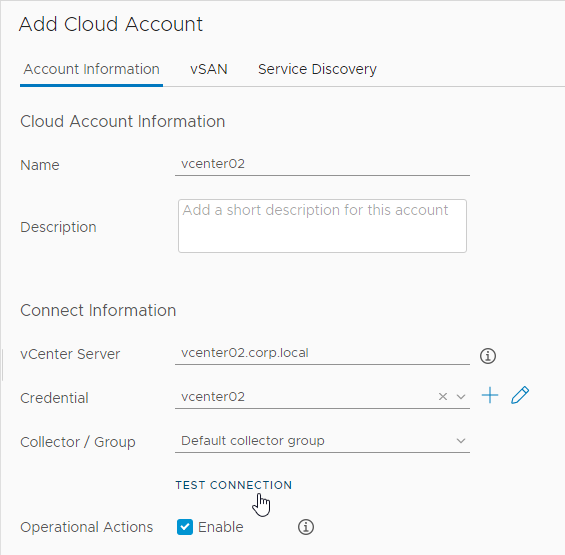
- Click Accept to accept the certificate.
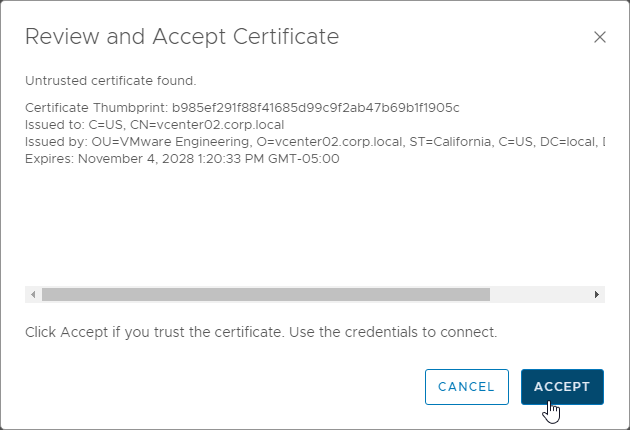
- Click OK when prompted that Test connection successful.
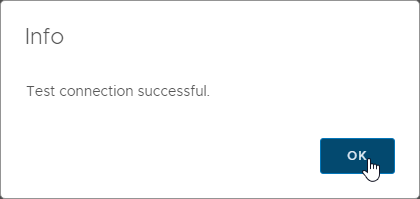
- Next to the Action Credentials field, click the plus icon.
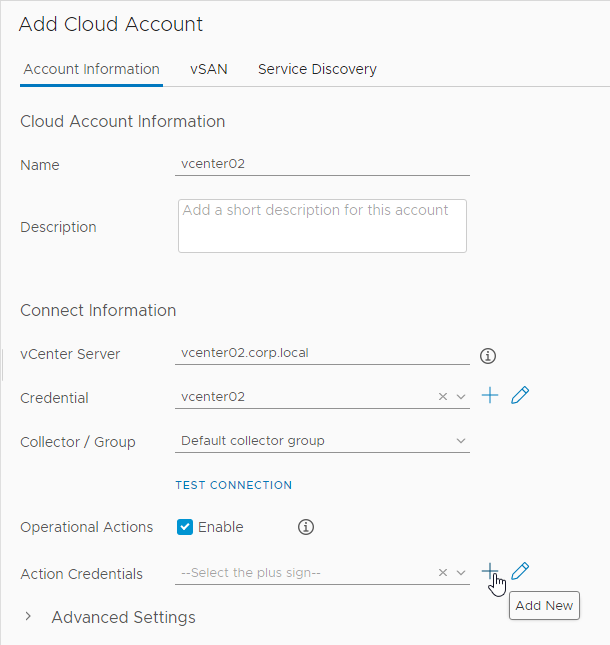
- Enter vCenter credentials, and then click OK.
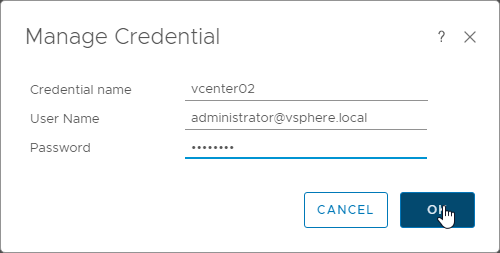
- You can optionally click Define Monitoring Goals.
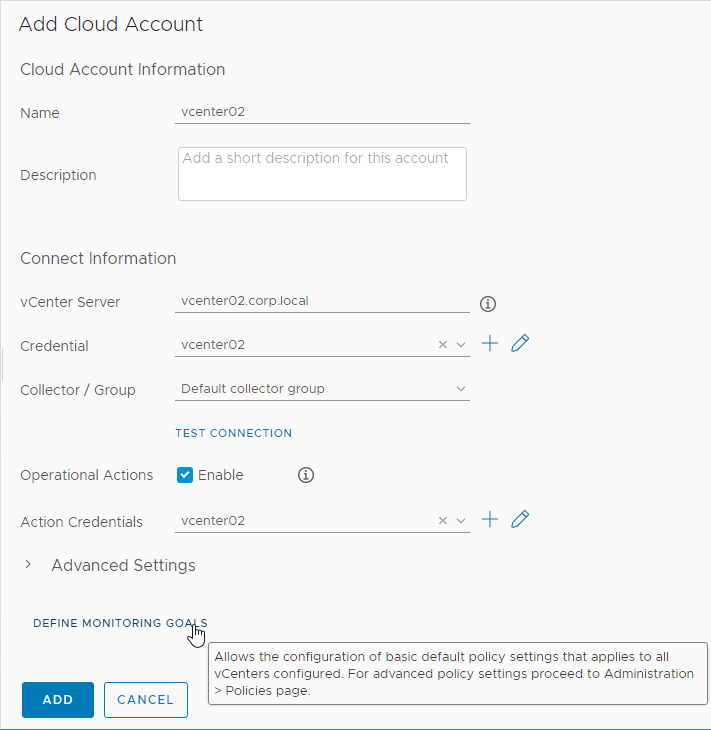
- At the top of the page is a tab named vSAN where you can provide alternate vSAN credentials.
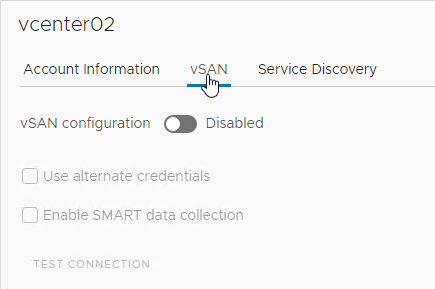
- The tab named Service Discovery requires the latest version of VMware Tools (e.g. 11.0.1).
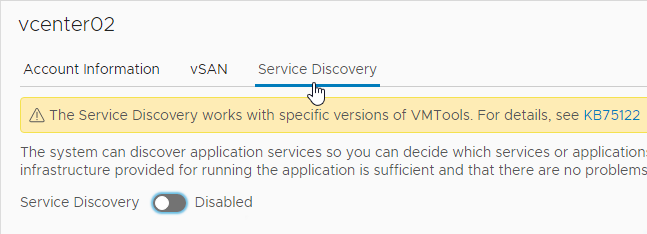
- Click Add when done.

vRealize Operations Manager 7.5 and older
- Login to the appliance at https://vROps_IP/ui. This is the ui path instead of the admin path.
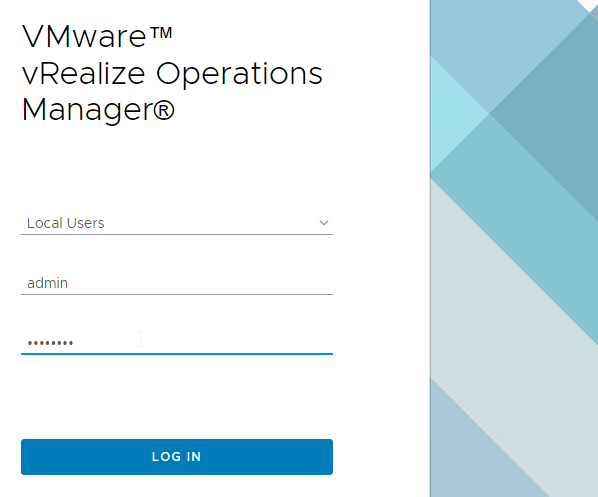
- Go to Administration > Solutions.

- Highlight the VMware vSphere Solution.

- On the bottom half of the window, highlight the vCenter Adapter, and then click the Configure icon on the toolbar.
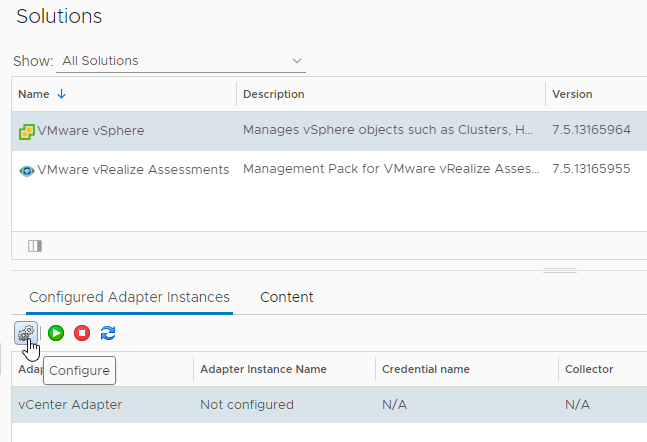
- In the Display Name field, enter a name for the vCenter adapter.
- In the vCenter Server field, enter the address of the vCenter server.
- Click the green plus icon to add a Credential.
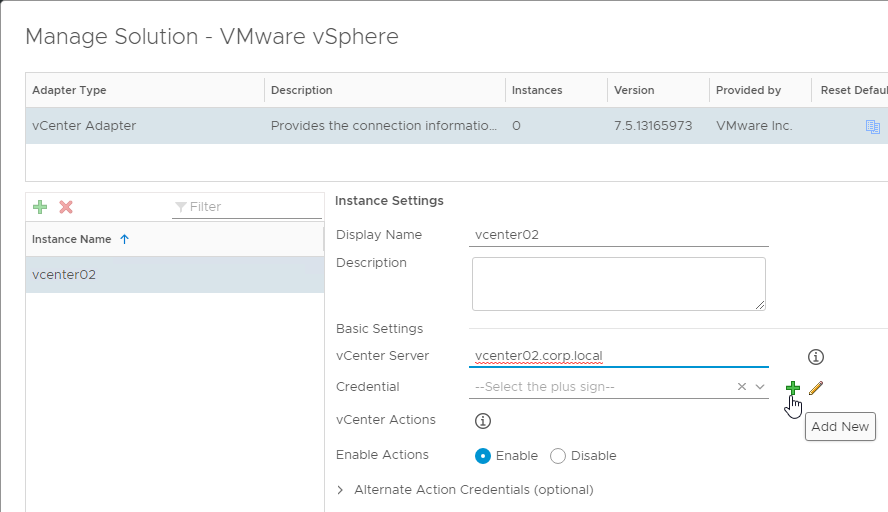
- In the Manage Credential window:
- Give the credential a name.
- Enter credentials for the vCenter server.
- Click OK.
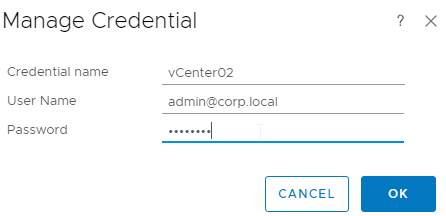
- Back in the Manage Solution window, click the Test Connection link.
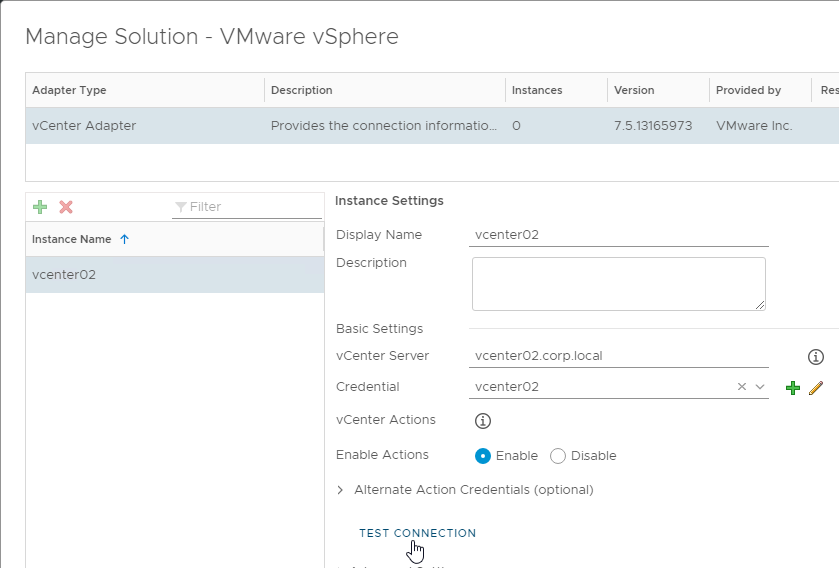
- In the Review and Accept Certificate window, click Accept to accept the certificate.
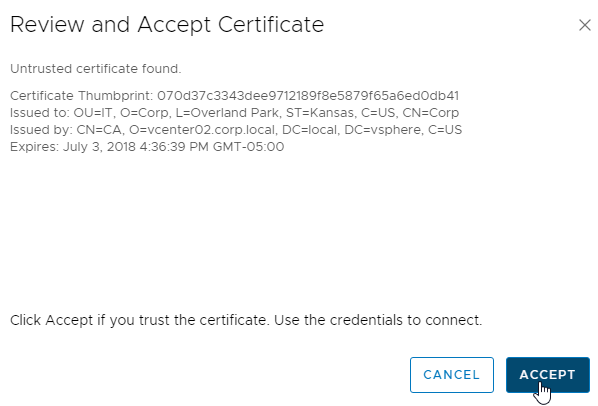
- In the Info window, click OK to acknowledge that the test was successful.
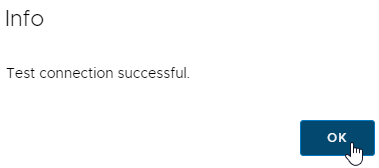
- Back in the Manage Solution window, on the bottom right, click Save Settings.
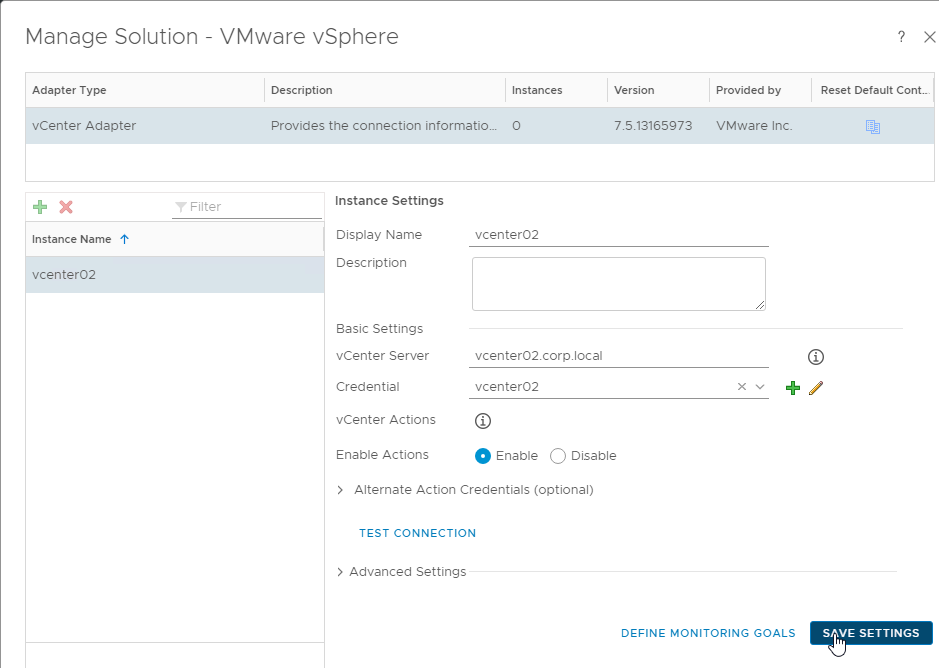
- In the Info window, click OK to acknowledge that the adapter instance was successfully saved.
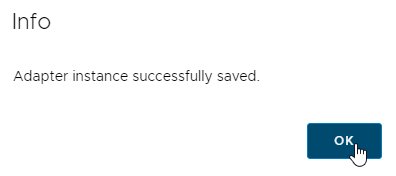
- Click Close to close the Manage Solution window.

- Note: it takes four weeks for vRealize Operations Manager to determine dynamic thresholds.
Active Directory Authentication
- In the vRealize Operations Manager console, in the top of the page, click Administration.
- On the left, expand Access, and click Authentication Sources.
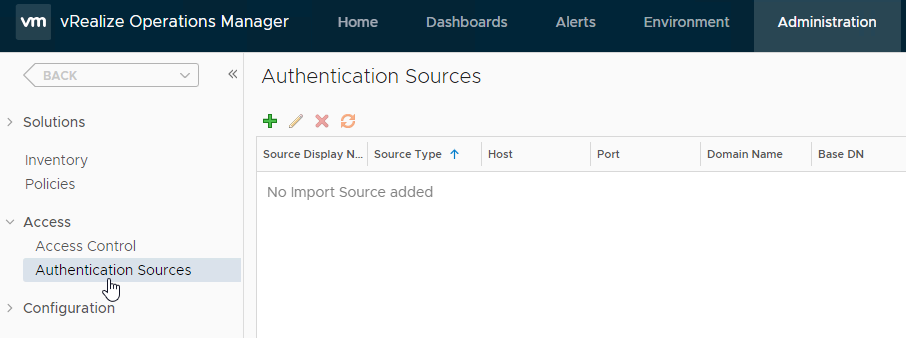
- On the right, click the green plus icon.
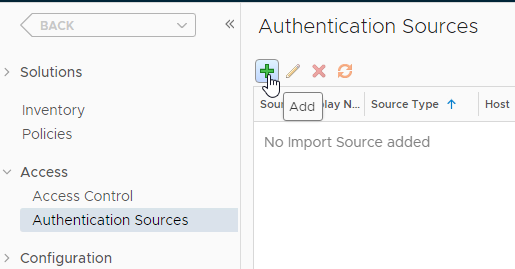
- In the Source Display Name field, enter a display name. This name will appear on the logon page as shown below.
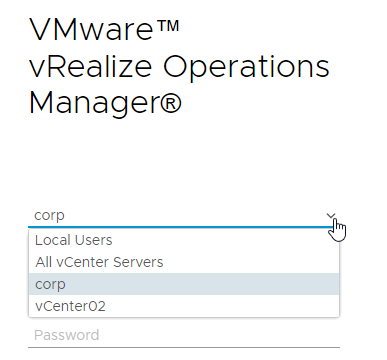
- From the Source Type drop-down, select Active Directory.

- In the Domain/Subdomain field, enter the DNS name of your Active Directory domain.
- Enter credentials of a LDAP bind service account.
- Check the box next to Use SSL/TLS.
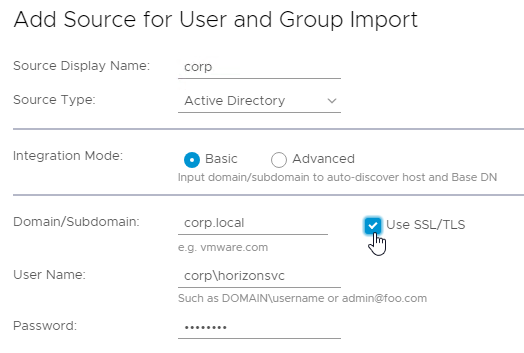
- On the bottom of the window, click Test.
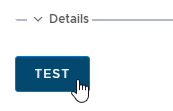
- In the Review and Accept Certificate window, check the box next to Accept this certificate, and click OK.

- In the Info window, click OK to acknowledge that the test was successful.
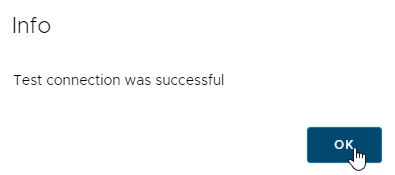
- Click OK to close the Add Source for User and Group Import window.

- On the left, click Access > Access Control.
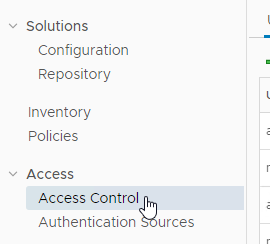
- On the right, switch to the User Groups tab.

- In the toolbar, click the Import Group icon.
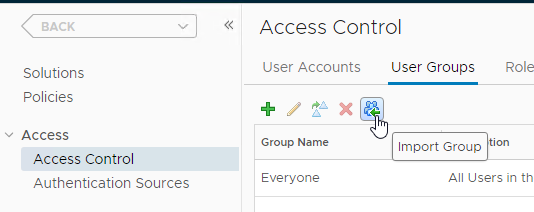
- In the Import User Groups page, ensure your Active Directory source is selected, enter your Horizon Administrators group name, click Search, and then select the group. Click Next.
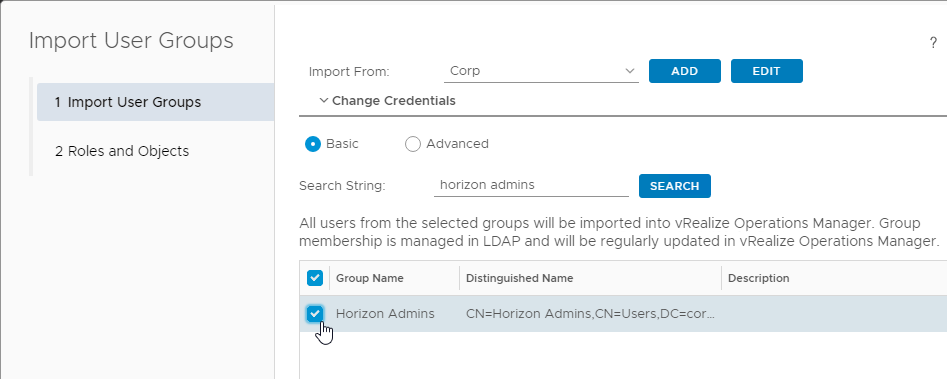
- On the Roles and Objects page, from the Select Role drop-down, select Administrator.
- Check the box next to Assign this role to the group.
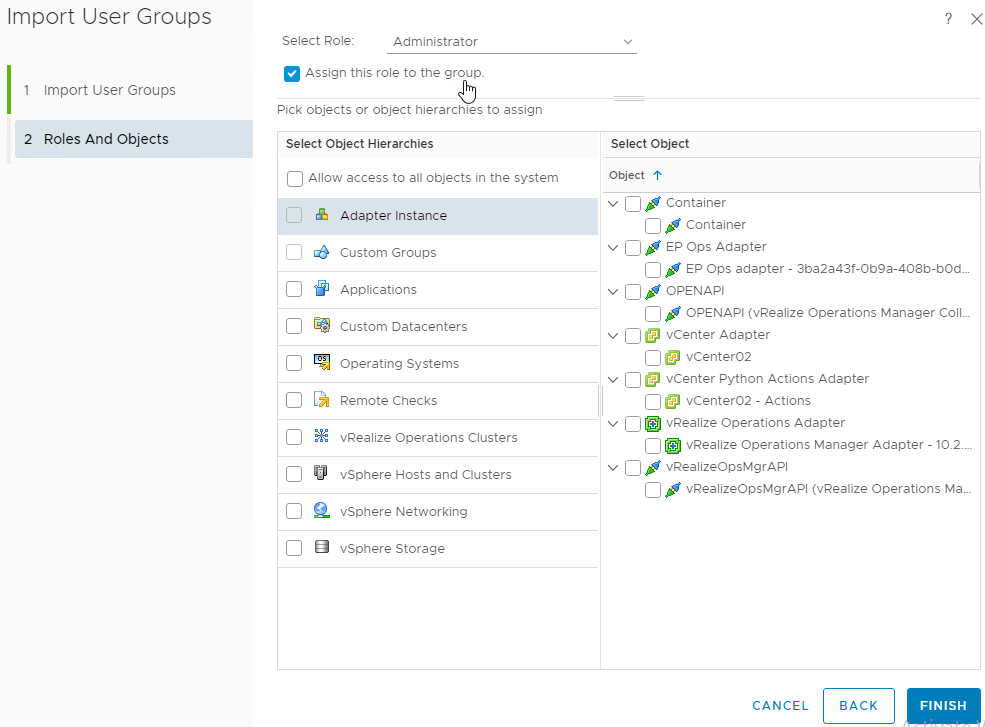
- Check the box next to Allow access to all objects in the system. Click Finish.
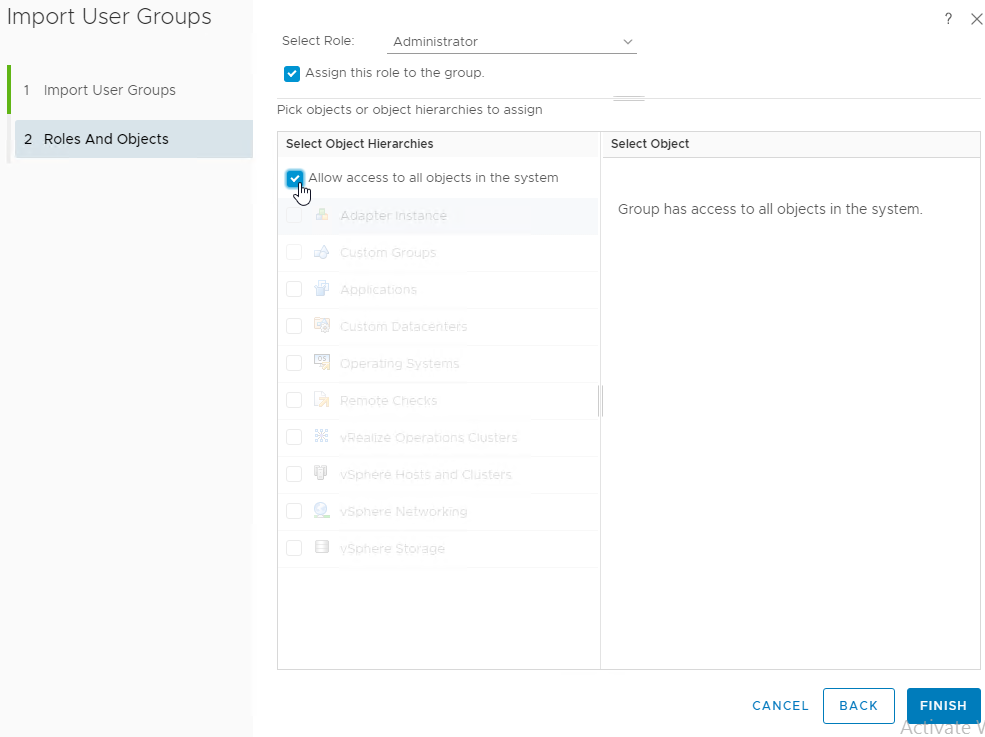
- Click Yes when warned about access to all Objects in the system.
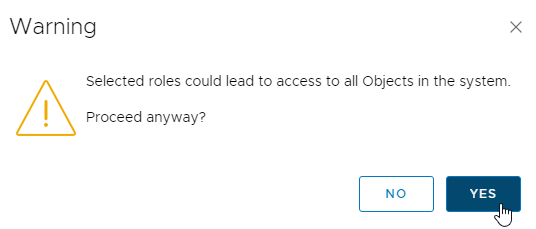
- On the top right, click the person icon, and click Log Out.
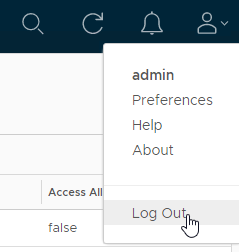
- Change the drop-down to the Active Directory source, and login as an Active Directory account.

Session Timeout
- The vRealize Operations web page defaults to 30 minutes timeout. To change it, go to Administration > Management > Global Settings.
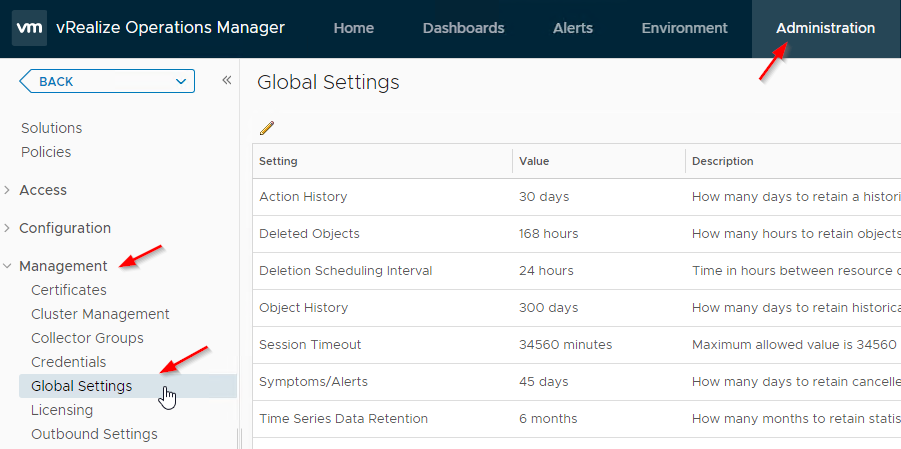
- In the row labelled Session Timeout, click the pencil icon.
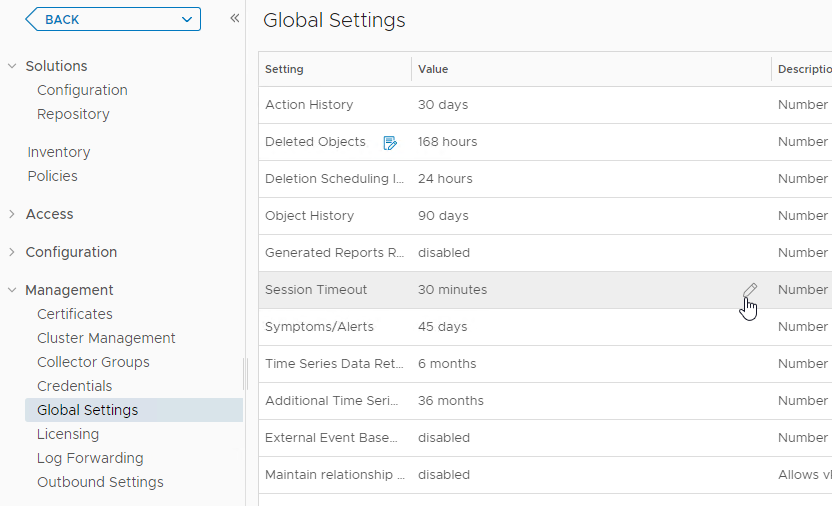
- The maximum value for Session Timeout is 34560. Click Save.
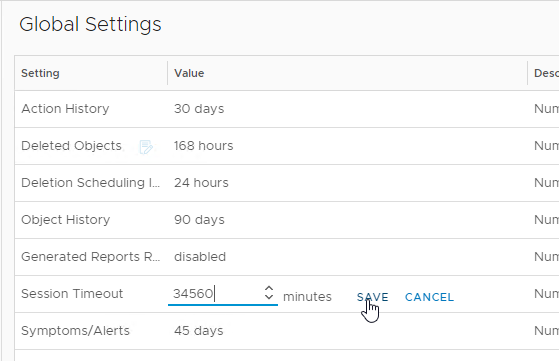
Alerting
- In vRealize Operations console, go to Administration > Outbound Settings.
- On the right, click the green plus icon.
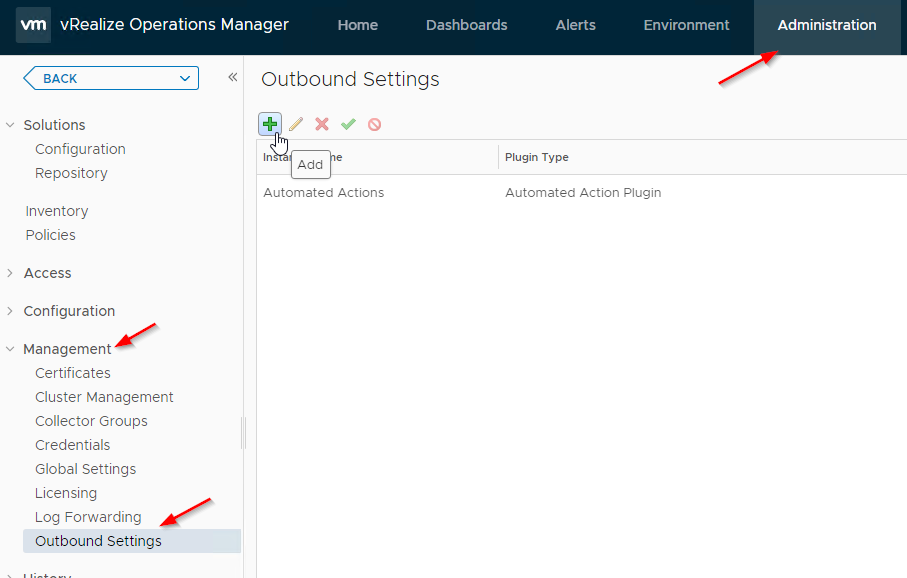
- From the Plugin Type drop-down, select Standard Email Plugin.

- Give the Instance a name.
- Enter the SMTP information
- On the bottom, click Test.
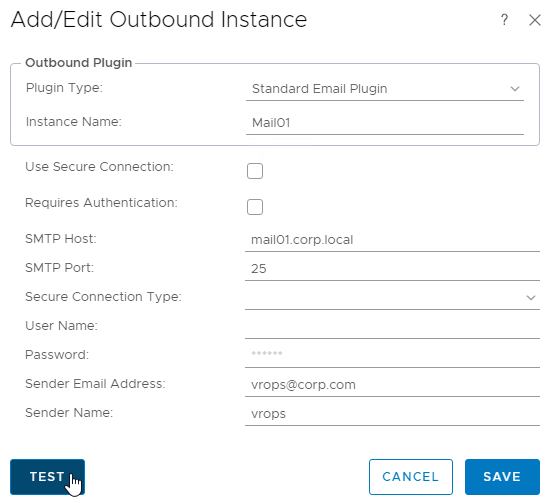
- In the Test Connection window, click OK to acknowledge that the test was successful.
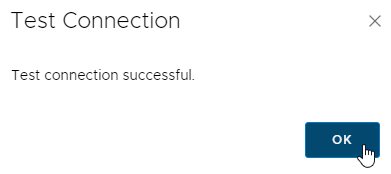
- Then click Save to close the Add/Edit Outbound Instance window.

- You can then go to Alerts > Alert Settings > Notification Settings, and create notifications.
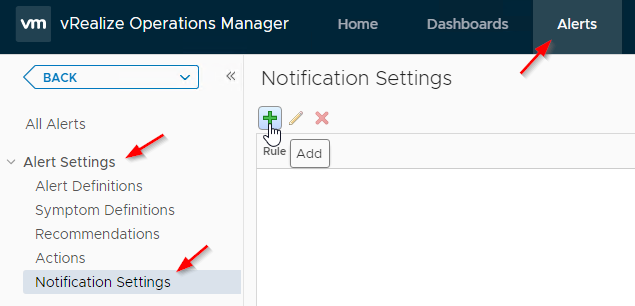
- Give the notification rule a name.
- For Method, select the Standard Email Plugin, and the outbound instance you created earlier.

- Enter Recipients.
- Select Triggers and Criticality. Click Save.
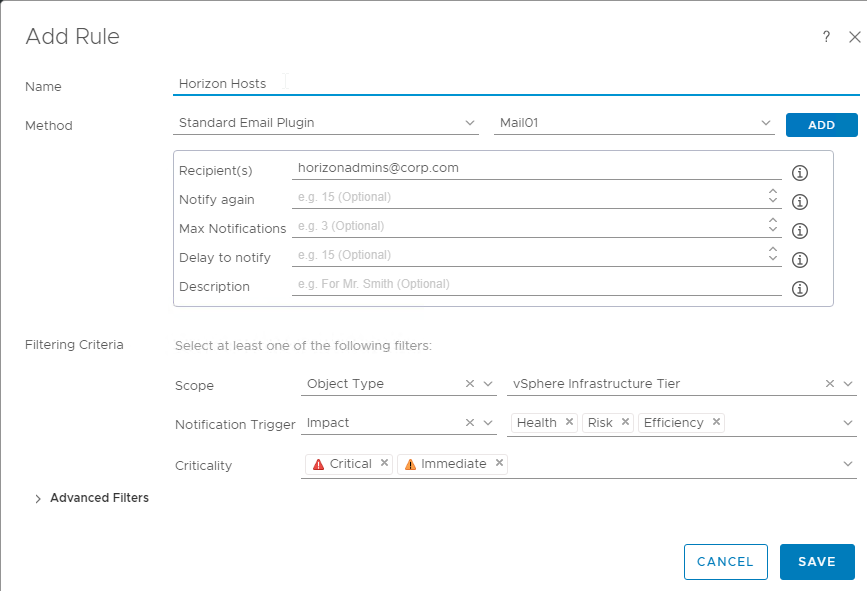
Install Horizon Adapter PAK File on vROps
Download the vROps for Horizon components for both new installs and upgrades:
- From the vRealize Operations for Horizon 6.7.1 download page, or from the vRealize Operations for Horizon 6.6.0 download page, download the vRealize Operations for Horizon Adapter.
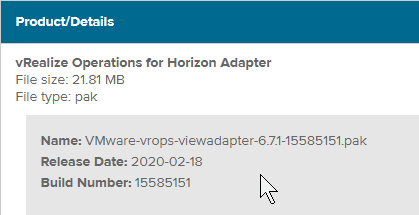
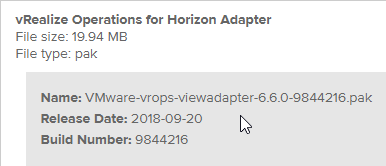
- On the same page, also download the vRealize Operations for Horizon Broker Agent 64-Bit.
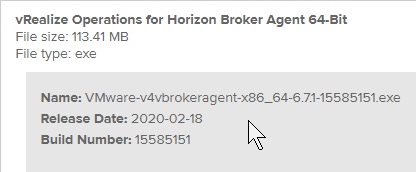
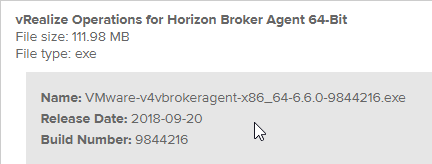
To install or upgrade the Horizon Adapter:
- Login to the vRealize Operations appliance web page (/ui path).
- Go to Administration > Solutions > Repository.

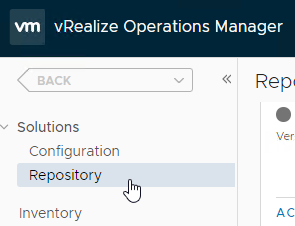
- On the right, scroll down, and then click Add/Upgrade or click Add a Management Pack.
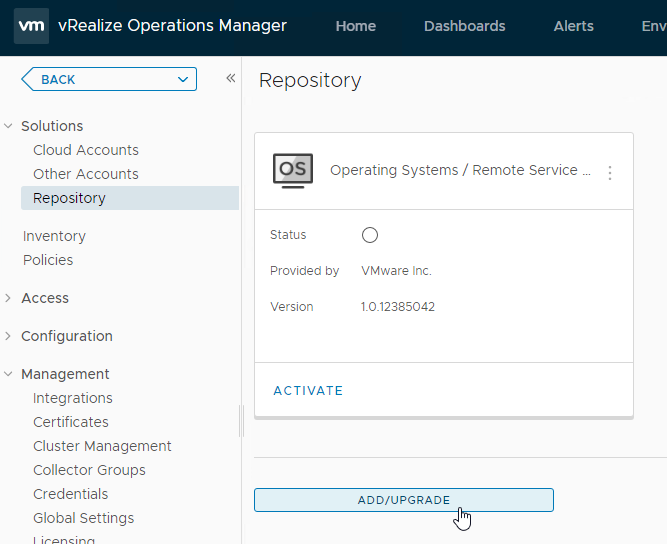
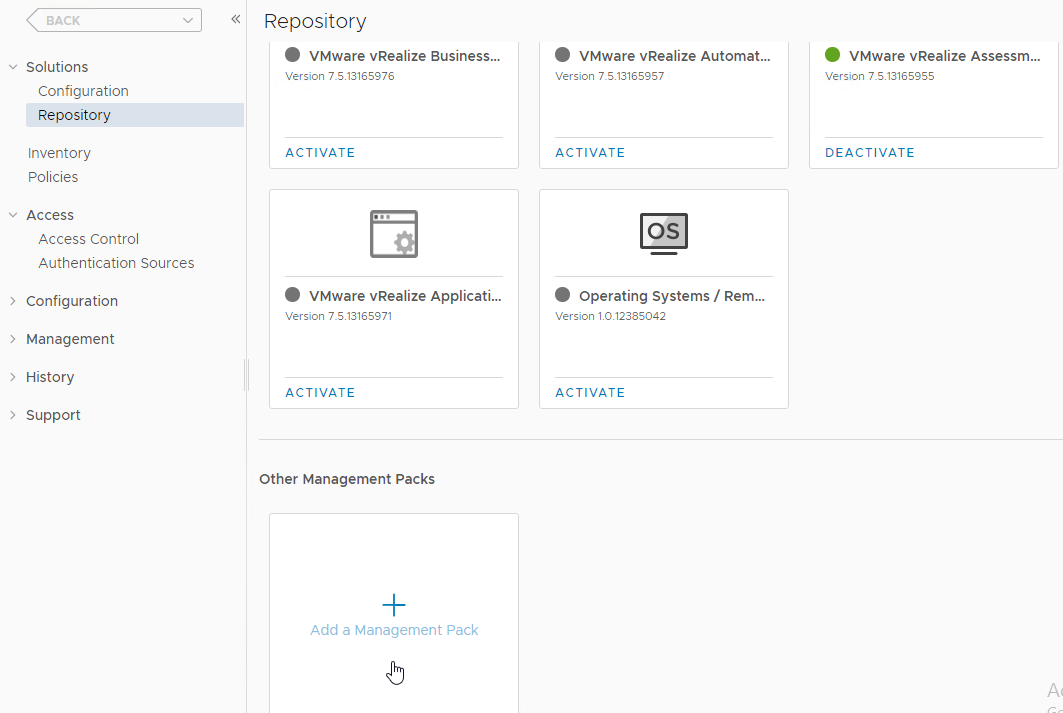
- In the Select Solution page, click Browse.

- Browse to the Horizon Adapter .pak file and select it.
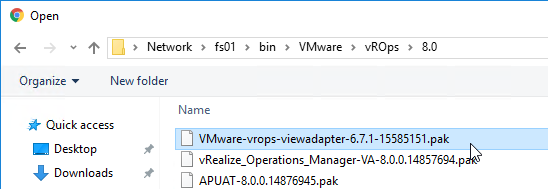
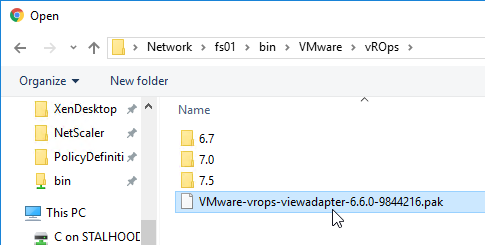
- Back in the Add Solution wizard, click Upload.
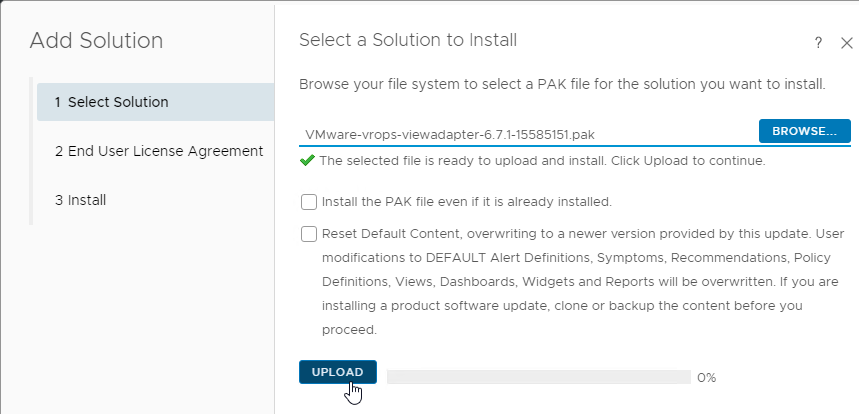
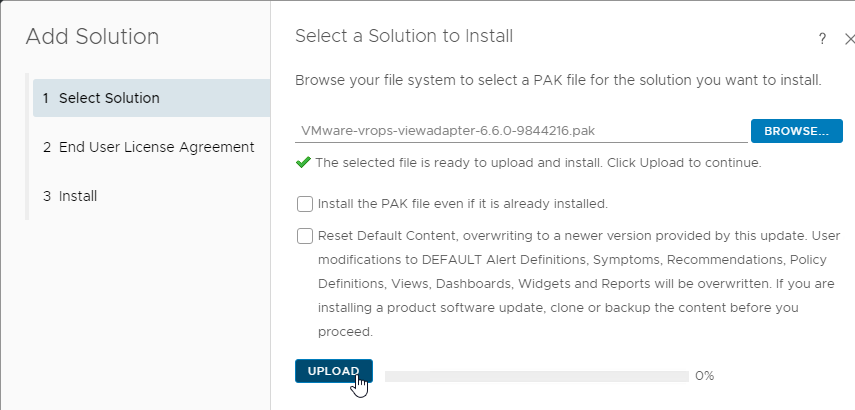
- After upload is complete, click Next.
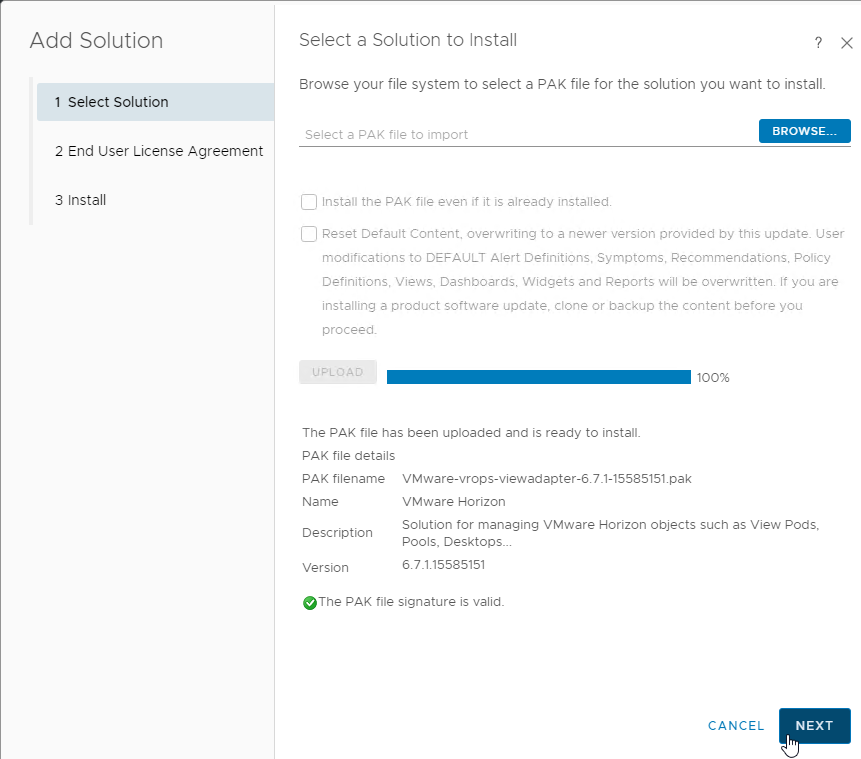
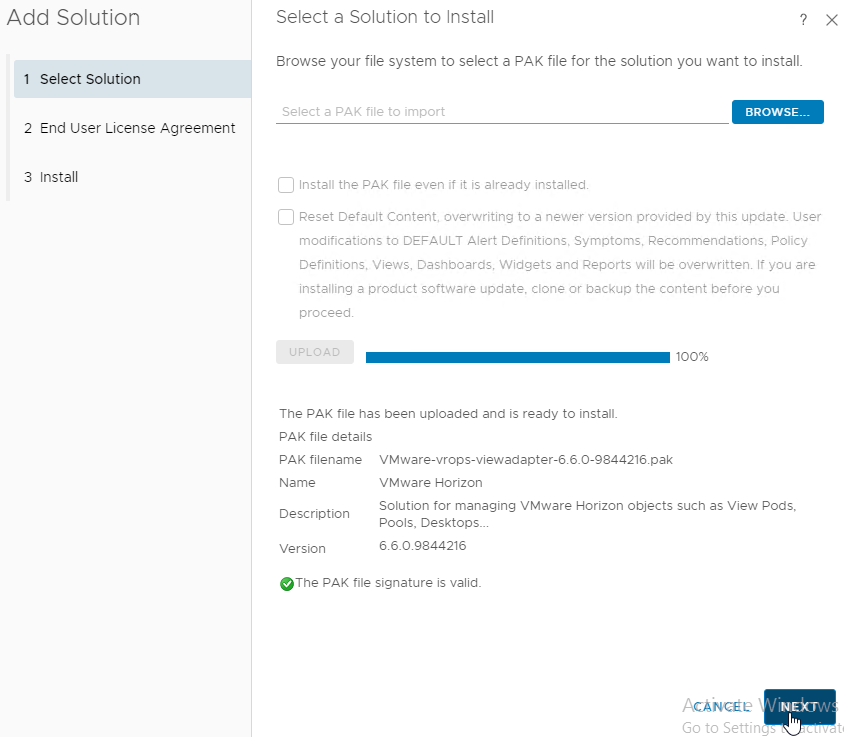
- In the End User License Agreement page, check the box next to I accept the terms, and click Next.
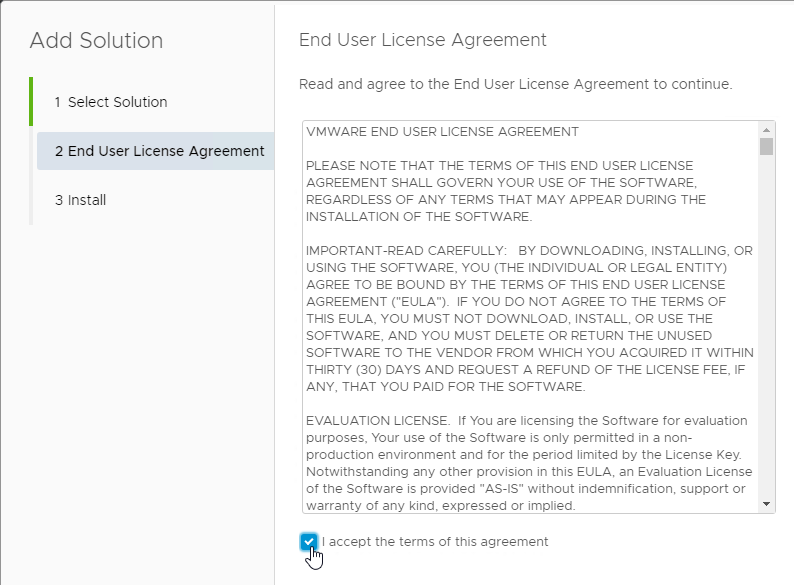
- The Install page appears and installation begins automatically.
- After it’s done installing, in the Install page, click Finish.
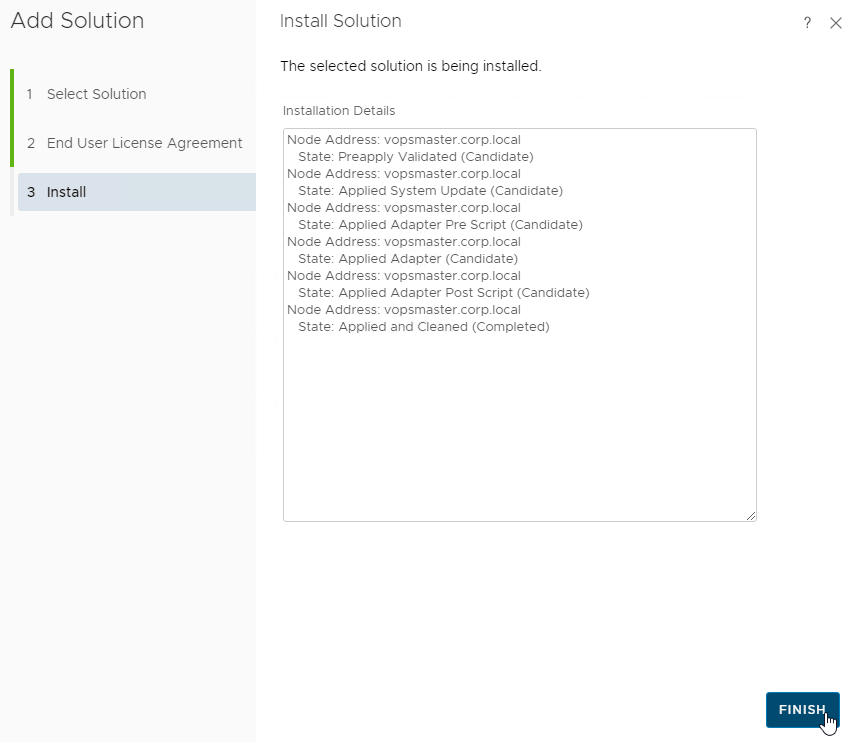
- If you have NVIDIA GPUs, also install the NVIDIA Virtual GPU Management Pack for vRealize Operations.
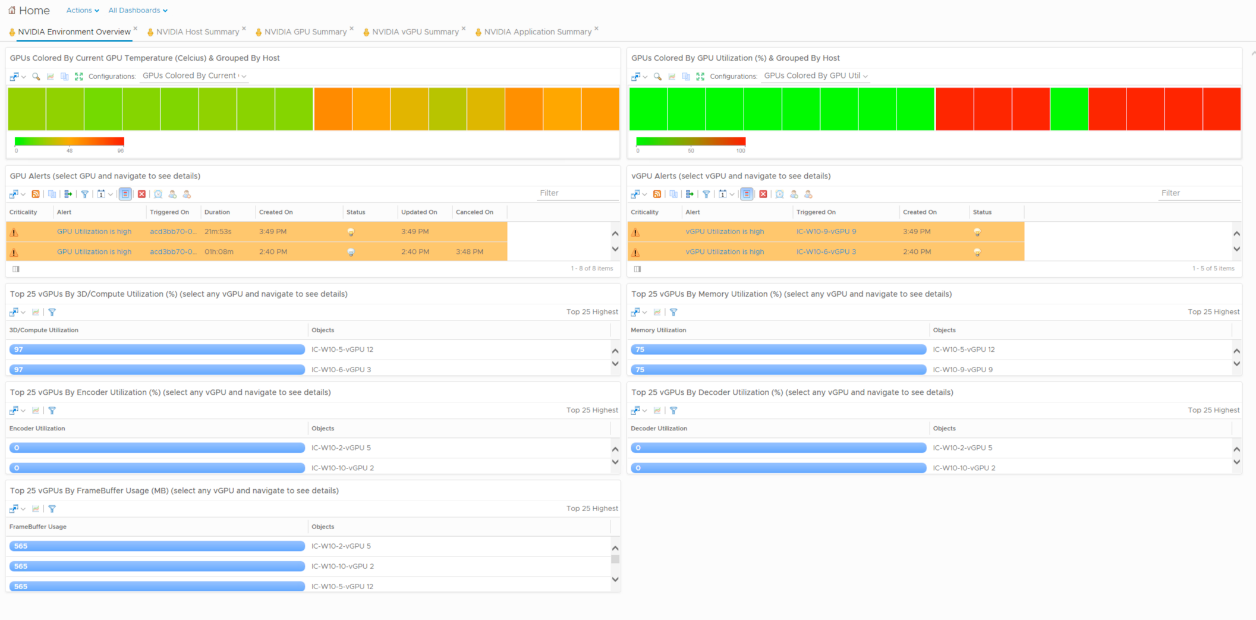
Horizon Adapter Licensing
- In the vRealize Operations web page, go to Administration > Management > Licensing.
- On the right, click the green plus icon.
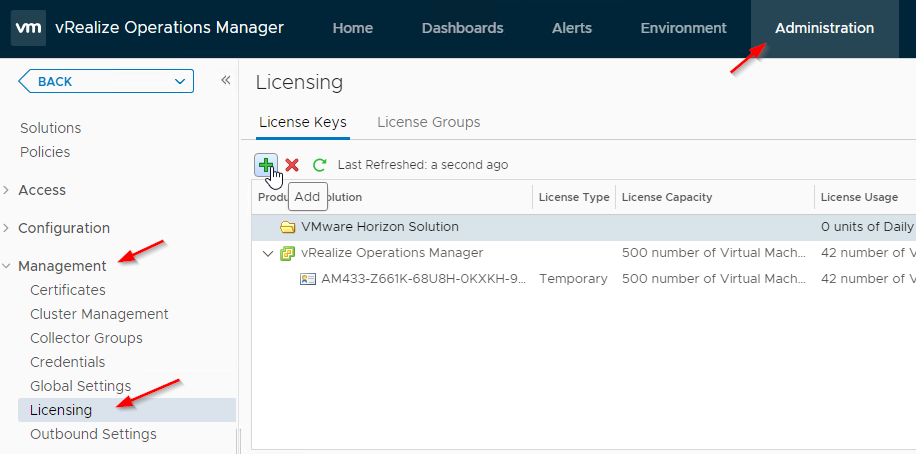
- In the Select product or solution drop-down, select VMware Horizon.
- Enter the vROps for Horizon license key, and click Validate. Note: you enter the Adapter key (or Horizon 7 Enterprise key), not the vRealize Operations Manager key.
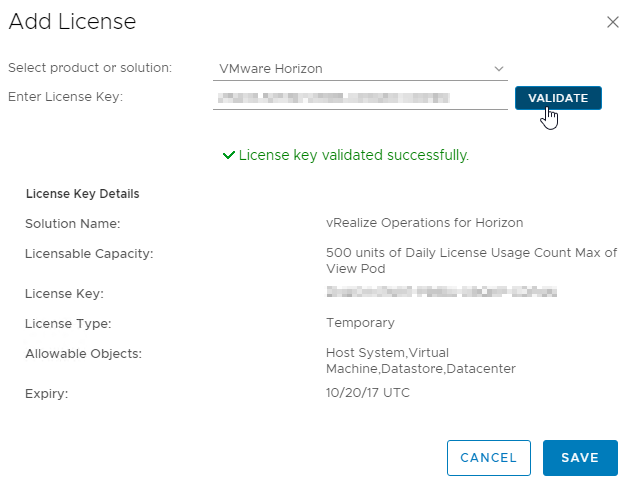
- Click Save to close the Add License window.
- You might have to add objects to the License Groups as detailed at Associate Horizon Objects with Your vRealize Operations for Horizon License Key at VMware Docs.
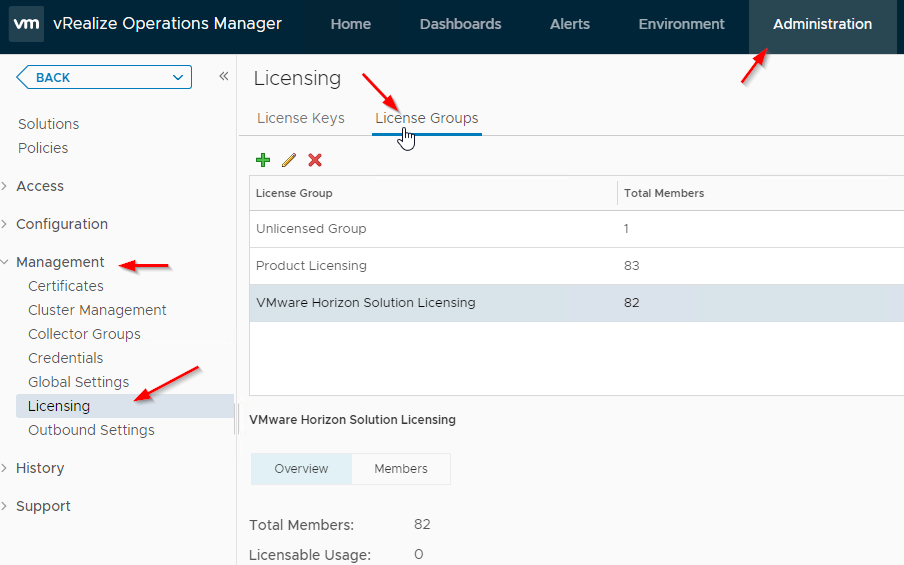
Here are some guidelines regarding the Horizon Adapter:
- You can only have one Horizon adapter per vRealize Operations appliance.
- Each adapter can handle up to 10,000 virtual desktops.
- Multiple Horizon pods can point to a single Adapter.
vRealize Operations Manager 8.0 and newer
Do the following to create and configure a Horizon Adapter:
- At the top of the page, click the tab named Administration.
- On the left, expand Solutions, and click Other Accounts.
- On the right, click the button labelled Add Account.

- In the Account Types page, click the button named Horizon Adapter.
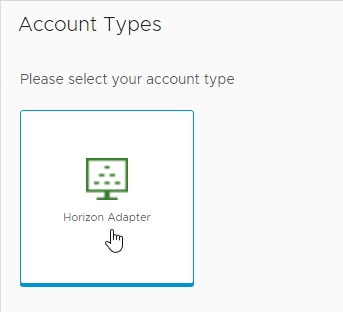
- Give the Account a Name.
- Give the Adapter ID a name.
- Next to the Credential field, click the plus icon.
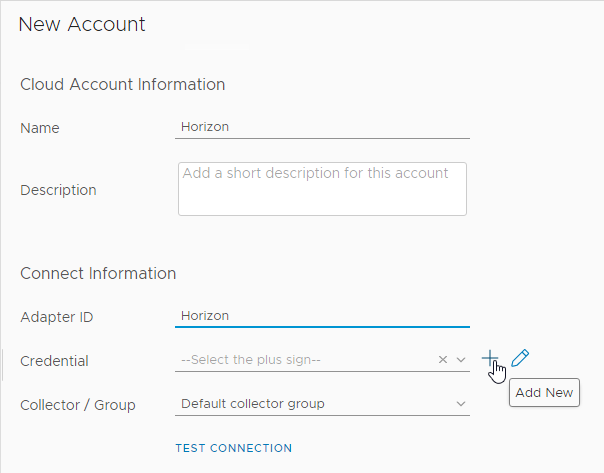
- Enter a Credential name.
- Enter a new secret key. You’ll enter this key later when installing the Broker Agent.
- Click OK.
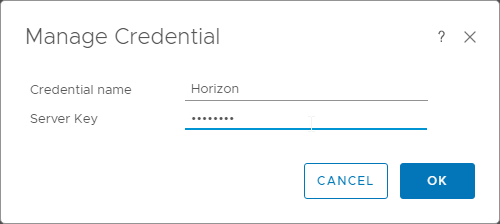
- Click Test Connection.
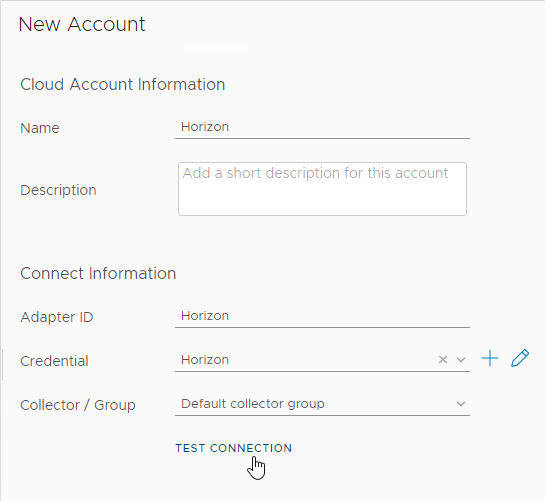
- Click OK when prompted that test connection successful.
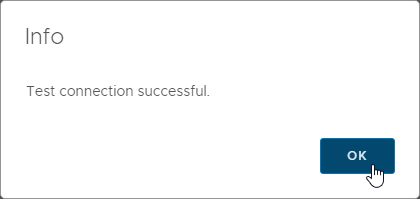
- At the bottom of the page, click Add.

vRealize Operations Manager 7.5 and older
Do the following to create and configure a Horizon Adapter:
- In vRealize Operations Manager, go back to Administration > Solutions > Configuration.

- On the right, in the top half, highlight the VMware Horizon solution.
- On the bottom right, highlight the Horizon Adapter and click the Configure icon.
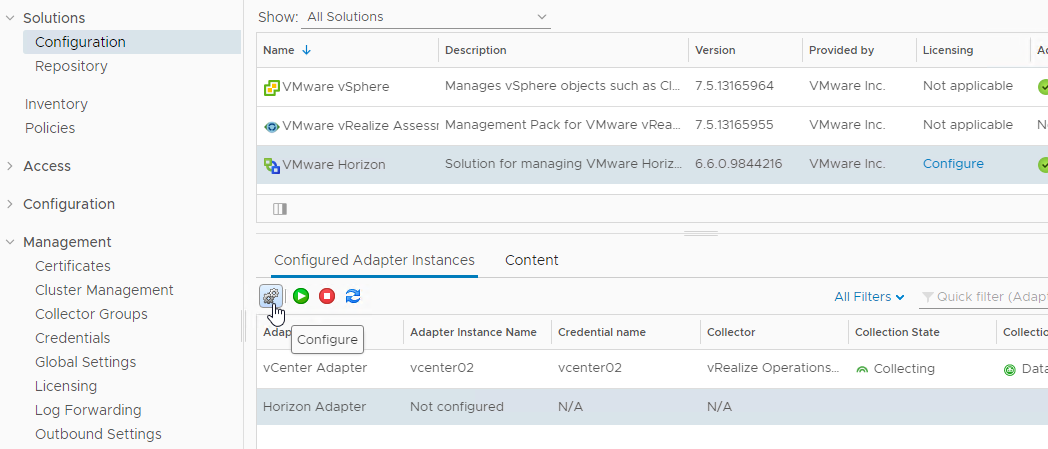
- On the top part, highlight the Horizon Adapter.
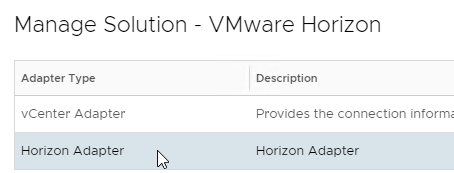
- On the bottom, give the adapter a Display Name, and an Adapter ID.
- Click the green plus icon to add a credential.
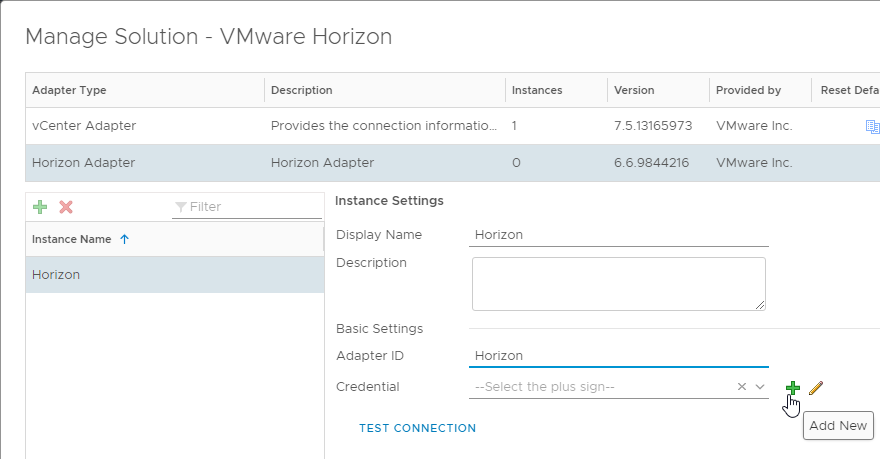
- Give the credential a name.
- Enter a new password (shared key), and click OK to close the Manage Credential window. You’ll use this password later when configuring the Broker Agent.
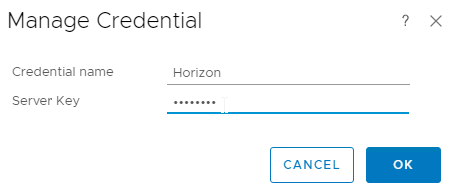
- Back in the Manage Solution window, click Test Connection.
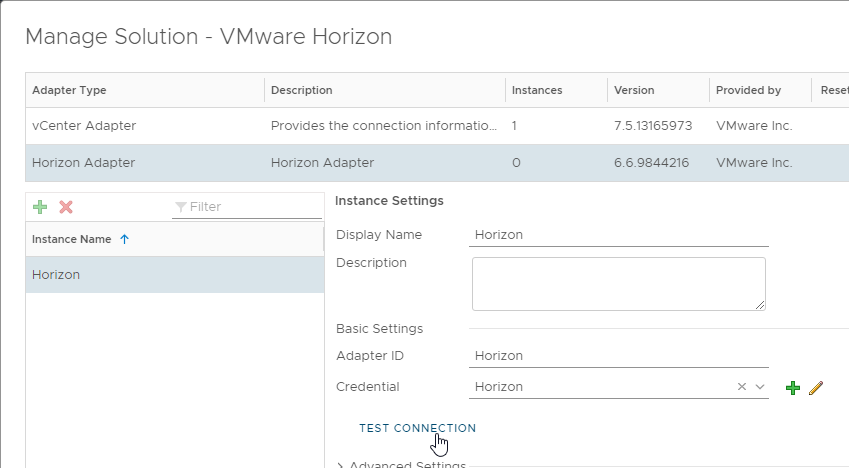
- In the Info window, click OK to acknowledge that the test was successful.
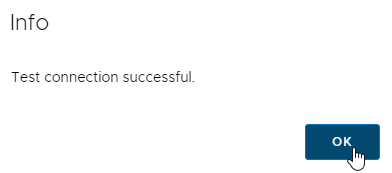
- On the bottom right, click Save Settings.
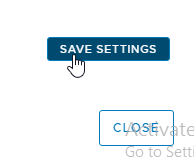
- In the Info window, click OK.
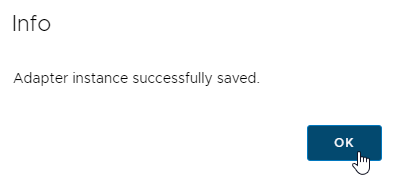
- Then click Close to close the Manage Solution window.
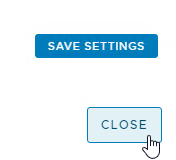
Enable SSH
If vROps 7.0 and newer:
- Point your browser to the /admin path at the vROps address.

- In the System Status page, in the row containing a node, on the far right is a slider to enable SSH.

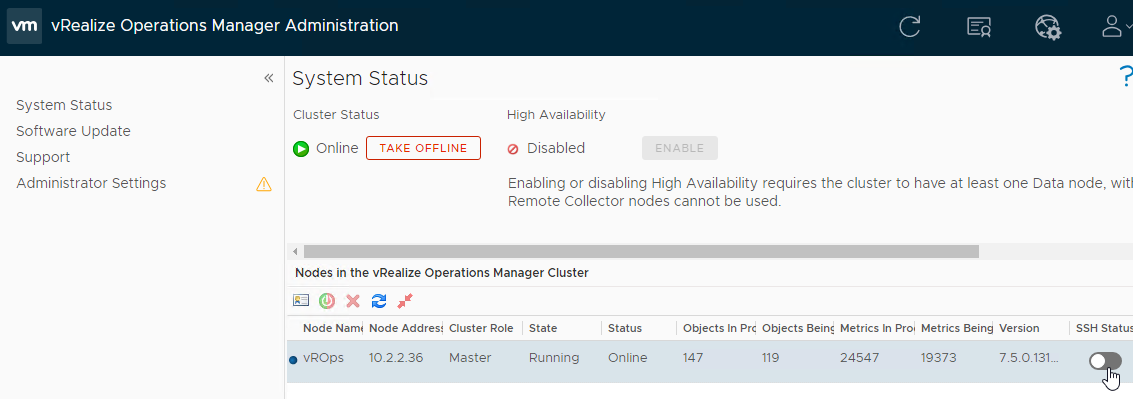

- SSH to the appliance and login as admin.
- When you su to the root account, the initial root password is blank (not defined) and you’ll be prompted to enter a new root password.
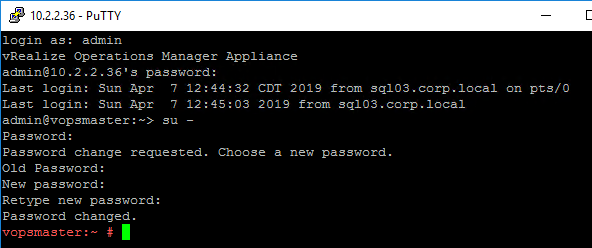
If vROps Manager 6.7 or older, see VMware Knowledgebase article – Enabling SSH access in vRealize Operations Manager 6.0.x (2100515):
- Connect to the vRealize Operations Manager virtual machine console.
- Press Alt+F1, and login as root.
Note: By default there is no root password configured. Just press <Enter>, and you’ll be prompted to enter a root password.
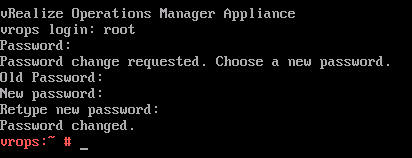
- Start the SSH service by running the command:
service sshd start
- To configure SSH to start automatically run this command:
chkconfig sshd on
Install Horizon Broker Agent
Only install the Broker Agent on one Horizon Connection Server in each pod.
- Log in to one Horizon Connection Server in your Horizon pod.
- Run the downloaded VMware-v4vbrokeragent-x86_64-6.7.1-15585151 or VMware-v4vbrokeragent-x86_64-6.6.0.exe.
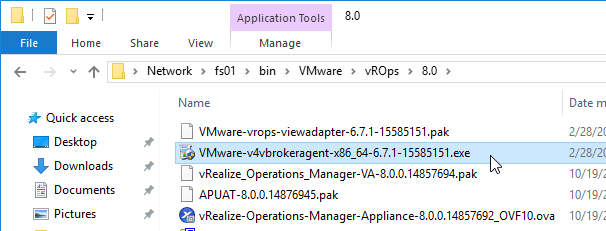
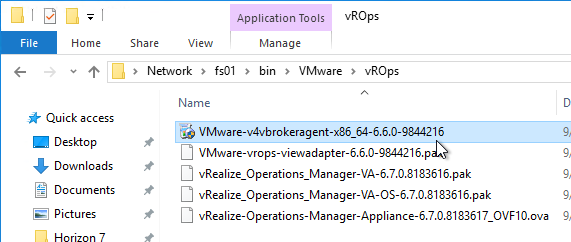
- In the Welcome to the VMware vRealize Operations for Horizon Broker Agent Setup Wizard page, click Next.
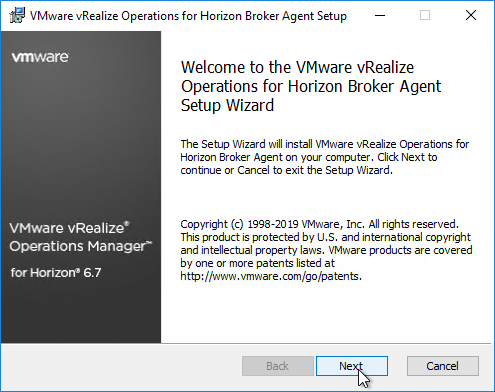
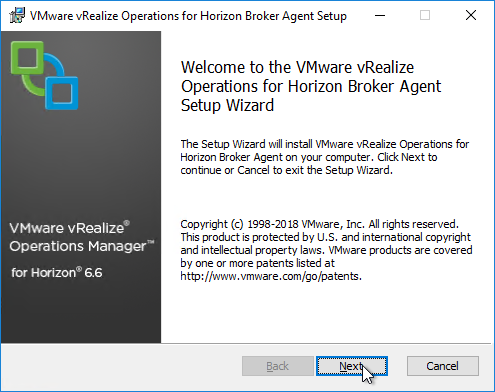
- In the End-User License Agreement page, check the box next to I accept the terms in the License Agreement, and click Next.
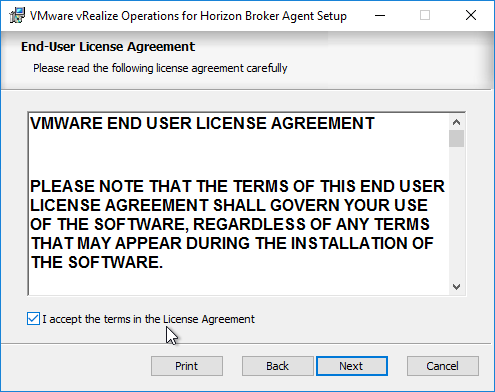
- In the Ready to install the Broker Agent page, click Install.
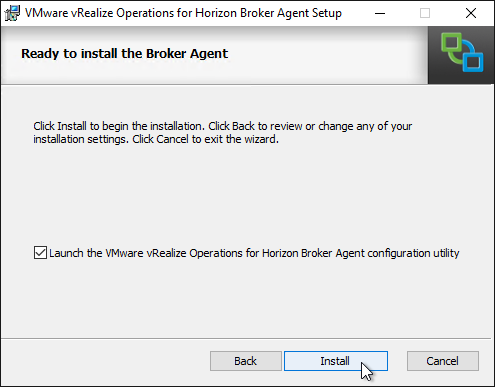
- In the Completed the VMware vRealize Operations for Horizon Broker Agent Setup Wizard page, click Finish.
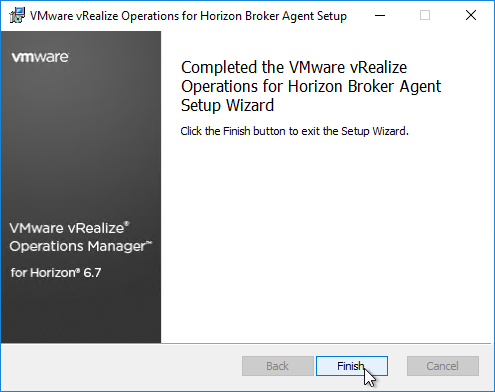
- The Configuration tool will appear immediately after installation. Or launch vRealize Operations for Horizon Broker Agent Settings from the Start Menu.
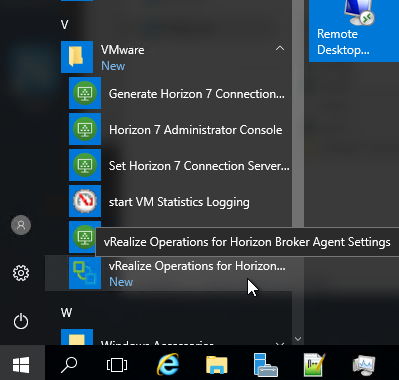
- In the Pair Adapter page, enter the IP address of the vRealize Operations appliance, enter 3091 for the port, enter the adapter password (configured earlier), and click Pair.
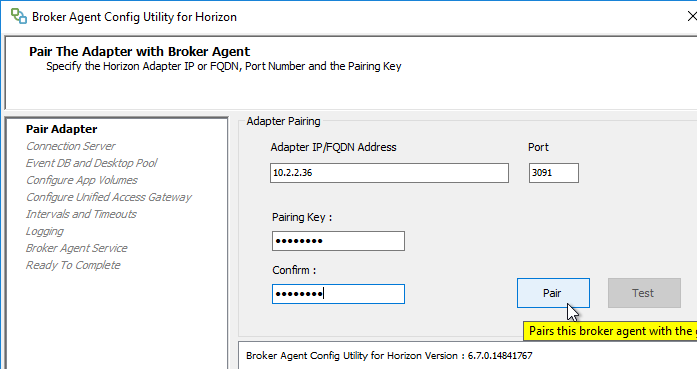
- After broker pairing is successful, click Next. If this doesn’t work, make sure the firewall ports are opened on the vRealize Operations appliance.
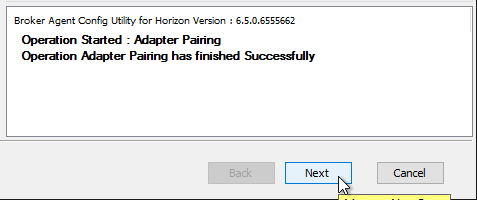
- In the Connection Server page, enter credentials for Horizon View, and click Test.
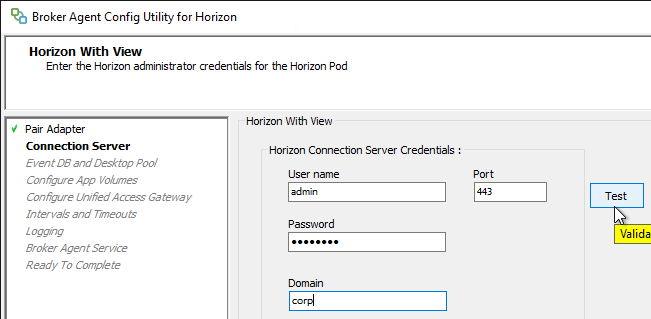
- Then click Next.
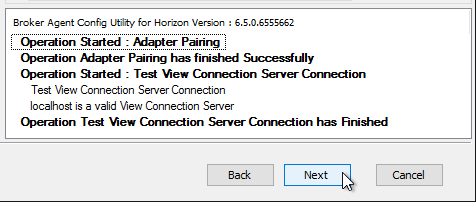
- In the Event DB and Desktop Pool page, enter the SQL credentials to access the Events database, and click Test.
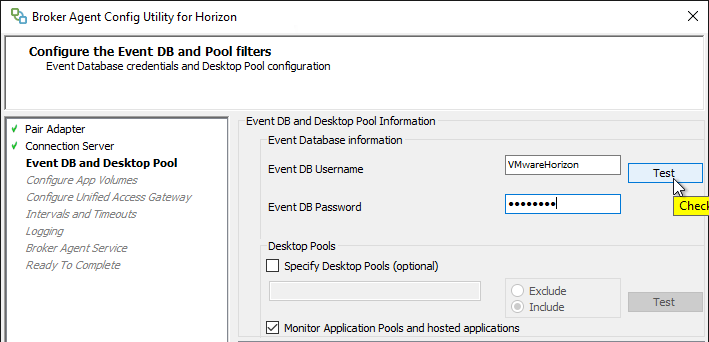
- Then click Next.
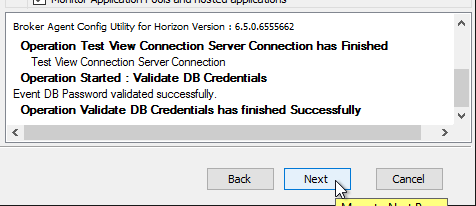
- In the Configure App Volumes page, enter the App Volumes info, and click Test. Click the plus icon to add it to the list. Then click Next.
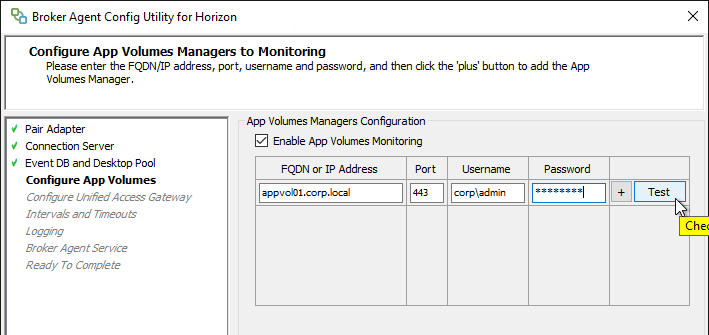
- In the Monitor Unified Access Gateway page, enter an appliance name, enter the UAG IP, enter 9443 as the port, enter the admin credentials, and click Test.
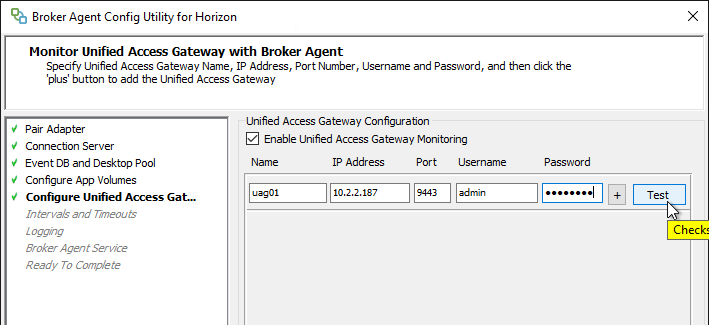
- Click the plus icon to add the Unified Access Gateway appliance to the list. Then click Next.
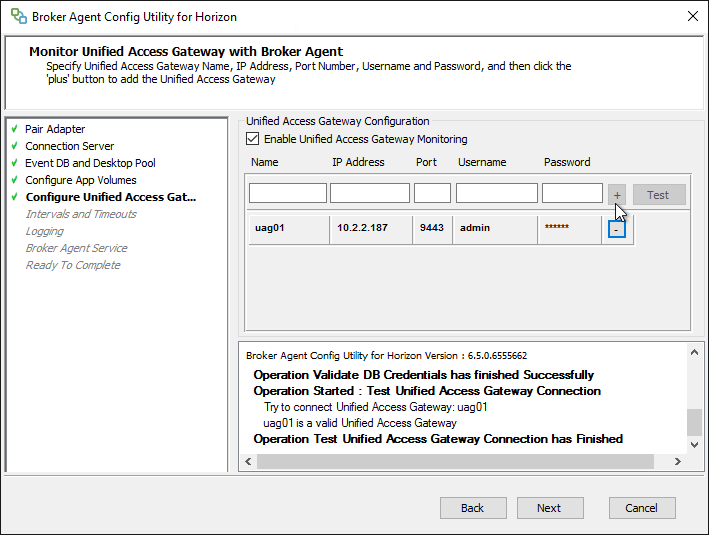
- In the Intervals and Timeouts page, click Next.
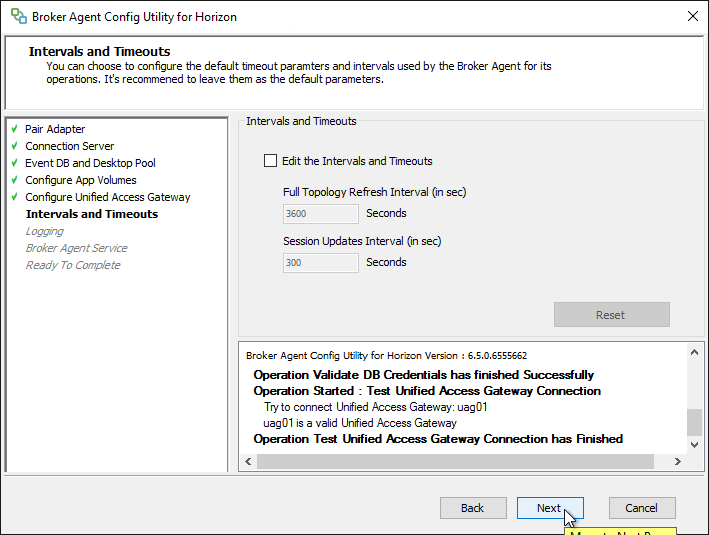
- In the Logging page, click Next.
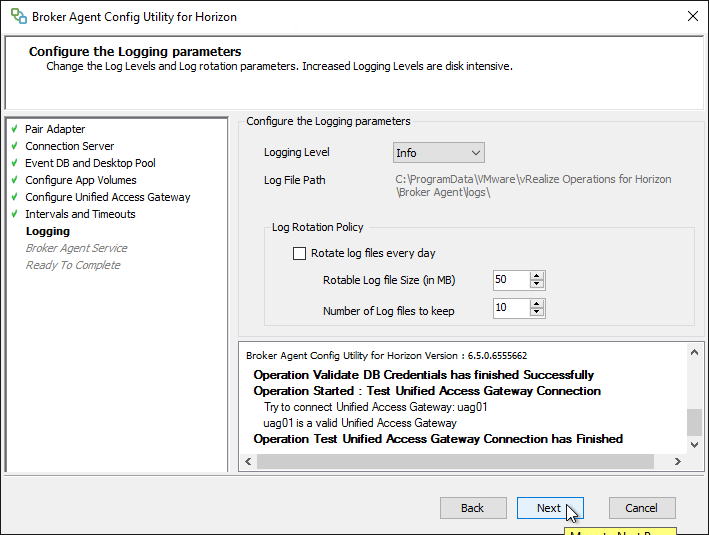
- In the Broker Agent Service page, click Start. Then click Next.
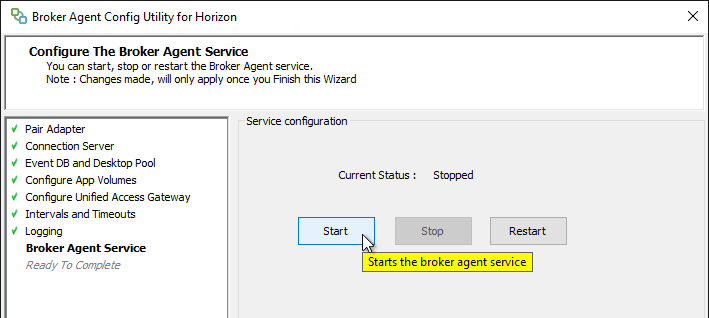
- In the Ready to Complete page, click Finish.
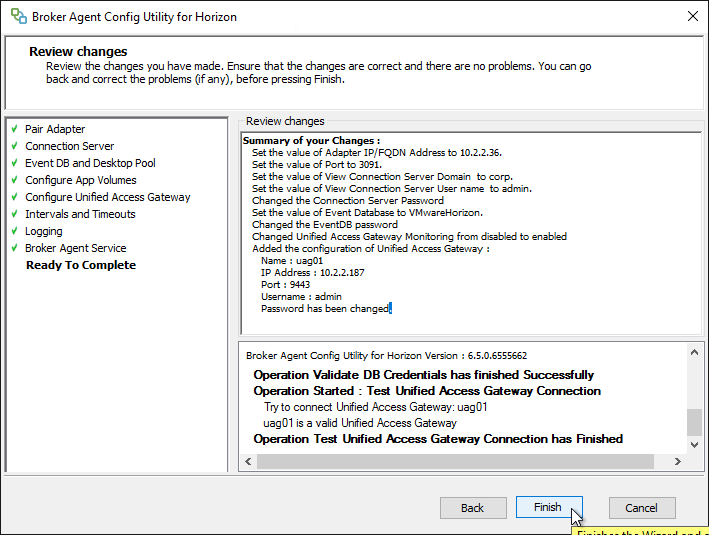
- In the vRealize Operations web console (/ui), from the Dashboards page, you can view the Horizon Adapter Self Health dashboard to verify that the adapter and broker agent are functional.
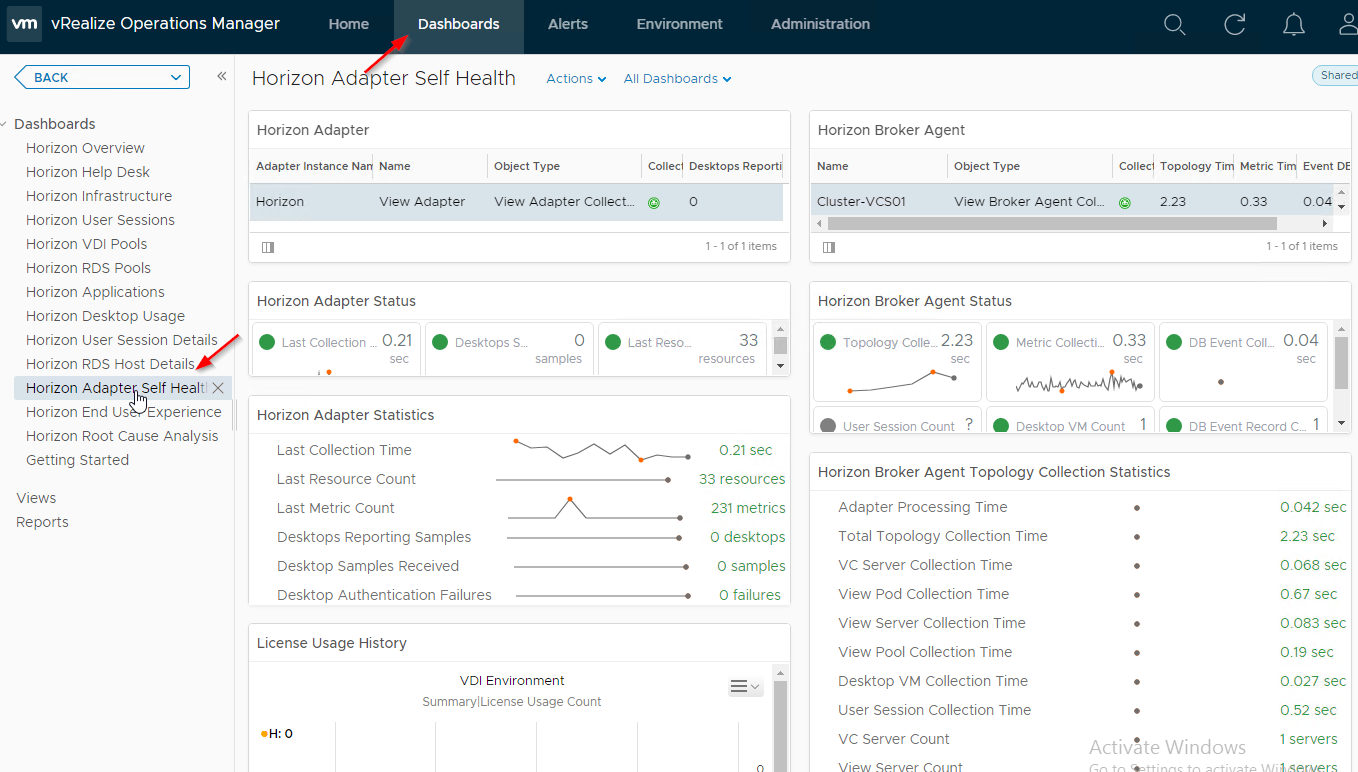
Use vROps for Horizon
Cameron Fore at Location analysis using vROPs for Horizon explains how to create Custom Groups per branch location and report (super metric) average latency for each location.
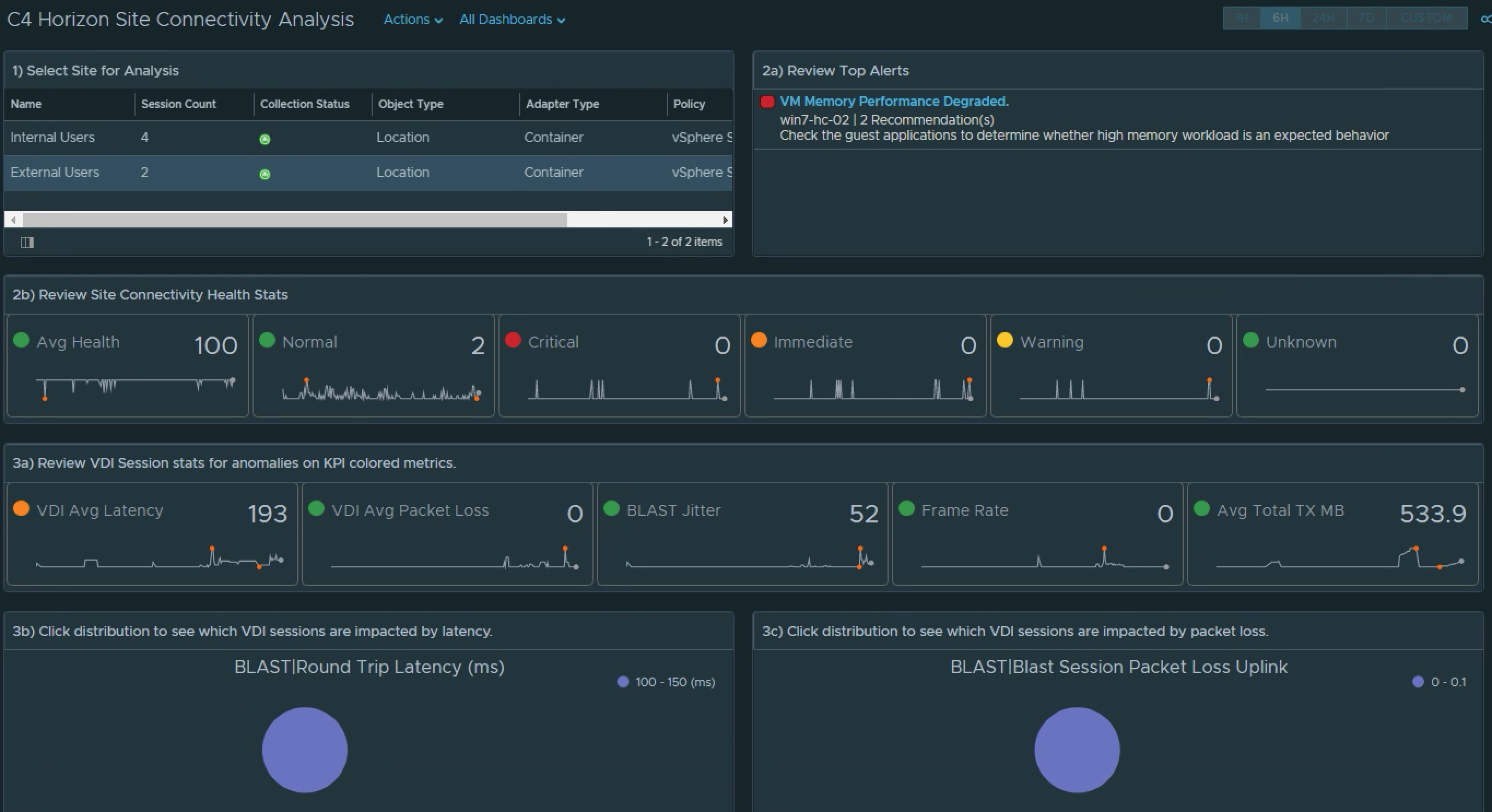
Cameron Fore at How to leverage Historic User Reporting in vROPs for Horizon 6.5 provides a dashboard to show Horizon User History.
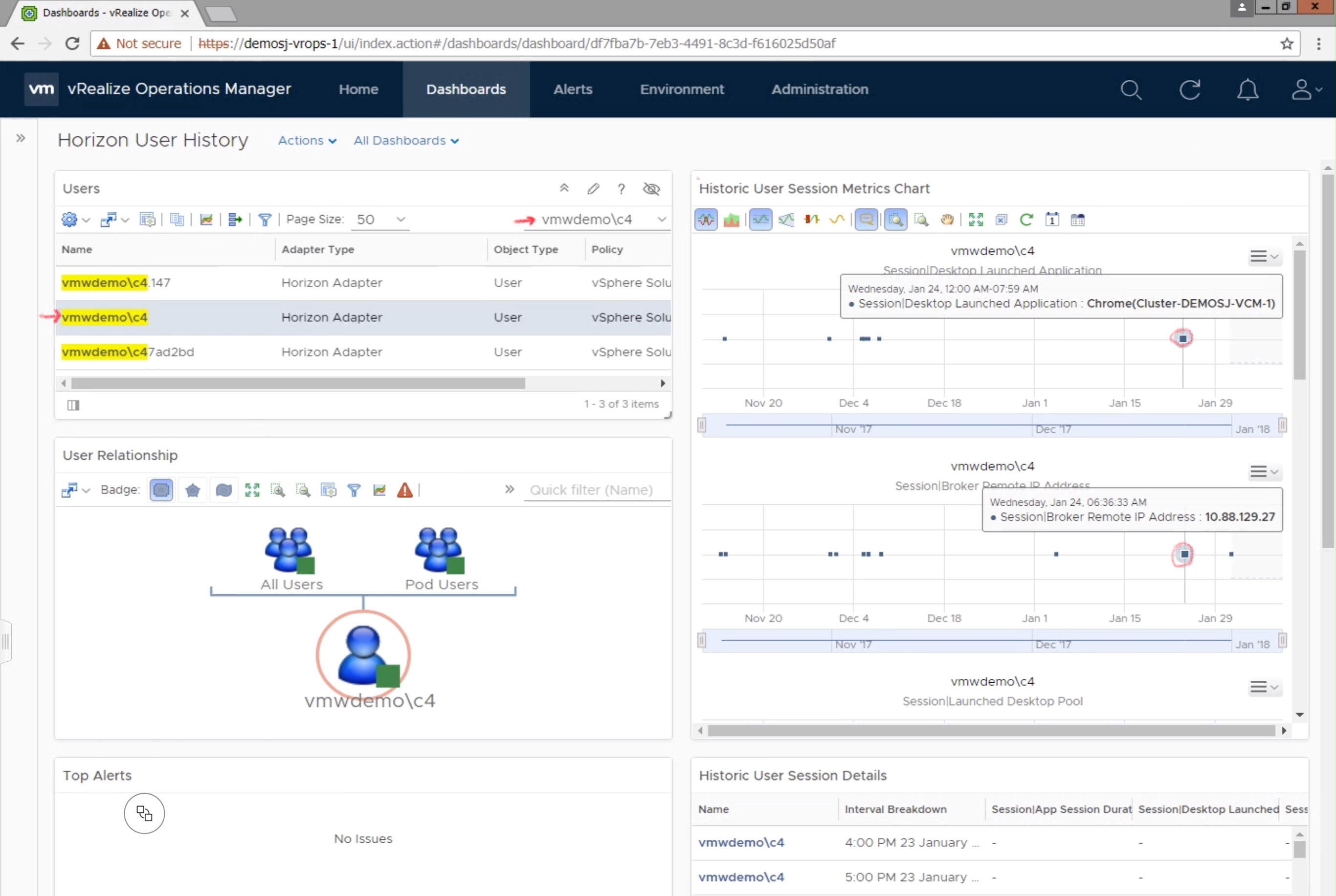
Related Pages






